The Saints Life
ST. STEPHEN'S AND ST. AGNES SCHOOL MAGAZINE



Every year, the seniors, freshmen, and Middle School students look forward to their bonding days. Through games, social activities, and teamwork exercises, they learn more about each other, leadership, and trust, while building relationships with their teachers in a fun and relaxed environment.



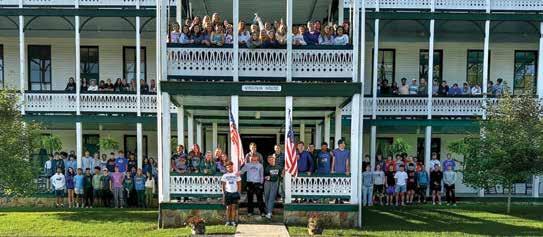



The seniors have a long and highly anticipated tradition of spending a weekend at Shrinemont. This year, the freshmen went to Bretton Woods for a variety of outdoor activities. The sixth grade went to Skyline Caverns to explore the caverns and go through a mirror maze, followed by a picnic lunch at Sky Meadows Park. The seventh and eighth grades went on overnight trips to Camp Horizons where in addition to bonding games and exercises, they rope and rock climbed, zip lined, canoed, did archery and caving, built fires and shelters, met some friendly animals, and played volleyball and basketball.
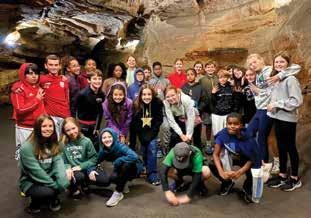
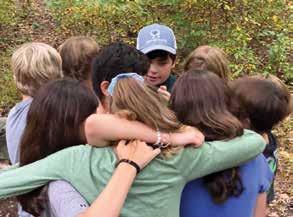



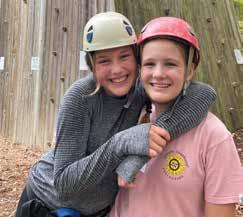






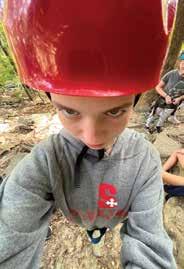

8 A TEACHER OF FAITH
Rev. Lloyd Alexander “Tony” Lewis '65

12 MAD FOR MADAGASCAR
Biologist Anne Yoder '77 was elected to the American Academy of Arts.
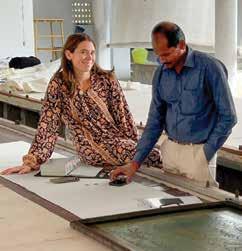
16 A CLEAN WATER SALESMAN
Conor MacNair '11 is an aquaculturist dedicated to raising sustainable shellfish.
20 A PERFECTLY PLATED LIFE
Courtenay Philbrick '07 loves pretty things.
24 “WILD WIN” FOR CLEOD9 MUSIC
Ian McLeod '09 and company win Best Original Score at the 2022 Jackson Wild Film Festival.
Textile designer
32 THE JOY OF SOLVING PROBLEMS
Greg Roland '12: Innovation Consultant
36 A HERO OF HOPE
Ellie Hanley '22 is honored by the American Kidney Foundation
54 A PILGRIMAGE TO JUSTICE
Reflections on the Alexandria Remembrance Project Pilgrimage.

60 SAINTS SERVING & CONNECTING
Students making a difference locally and globally.
68 JOINING OUR BOARDS
Meet the new 2022-2023 members of our Boards.
To help our students succeed in a complex and changing world, we seek to inspire a passion for learning, an enthusiasm for athletic and artistic endeavor, a striving for excellence, a celebration of diversity, and a commitment to service.
Our mission is to pursue goodness as well as knowledge and to honor the unique value of each of our members as a child of God in a caring community.
The magazine cover photo was taken by Middle School Math Teacher Jimmy Gerrity on the eighth grade bonding trip. STAY
St. Stephen's and St. Agnes Magazine
FALL/WINTER 2022-2023
Head of School
KIRSTEN PRETTYMAN ADAMS
Director of Communications
JEN DESAUTELS
Editor & Designer
Director of Design & Production
MELISSA ULSAKER MAAS '76
Director of Digital Media and Marketing
MANDI SAPP
Director of Brand Management and Marketing
MARCIA MALLETT
Alumni News
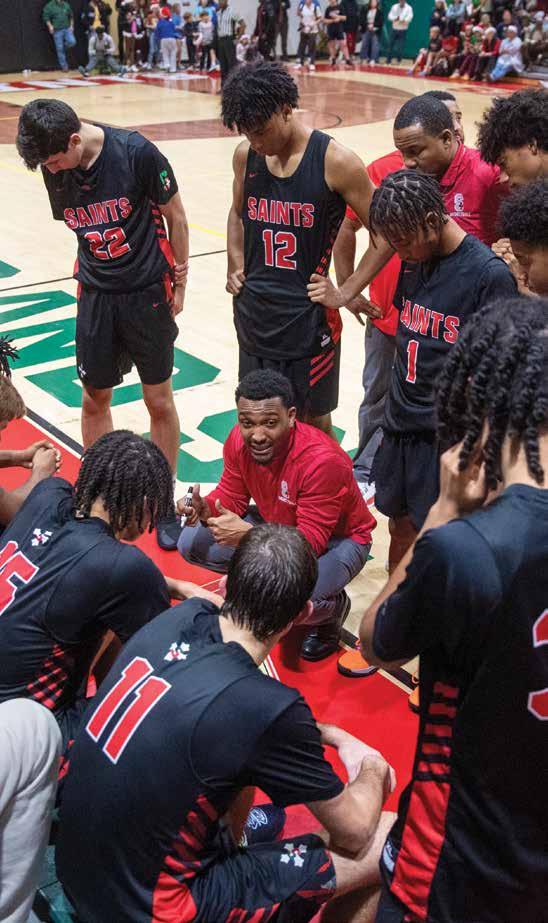
ADVANCEMENT OFFICE
Photographers
JAMESON BLOOM '13
MELISSA ULSAKER MAAS '76
MARCIA MALLETT
MANDI SAPP
OUR EXTRAORDINARY FACULTY
Contributing Writers ANDREA DAWSON
JESSICA YARMOSKY
SUSIE ZIMMERMANN
Questions/Comments
MELISSA ULSAKER MAAS '76 mmaas@sssas.org
To Update Your Contact Information or Mailing Preferences
Please email atoman@sssas.org or call 703-212-2720.
Published by SSSAS for alumni, current parents, friends, and other regularly supportive members of the school community. © 2023
St. Stephen's and St. Agnes School admits students of any race, color, religion, sexual orientation, national and ethnic origin to all the rights, privileges, programs, and activities generally accorded or made available to students at the school. It does not discriminate on the basis of race, color, religion, sexual orientation, national and ethnic origin in administration of its educational policies, admissions policies, scholarship and loan programs, and athletic and other school-administered programs. As a related organization of the Episcopal Church, St. Stephen's and St. Agnes School respects the applicable policies and governing principles of the Episcopal Church pertaining to nondiscrimination.
I have always felt, in that briefest of pauses between the end of and beginning of a year, an unguarded hope and joy for what the blank canvas of a new year will bring. Over the last few years, each turning point toward normal, each moment together, has filled me with that same hope and joy. Events and gatherings together as a community are things that we once took for granted, but now we see these celebrations and times together as the special gifts that they have always been.
At our annual all-school Thanksgiving service, it was the first time our community had gathered all together since 2019. I was overwhelmed with gratitude for each moment of that morning: the seniors pinning their kindergarten buddies with their angel pins, our choirs and instrumental groups performing beautiful music together, our united voices in prayer. This was a big moment full of little, special, tender moments, and my heart was full. The following is an excerpt from my homily that morning.
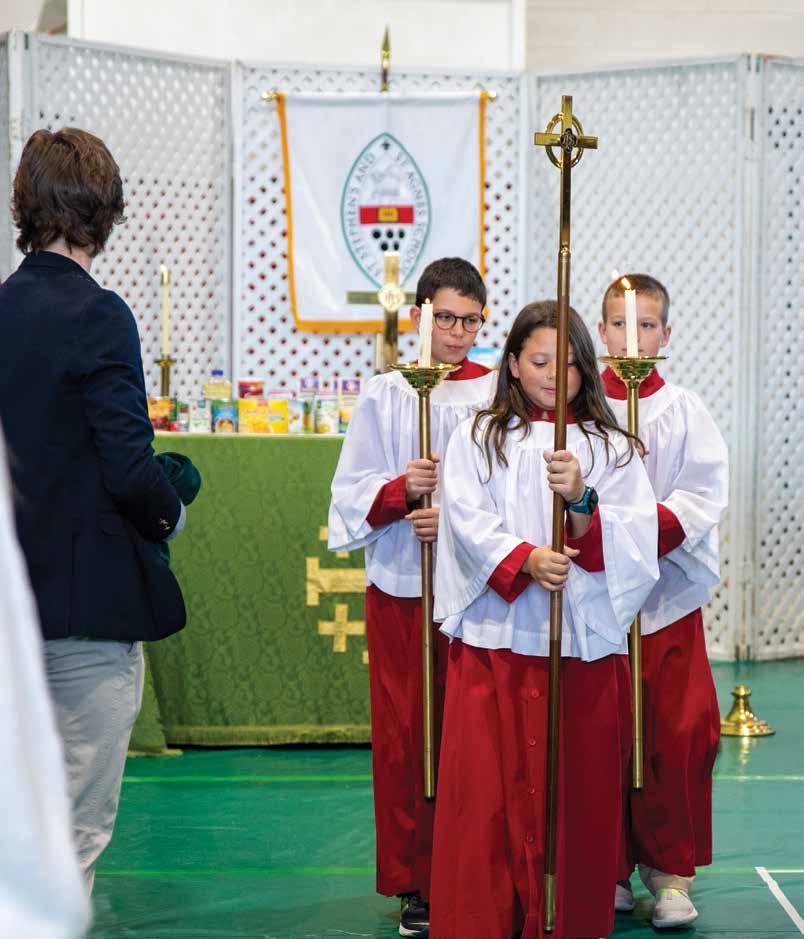
Go Saints! It is going to be a great year.
Warmly,
One of the things that I learned during the pandemic was to be grateful for the small things– being able to see friends, strolling through HomeGoods even if I did not buy anything, eating a nice meal out at a favorite restaurant, sitting in the audience for a performance or an athletic contest. I am also grateful for all of the small things in our school. I am thankful for seeing you arrive in the morning to school–especially our Lower Schoolers who skip with joy into their classrooms excited to start the day. I am thankful to hear you making too much noise in the hallway. I am thankful to see you cheering on the sidelines—I am thankful that in our community, students say hello, hold the door for each other, and help each other with their homework. I am thankful that our students say thank you.
Many think we should strive for a life of grand gestures like saving someone's life or giving thousands of hours of service or serving as school president– and yes we should strive for these things, but today I want to talk about those smaller gestures. Those small things we do every day that help to make others feel important and like they belong—you never know how much you will impact someone. You've probably heard the quote by Maya Angelou, “I've learned that people will forget what you said, people will forget what you did, but people will never forget how you made them feel.”
I want to tell you a story of a very small moment that I will never forget. One of the things I love to do is to travel, and I have had the chance to fly a lot for my job and in my personal life. When we get on the plane, my family tries to avoid sitting next to me. You might think
it is because I talk too much or snore too loudly, but rather it is because I still am a nervous flier. Whenever there is turbulence and every single time that we land, I grab on to my husband's or children's hand and hang on for dear life.
I also fly a lot by myself for work to visit our amazing alumni around the country. You will find me grabbing onto the arm rest, and listening to a podcast or closing my eyes until we are safely on the ground. Once while flying by myself, the pilot got on the intercom and welcomed us to our flight and warned us that it would be bumpy
to her and her simple question led to an hour-long conversation with her holding my hand. I have no idea what we talked about. It was nothing profound or pithy, but instead of turning on her headphones and ignoring me, she distracted me for the rest of the flight and we landed safely back in Washington. I have never forgotten how my seat mate made me feel, even though I do not know her name.
In today's psalm, we heard “Enter his gates with thanksgiving; go into his courts with praise; give thanks to him and call upon his Name.” While certainly this could be asking us to preach God's gospel and share the good news, I also think “give thanks to him” is another way of saying “go into the world and treat those around you with gratitude and love for their gifts. Make them feel like they belong.” I truly believe that my seatmate on the airplane was living her life as God asked. God puts people in our lives to help us along our journey.
as we took off. I wasn't too worried as I thought it would just be a few bumps until we got above the clouds, and we would level off. Unfortunately, I was in the way back of the plane and the turbulence was the worst I had ever experienced. I was terrified. Tears streamed down my face, and I gripped onto the armrests so hard that I was sure they were going to break. I just kept waiting for the turbulence to stop. It went on and on, and I started making deals with God about keeping us safe. Over the noise of the plane engine, my seat mate asked me, “Dear, is this your first time flying?” If I was not so freaked out, I am sure I would have been embarrassed as I had flown many times. Luckily, I turned
Sometimes we are put into people's lives to help them along the journey. One of the ways in which our community helps is by collecting supplies for those in need and creating blessing bags. While the food or toiletries or other items are extremely important, I also believe that the notes, pictures, and drawings that we place inside of the bags are just as important. They say to the individual or to the family receiving the items, “We see you. You belong. You matter.”
You wield great power in this world, and I encourage you to use it for good. Please remember that you are loved. You belong here at SSSAS. We are so grateful to you and all of the big and small things that you bring to our school community.
“I've learned that people will forget what you said, people will forget what you did, but people will never forget how you made them feel.”
~Maya Angelou
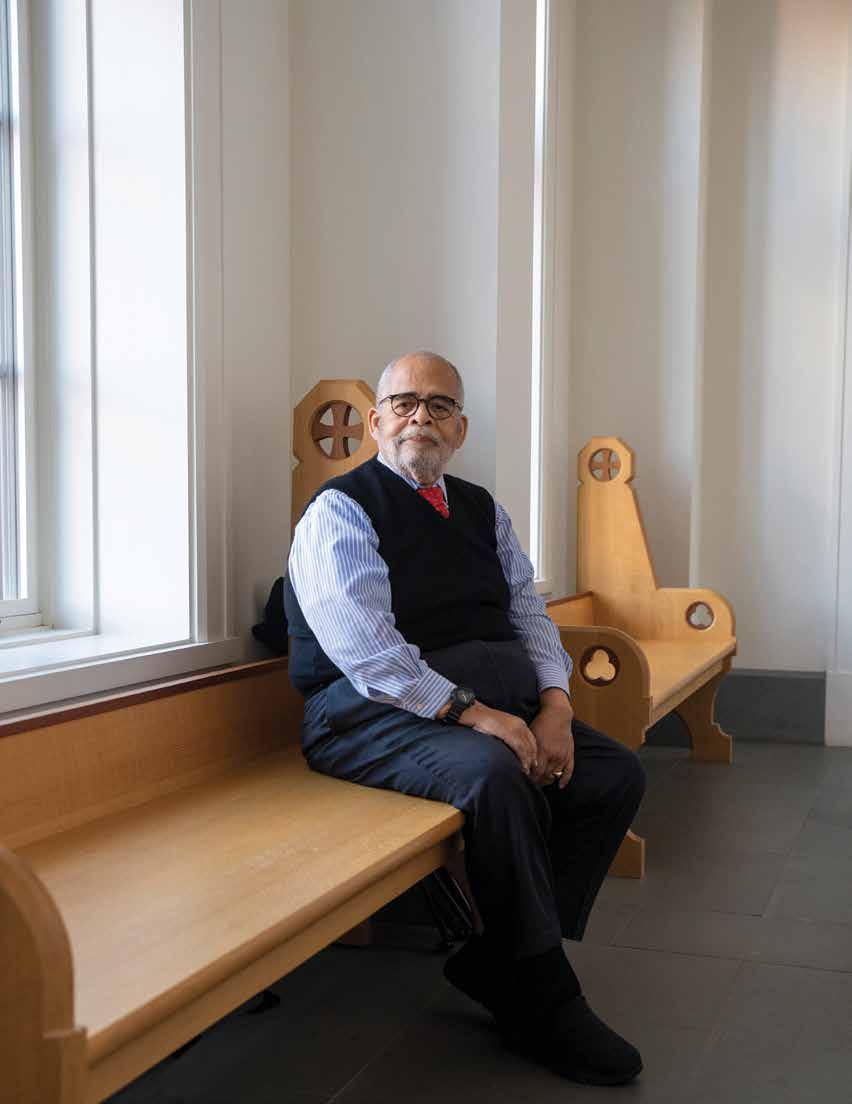 BY ANDREA DAWSON
BY ANDREA DAWSON
It was early September, 1961, when the Reverend Lloyd Alexander “Tony” Lewis, Jr. '65 arrived at St. Stephen's Upper School entrance, wearing a coat and tie and a hint of freshman apprehension. His matriculation was auspicious. It not only marked the beginning of a high school journey that would launch him into a life of ministry and distinguished scholarship; as the first Black student to attend the school, his arrival also marked the beginning of integration at St. Stephen's, the very first church school in the Episcopal Diocese of Virginia—indeed, among the first private schools in all of Northern Virginia—to put an end to segregation.
More than 60 years later, his framed St. Stephen's diploma is proudly displayed on his bedroom wall. A local newspaper article, taped to the back, serves as a reminder of his first day.
“St. Stephen's School of Alexandria admitted its first Negro student this fall as quietly as possible,” reads the first line. At the time, the phrasing struck him as curious. Just a few blocks away, Hammond High School was also in the midst of desegregation, but it was not quiet. It wasn't until several years later that he would learn, from a few high school friends, the full implication of the wording—and why his arrival, indeed his entire St. Stephen's experience, in a southern city mired in the politics of the time, was so oddly uneventful.
One gets the sense that quiet, impactful achievement and purpose have driven the way Tony Lewis, now 75, has lived much of his life. After St. Stephen's, he would go on, with little fanfare, to become the first African American from Alexandria to be ordained into the Episcopal ministry, and one of the first to hold a faculty position at the Virginia Theological Seminary, where he was also a student.
“Somebody has to break the ice. Where I was at various points in my life I got to do some ice-breaking. It wasn't something of which I was particularly conscious. It wasn't something my parents and I discussed at the dinner
table,” he recalls. Bookish and focused from a young age, his central concern when he arrived at St. Stephen's: getting a good education. And figuring out what, if anything, was meant by this nudging feeling he had about wanting to pursue a life calling that originated in his faith.
nearby, already-integrated Burgundy Farms Country Day School.
Unsure of his path—his parents steered him towards becoming a doctor—but drawn ever closer to the idea of becoming an Episcopal priest, he walked into the office of Headmaster The Rev. Emmett H. Hoy
An only child growing up in Alexandria, Tony's father was a funeral director and his mother served as the administrative assistant to the principal at the Black public high school, Parker-Gray. Church figured centrally in his childhood. So did the sense of community and service that arose from it. “I can not think of a time when church was not part of what I did and who I was. For a lot of us who are African Americans, the church really provided a context for being able to live,” he says.
He remembers Mr. Hammond, a house painter and his Sunday School teacher, piling a classful of rambunctious boys into his station wagon on Sunday mornings to deliver orange sherbert to elderly parishioners. “What he modeled was that the church does not see itself as something that's confined to four walls but something that has a far wider influence—not only on one's own life but also on people in the community.” That expansive notion of the church and the potential of its influence stuck with Tony. It was on his mind when he got to St. Stephens, following a primary education at the
(1955-1975) one day. “I have this feeling about something, and I wonder if you could help clarify it for me,” he remembers asking him. Dr. Hoy was pleased, but practical. His response, as Tony recalls: “Go off and be an undergraduate. Drink as deeply of that water as you possibly can. If after four years this gnawing thing is still there, we'll talk again.”
So, Tony headed to New England, where he took in all that was offered by its vastly different culture and the academic challenges of Trinity College. After four years, as one of only three Classics majors in his graduating class, the “feeling” remained. His junior year, he attended the Bishop's Advisory Conference for Applicants for the Ministry (BACAM) in Richmond, an annual conference that helps those considering priesthood decide if the vocation is right for them. By coincidence—perhaps providence— the academic advisor assigned to him was Dr. Hoy. A deeply personal, introspective exercise, the work of the conference was not to be undertaken with an acquaintance, much less
“
One side of being a religious community is to be a prophetic community, to be open to saying what's going on in the world, and to speak the truth in love in places where the truth needs to be heard. St. Stephen's and St. Agnes, which sees itself as having an influence on all conditions of people, has done so consciously and bravely.
F Like all St. Stephen's boys at the time who took English with Willis Wills, Tony was made to memorize the prologue to Chaucer's The Canterbury Tales, a secret handshake, of sorts, for identifying others who attended the school. He can still recite it by heart.
F Fascinated by languages, Tony teaches Greek, Latin, and Biblical Hebrew; reads French and German; and dabbles in Spanish and Dutch.
F From an early age, Tony was—and remains—an avid pianist. In high school, he earned entry into a program run by Howard University's Department of Fine Arts where, twice a week after St. Stephen's classes, he studied with their piano faculty. His graduation from St. Stephen's coincided with his completion of the program, earning him a certificate in musical theory and piano performance.
F Thanks to his mother's position at the nearby public high school, Parker-Gray, Tony was “something of an amphibian,” he explains. “As I went through grade school and then high school, I had my foot not only in whatever independent school I went to but also in the public school system in Alexandria. It meant that I was always doing both in terms of the racial environment in which I was living and learning.”
one Tony so greatly admired. Neither seemed to care. “Shall we tell them?” he remembers Dr. Hoy asking him, a twinkle in his eye. “No!” his student replied.
Not long thereafter, Tony's course was set. He returned to Alexandria and the Virginia Theological Seminary (VTS), just blocks from St. Stephen's, to earn his Master's degree in Divinity. Two days after graduation, he was ordained a deacon; six months later, on Dec. 2, 1972, he was ordained a priest, only the second alumnus from St. Stephen's at the time to be ordained.
His passion for scholarship and teaching remained strong. So did his interest in developing students for pastoral ministry. Unlike teaching at a college or university, being an academic in a seminary would allow him to pursue both. But first, he knew he needed on-the-ground training.
After ordination, he relocated again, this time to Bedford Stuyvesant, Brooklyn, where he served for two years as a full-time parish minister at St. George's Episcopal Church. After years of classroom study and research, it was a formative experience, one that crystallized his decision to pursue teaching in a seminary setting. “If I was going to help form people for parish ministry, it made sense for me to have the experience of being a parish minister,” he reflects. “You want to know what people are going to face before you teach them.” Even now, in a state of semi-retirement, parish connections are essential to Tony.
In the fall of 1974, he returned to Connecticut to further his studies. Harvard as well as Union Seminary in New York City accepted him into their graduate programs, but he chose Yale for the reputation of its doctoral program in Biblical Studies.
At the end of four years—and three summers spent holed up in steamy Yale classrooms learning French and German, in addition to the Latin, Greek, and biblical Hebrew he already knew so that he could decipher ancient texts— VTS came calling. They were intrigued by the direction of his scholarship
and keen on wooing him back to their campus to teach (he completed his dissertation in New Testament Studies in 1985). FFFFFFFFF
VTS was not the only school that wanted Tony. At the time, among the Episcopal seminaries across the U.S., only two other Black faculty members served in a full-time capacity. He would be the Seminary's first. “I suppose I was a rare bird. But I felt that it was important for me to come back to the school that had been my educational starting place, and to give back what I had been given.”
As a newly formed professor all too familiar with the heady complexities of biblical studies, he also felt it was important to pay it forward. At Trinity, he remembers struggling to learn Greek participles. The head of the Classics Department worked patiently with him, drilling him on the nuances of their meaning until he got it. In similar fashion, students often passed through his office at VTS, where he taught, among other subjects, Pauline literature and theology, the Gospel of Matthew, first-century slavery, and yes, Greek participles. He delighted in the moments when, after his careful instruction, comprehension flashed across their faces. “Being a teacher is a lot like being a priest,” he remarks. “Both live to see that Ah ha! moment in people's eyes.”
Over the course of a combined 25 years on the faculty of VTS—in 1990 he left for a decade to serve as Dean of the George Mercer, Jr. Memorial School of Theology and the Bishop's Deputy for Education in the Episcopal Diocese of Long Island—Tony came to covet two other Ah ha! moments: officiating at baptisms and presiding over marriages. For him, the act of stepping across a border, of self-reflection and insight, was, and is, pure joy to witness. “Watching people learn what it means to claim faith not as something that belongs to their parents, but rather something they can claim as their own, that's an Aha! moment for me.”
Ten years after retiring from VTS, Tony has hardly shed his mantles as educator and priest. Nor does he have plans to. Every Thursday and Sunday he participates in services at St. Paul's Church in Foggy Bottom. He lectures and teaches adult education classes in parishes up and down the East Coast, including, recently, the Church of Saint Mary the Virgin, in Times Square. And then there's Zoom, which has provided him with a delightfully unexpected medium for reaching a broader audience.
“I can sit in my bedroom wearing a clerical shirt and sweatpants and teach in Rochester, New York and California, all in the same day,” he jokes.
Teaching, preaching, listening, and learning—the ongoing search for meaning and understanding in a community of equals—continue to propel Tony's life and work. In their own way, they were messages that were quietly but boldly modeled by Headmaster Hoy and others who taught him from the very first day he arrived at St. Stephen's that September morning in 1961.


Unknown to Tony at the time of his landmark enrollment was the underlying tension that surrounded it. While he more than qualified academically, St. Stephen's School Board disagreed on whether or not to admit a Black student. So committed was Headmaster Hoy to the integration of the school that, when the Diocesan trustees met to discuss Tony's application and ultimately overrule the Board, he had tucked in his pocket a letter of resignation, ready to furnish if the decision had gone the other way.
Similarly discreet, behind-the-scenes gestures involving students, parents, and faculty alike—notifying them of the school's imminent integration—paved a path for Tony. (In his 2009 graduate school thesis on the integration of southern Episcopal schools, Wade H. Morris, Jr., a former history teacher at St. Stephen's, recounts Headmaster Hoy calmly explaining to a parent and prominent anti-integrationist that he was welcome to withdraw if he disagreed with the school's position.) Though he never once spoke of these actions, their impact on Tony's experience at St. Stephen's, not to mention the trajectory of the school in the decades to come, was seminal.
“Emmett Hoy really exhibited in my mind the best of what it meant to be part of the Episcopal Church in Virginia,” Tony says. “He was committed to what his faith taught him about being a human being and a child of God. He was so much a part of the school's change of direction and heart at that time, my role was incidental in many ways. I just got up that September and went to a new school.”
Up until Dr. Hoy's death in April of 1975, Tony—his former student-turned-close-colleague—felt privileged to pay him regular visits. Integrity, purpose, and gratitude were themes that arose in their conversations until the very end. They are themes Tony continues to lean on, lean into, and teach. “To me, the most important message is that there is a good deal that one can be happy about. So many things today seem to be causes of angst. There is happiness to be had in the joy of learning just like there's happiness in the joy of believing.”
Biologist Anne Yoder '77 was elected to the American Academy of Arts for her extensive and distinguished research devoted to understanding how the varied forces of climate, geography, genetics, and ecological interactions have converged to generate the unique and incredibly diverse biota of Madagascar.
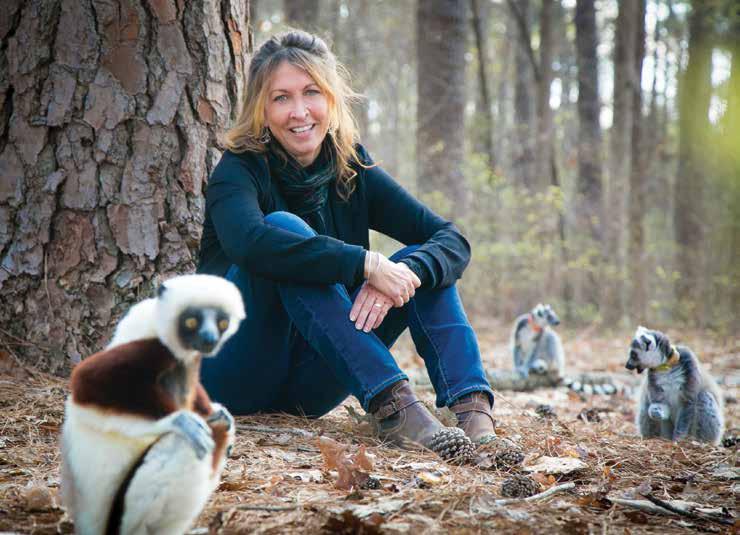 By Susie Zimmermann
By Susie Zimmermann
Anne Yoder studies evolutionary biology and conservation threats to the biodiversity in Madagascar. This highly specific niche, which has opened a world of inspiration and passion for this Saint alumna, was reached through much hard work as well as three guidepost events in her early adult years.
As a zoology undergrad at the University of North Carolina Chapel Hill, Anne toured the nearby Duke University Primate Center. She was impressed with the evolutionary diversity of lemurs, and that sparked an interest.
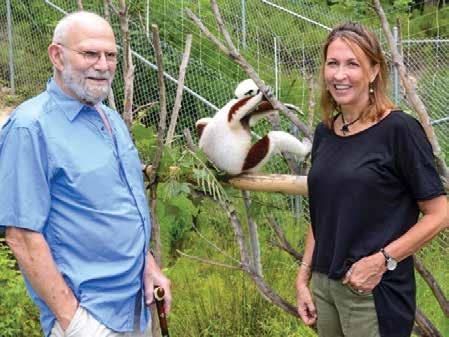
After graduation, she returned to the Washington, D.C. area to work at the Smithsonian Natural History Museum. She interacted daily with scientists and evolutionary biologists, attended seminars, and “knew I'd found my community of professionals,” she recalls. This was the second 'click' indicating to Anne what she was meant to do.
Then, while at the Smithsonian in 1986, two curators financed an opportunity for Anne to travel alone to Madagascar to study the island's birds and rodents.
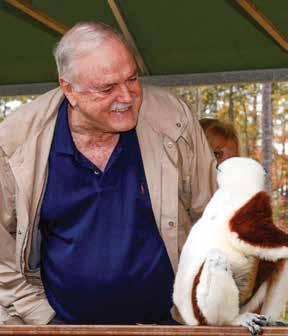
“I was mad to go to Madagascar,”
Anne says, laughing at her own pun. When she arrived on the island after a 48-hour journey, she found a country much more remote than it is today. She quickly became enthralled with the people, the island's scientists, and the amazing biodiversity. “I have been focusing on that ever since,” she says.
Madagascar is home to approximately five percent of the world's biodiversity, with 80% of those organisms unique to the island. This makes Madagascar a sort of speciation lab and ideal testing ground for conservation methodologies. Anne's focus is the study, preservation, and conservation of the unique biodiversity found there. The Yoder Lab at Duke University, where she is also the Braxton Craven Distinguished Professor of Evolutionary Biology, specifically examines the diverse lemur population on the island. Her investigations uncover assorted geographic factors that lead to biological differences in speciation and utilize genome research to further understand this complex and unique speciation within Madagascar's lemur populations.
After her early work at the Smithsonian, Anne returned to North
Carolina for a doctorate in biology from Duke in 1992. In the following years, she was a postdoctoral fellow in Harvard University's environmental biology program, and then taught at Northwestern and later at Yale. During her time at Yale, she also was the associate curator of mammals at the Peabody Museum of Natural History.
Anne returned again to North Carolina to become a professor of biology at Duke's Trinity College of Arts and Sciences in 2005. The next year she became the director of the Duke Lemur Center (the renamed Primate Center that had sparked her interest as an undergraduate). The center houses 18 different species of lemurs and more than 250 specimens. During Anne's 12-year tenure leading the center, she guided its expansion adding animal housing facilities, doubling its research activity, and opening its doors to thousands of visitors each year. One of her accomplishments included the launch of the center's SAVA Conservation project, based in northern Madagascar, which aims to protect lemur lives and habitat by improving human lives through education, fish farming, tree planting, and healthier cooking stoves.
Anne stepped down from her leadership role at the Lemur Center in 2018 to focus full time on her research and teaching. She balances teaching evolution and genetics to undergraduates and grad students with her own research.
The National Science Foundation recently announced plans to fund new Yoder projects for speciation genomics and conservation outreach in Madagascar.
She hopes to return to the island nation in 2023 to begin testing DNA bar coding for field genomics to identify organisms in the field. Anne plans to include Malagasy scientists in her work and teach them about this methodology.
While she remains interested in all vertebrates, Anne is still enthralled most by the lemurs of Madagascar and the example they provide of Darwinian evolution. Her research has led to more than 100 research papers in scientific and academic journals, as well as seminars and presentations to scientific gatherings around the world. She also maintains a website, The Yoder Lab, that includes updates on her research and findings.
In 2021, Anne was elected to the prestigious American Academy of Arts and Sciences. Each year, the Academy honors exceptional scholars, leaders, artists, and innovators and engages them in sharing knowledge and addressing challenges facing the world. The 2021 class of new members was selected to recognize “the excellence of these individuals, celebrating what they have achieved so far, and imagining what they will continue to accomplish,” said David Oxtoby, the president of the Academy. Speaking of the class elected after a tumultuous year of COVID-19, racial reckoning, and political unrest, he said, “The past year has been replete with evidence of how things can get worse; this is an opportunity to illuminate the importance of art, ideas, knowledge, and leadership that can make a better world.”
Looking back at her St. Agnes days, Anne fondly recalls English teacher Norma Smith, for developing Anne's interest in learning. “Ms. Smith was the first teacher I had who made learning genuinely fun,” she remembers. Anne's years at St. Agnes were challenging and developed in her an emotional maturity and focus that were helpful at UNC. “I would not have survived as a college student without that experience,” she says.
While her work is extremely busy, she enjoys time with her husband, journalist and writer David Michael Hart. She also proudly speaks about her 22-yearold son, Dylan, a recent graduate of Appalachian State, where he was a track and field athlete, math major, finance minor, and recently began working in the solar energy field.

With all of Anne's contributions to her field, she still has several goals to achieve, including completing two scientific projects.
The first in cryptic speciation uses genomic approaches to understand what cannot be observed, and the second explores the spontaneous mutation rate that occurs from parent to offspring. This “engine of evolution,” as she describes it, “is critical to life on
earth but very difficult to measure.”
Anne's third professional goal is to return more regularly to Madagascar to embed in its academic and conservation community.
“Habitat destruction is still a problem there,” she explains. “The people are so poor and don't have resources, but the silver lining is that academic, scientific, and conservation communities have flourished among the Madagascar people, so decolonizing conservation is well on its way. It's an amazing progress but still there is much to do among desperately poor people to feed their families who still rely on deforesting to make fire and to grow crops. It's hard to justify saving lemurs in that situation, making the situation a human crisis as much as a biodiversity crisis.” Raising money to address this situation is the focus of much of her work today.
Given the challenges ahead, Anne has no plans to retire. “I don't know what I'd do with myself,” she says. “It's my vocation and avocation. I fell in love early with science and followed that path always, without ever a moment of doubt. Science has been the backbone of my life and provided a level of joy in my work that has gotten me through so much!”
Lemurs live on the island country of Madagascar off the west coast of Africa in the Indian Ocean. The lemur super family includes ring-tailed lemurs popularized by the “Madagascar” film franchise, and the peculiar aye-ayes.

According to the International Union for the Conservation of Nature (IUCN), there are 113 known lemur species, with the potential for more to be discovered. Indri is the largest lemur species, and can grow to between 24 and 35 inches long and can weigh up to 22 lbs. (Zoological Society of London (ZSL)). Lemurs often have long tails, but indris are the only species to not have one at all.
The smallest lemurs—and the smallest primate in the world—are Madame Berthe's mouse lemurs. These lemurs grow to just 3.5 to 4 long excluding their tails, which add another 5 to 6 inches (12 to 14 cm) to their length. Thesse tiny lemurs only weigh an average of 1 ounce (University of Michigan's Animal Diversity Web (ADW).

Lemurs can be diurnal (active during the day), nocturnal (active at night), or cathemeral (active during the day and night), depending on the species. The time of day cathemeral lemurs, such as brown lemurs, choose to be awake and active can also depend on weather, season, and what foods are available to them.
After a cool night, Ringtailed lemurs warm up by sunbathing in the warm morning sunshine, sitting upright with their arms spread wide. Other lemur species, including black-and-white ruffed lemurs, also sunbathe to warm up.
Lemurs naturally live in complex social groups and are not suited to living with humans in a domestic setting. Pet lemurs also have a strong, unpleasant odor, and often become aggressive when they reach sexual maturity.
All lemur species, except for aye-ayes, have a tooth comb —six teeth fused together at the front of their lower jaw—to groom themselves and other lemurs. They
also have a secondary tongue under their main tongue called a sublingua, which they use to clean the tooth comb like a toothbrush.
Many lemurs are herbivores and feed on fruit, flowers, tree bark and sap. Lemurs can be very picky about what they eat, with most of their diet coming from a few species of trees.
A few lemur species hibernate, such as fat-tailed dwarf lemurs. When food is scarce during the dry season, they can hibernate for up to seven months. Fat-tailed dwarf lemurs survive off fat reserves stored in their tails and usually spend this dormant period in hollowed-out tree trunks.
In 2020, the International Union for the Conservation of Nature (IUCN) announced that 98% of all lemurs are threatened with extinction, mainly due to loss of habitat through deforestation and hunting in Madagascar. Their habitat is often destroyed to be repurposed for agriculture, and they are hunted for food.

“I went to the woods because I wished to live deliberately, to front only the essential facts of life, and see if I could not learn what it had to teach, and not, when I came to die, discover that I had not lived...I wanted to live deep and suck out all the marrow of life.” Robert Frost
Conor MacNair '11 is an aquaculturist dedicated to raising sustainable shellfish
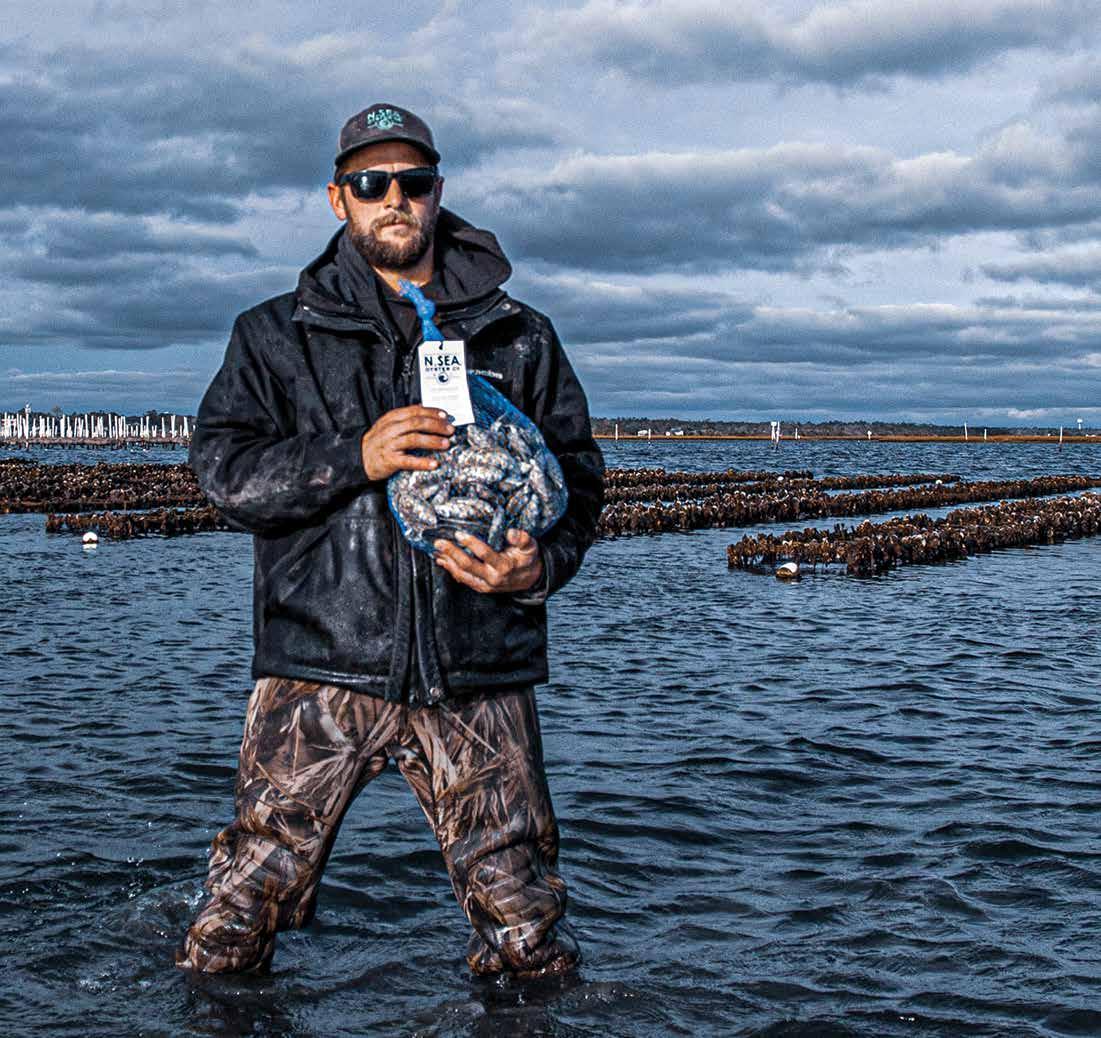 BY MELISSA ULSAKER MAAS '76
BY MELISSA ULSAKER MAAS '76
Conor MacNair knew exactly what he wanted to do with his life from a young age. He caught the bug for oyster farming and surfing from his uncle, John Finger, who is a well-known oyster farmer in Napa Valley, Calif. In Middle School Conor was fascinated by the ecosystem of the Chesapeake Bay and the push to rebuild the oyster population in Maryland and Virginia. Ecologically, native oysters are important because they create habitats for other species while filtering algae, sediment, and other pollutants—in other words, they help clean the water. For his St. Stephen's and St. Agnes senior project, Conor chose to work at his uncle's Hog Island Oyster Farm, every day for two weeks. That experience combined with his love of swimming influenced what he wanted to study, where he went to college, what he did while he was studying, the woman he fell in love with and chose to marry, and the fact that he now lives in waders and windbreakers, waterproof gloves and shoes, and spends a good part of his day up to his thighs in water—and he thrives on it.
Conor wasn't exactly your average high school senior, any more than he is your average oyster farmer. In the 2011 “Traditions” yearbook, many seniors utilized a quote to say something about themselves and their SSSAS experience, but Conor spoke only through quotes. Heavy and lofty quotes that not only advocate a love of nature and living in a way that is true to your soul, but also reflect how focused Conor was on his life's journey and his awareness of the importance of the decisions he was making along the way. Conor let Robert Frost, Henry David Thoreau, Ralph Waldo Emerson, and Walt Whitman express what he was thinking philosophically and spiritually, and chose a photo that showed what he loved most, a smiling Conor standing in front of, what else, water.
Conor does live life deliberately, simply, and with confidence and gusto. As a co-captain of the varsity swim team at SSSAS he won the 100-meter breast at the 2011 VISAA State
Championship, which helped the boys team clinch fifth place, the highest they'd ever gone in the annual statewide tournament at that time. Conor, Ferrel Atkins '12, Kyle Draim '14, and Cabell Perrot '11 placed fourth in the boys relay. Not content to just win a state championship, Conor also broke the school record with a time of 1:56 in the consolation heat.
With swimming and oysters in mind, he decided to attend the University of North Carolina Wilmington (UNCW), which had a strong swimming program and the option to study oceanography. “I had always liked opening and tasting oysters and the culinary side as well as the farming side,” Conor says. “We surfed and delved into that culture with my uncle John. My cousins and I all wanted to work with him and hang out in California. It was a very attractive lifestyle.” When he packed up and headed to UNCW, Conor had a definite goal in mind and wasn't afraid of the work it would take to achieve it.
Conor only swam his first year of college, and needed something more than academics to keep him busy. Naturally, he looked to the sea and spent three years cutting fish. “I'd get up at 3 a.m. and cut fish from 4 a.m. to midday, then finish the day at school,” Conor says. “I fell into the fishing world because there wasn't any oyster farming and I really enjoyed the opportunity to work direct-to-chefs, which is pretty much all we do right now. My whole day aside from growing oysters is constantly keeping up with chefs locally and around the nation and making sure that demands are met.”
At UNCW, Conor ran into a friend from Northern Virginia, Alyssa Pfannenstein, who was also a swimmer at Mountain View High School. They dated all through college and then joined forces to make Conor's dream come true in North Carolina. “We started a company with a kayak that we had to push across without a paddle,” Conor recalls with a grin. “Then the
Patterson family— Paige '12 and Parker '12 were in the grade below me at SSSAS—heard that I didn't have a boat with a motor on it. They lent me a Carolina skiff that was just sitting unused in their yard. That was our first boat and we had it until Hurricane Florence sent a tree right through the whole thing!”
Joined by his brother James '15, Conor and Alyssa launched N. Sea Oysters in 2017. Alyssa shares Conor's dream and is a true partner to him in every way, as a wife, mother of Finn (3) and Sage (1), COO of the company, and working by his side in the water. When they married in October of 2019, their registry had one option, a donation to help them expand their “farm and family.”
Together, they did extensive research on possible farming methods and leased seven acres in Topsail Sound, south of the Surf City Bridge. Shellfish growers can apply for one or more 10-year leases that give them permission to grow and harvest shellfish in a particular area of the seafloor along the North Carolina coast. The “shellfish bottom lease” allows farmers to grow and harvest shellfish on top of a bed of oyster shells or rocks on the seafloor; the “water column amendment lease” allows them to anchor floating cages containing shellfish to the seafloor; and the “racked system lease” allow them to grow shellfish in cages on rack anchored into the seafloor. Conor's system of farming
“People called me the crazy oyster guy in college because it was pretty much all I talked about. If you gave me the chance I would talk about oysters.”
requires a water column amendment lease and a racked system lease for his farm.
Conor's oysters are cultivated using a mixture of Australian and French oyster farming techniques. He worked with SEAPA, an Australian company that specializes in aquaculture systems, to develop an adjustable long-line system for the farm, which allows them to move their oysters through a series of hanging baskets as they grow. They inspect the baskets every day and adjust their height in accordance with the tides. Raising and lowering the baskets allows for better management of the shell growth. Their process includes drying the oysters out from time to time, which helps create a meatier texture and allows the shell to form a deep cup. The oysters are cleaned multiple times in a custom-built tumbler, which also builds texture. In order to cultivate the best possible product, Conor and Alyssa are constantly refining their process and selecting their favorite and quickest growing oysters that look the best each year. They are currently in the second year of conducting this kind of selective breeding, which not many other farms are doing, because it's fun for them.
“We plant every single oyster which comes from a hatchery,” Conor says. “Selective breeding grows good singles and we just grow single oysters.”
Throughout the process, the oysters go through bags at different densities and they make sure the oysters within those bags are similar sizes to prepare them for market, moving them up and up and up. “We clean them, tumble them, and sort them at least eight times through a mechanical grader,” he continued. “It takes about a year and a half to get to market size. In the end, we're looking for a two-and-a-half to three-inch deep cupped oyster that is nice and packed full of meat. Not like a really big oyster, just a good salty, delicious oyster that everybody can enjoy.”
Since he opened N. Sea Oyster, oyster farming in North Carolina has accelerated. “When my wife and I started farming, there were only 14 other growers in the state,” Conor explains. “Now there's more than 150. There's been an explosion which is great for the water, but some farms will flourish and some won't.” As of 2021, oyster farming was a $30 million industry in North Carolina. N. Sea's oysters have been recognized as one of four of the nation's top craft oysters by connoisseur and half shell expert Julie Qiu, and their “Dukes of Topsail Sound” oysters were also recognized by Garden and Gun in its state-by-state guide to
the top 35 oysters in the South. Oysters are on more and more menus across the nation. Conor loves locations that are surrounded by lots of local farms. “I like to eat at raw bars that offer like 18 different oysters, because variety is the spice of life!”
It's not always smooth sailing. A lucrative year for an oyster farmer means 50% of the crop makes it to market and weather can be N. Sea's enemy. After hurricane Florence, Conor estimated that they had lost about 100,000-200,000 oysters in the early stages of growth as a result of the storm. Although the industry is heavily regulated and days of consecutive testing is required to ensure there's no contamination prior to reopening waters for harvesting, a lot of misinformation surfaced that led to event cancellations. As a small farm, cancellations have a big impact on Conor and Alyssa both financially and emotionally.

Conor and his team harvest between 10,000 and 15,000 oysters a week. Fifty percent of them are shipped to Napa Valley, where the demand is heavy. He also ships to Birmingham, Atlanta, Charleston, and other Southern and mid-Atlantic locations. In addition to selling their oysters wholesale to restaurants, Conor and Alyssa have concentrated on growing their direct-to-customer market. N. Sea Oyster ships direct-to-door around the nation each week, and the orders increase heavily during the holidays. “Aside from our serious dedication to exceeding quality expectation, our direct-to-customer experience is what sets us apart,” Conor says.“It's an honor to be part of people's family traditions, and we take that seriously and send only the freshest oysters possible.” Conor, Alyssa, and four employees are a small, tight crew who grow, harvest, and pack the oysters with the utmost care, sometimes doing fun bundles and adding on to the oyster packages.
Another resource for increasing their direct-to-customer sales has been the local farmers market. Conor is aware that oysters aren't to everyone's
taste. “Oysters can be difficult to sell because people either love them or hate them. We work hard to encourage locals to eat oysters. We love the farmers market because it's a face-to-face way to educate people on how our oysters are grown, how they help the environment, how the industry is regulated, and ultimately get them to try one!”
This past April they accomplished a new goal, opening their Oyster Barn. The Barn serves as their office location, a pick-up point for customers' orders, as well as an event location. They have picnic tables and encourage customers bring friends and drinks and enjoy their oysters on site. “We hope to host four to six events per year,” Conor says. “We also cater parties (including some Saints weddings) and work with local chefs to do chef dinners.” In addition to their sold-out grand opening in the spring, Conor and Alyssa held a 4th of July barbecue, a “Shellebration” for National Oyster Day in August, and a party in September in support of the N.C. Coastal Federation and the threeyear We the Water Initiative. Members of a local canoe club will paddle the entire N.C. coast to advocate for clean water, empower local communities, bring awareness of contamination, and protect the water.
“Between working for my uncle and studying science through the Chesapeake at SSSAS, I've been well aware of the push for oyster growing for a long time,” Conor says. “We all know oysters are the future. Another reason I jumped into oyster farming right out of college was the North Carolina Oyster Blueprint.” According to the N.C. Oyster Blueprint website, the blueprint is an action plan for the restoration and protection of oysters, by “fostering collaboration among partners, ensuring oysters in N.C. perpetuate a healthy and robust environment and economy.” Sustainable farming and being able to grow something that has a positive impact on the environment are of paramount importance to Conor.
“Growing farmed oysters allows us to plant organisms that filter 50 gallons of water per day,” Conor explains. “It feels great to know that we help alleviate stress on the natural environment by providing more natural oysters to filter the water and by creating more oysters here on the coast. I always tell people I'm a clean water salesman.”
A friend from college who is a photographer brought Conor and Alyssa to the attention of Sperry. They were gearing up to launch their new Sperry Sport line and were hunting for water enthusiasts to represent them. Sperry is committed to protecting water and creating a more sustainable

future. They make their products with recycled and eco-friendly materials through a sustainable manufacturing process. “We love that our sustainable commitments are the same as Sperry's,” Conor says with a shy smile. “The connection happened by chance, driven by the fact that they were looking for real people to represent the new line— well that's what we are, just real people farming oysters, surfing, raising a family, and living the good life.”
To learn more about N.Sea Oyster Co., and order some delicious oysters, visit nseaoyster.co

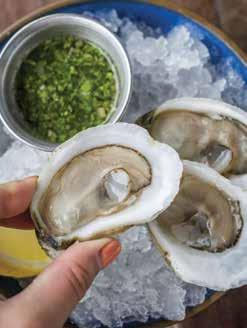
If you're a fan of cookbooks or food magazines, you've probably spent hours staring at lush-looking photographs of flaky pastries, juicy meat, or vegetables roasted to perfection. These photos make us feel things, just as they're designed to. But look closer—beyond the food—and you'll notice that each lavish picture contains multitudes. From the dishes holding the food, to the silverware set perfectly next to it, to the surface on which the dishes are sitting—these
props aren't picked at random. Instead, they're carefully curated to evoke certain emotions in readers, to deliver on a complex and artistic vision.
And when they're not being used in photo shoots, there's a chance those props live on the shelves of Plate & Patina, a prop house owned by Courtenay Philbrick.

If, like me, you're new to the entire concept of prop houses, Courtenay explains it simply. “We're kind of like a library,” she says. But instead of books,
Courtenay's collection includes over thirty-thousand pieces, from vases and plates, to glassware and cutting boards, to mixing bowls and linens. They're not used exclusively for food photo shoots, either - stylists will rent pieces for product shoots and other branded content. Some pieces are vintage, some are contemporary. Some are made explicitly for Plate & Patina, and some end up in the prop house in more organic ways.
“I didn't realize this would happen
as much as it does,” Courtenay laughs. “But people will reach out to me, and they'll have a collection of things that they inherited from their grandmother…and they'll offer it up to me for purchase, to use as props.”
Courtenay oversees both her flock of items and five employees. “My job as the owner of the business is to acquire new props, oversee the checking in and checking out of everything, and make sure things run smoothly,” she says. An operations manager acts as a second in command, and oversees the day-to-day exchanges at the prop house. And three part-time employees help pack items for orders, clean items that have been returned, and organize shelves.
Sourcing props is a big part of Courtenay's job. She's not looking for mass-manufactured dishware from, say, the local big box store. “We have specialty items,” she explains. “So it's harder to source them. It takes longer.”
Sometimes sourcing looks like traveling to antique fairs and auctions out of state, and sometimes that just means scrolling endlessly through Etsy, connecting with makers. One of Plate & Patina's specialties is handmade ceramics, which Courtenay sources from all over the world. Ceramic artists will sometimes work with Courtenay to make pieces specifically for the prop house.
Managing a prop house means staying on top of trends, no matter how fleeting. Each photo shoot has a specific air that stylists want to capture, and props are a major part of that. “You never know what people are going to want,” Courtenay explains. “It's very unpredictable, so it's in our best interest to have the widest variety possible of all different genres and styles. We had someone come in, and they were like, 'We need trays that feel like they're from the nineties.'”
Courtenay delivered.
Courtenay herself will be the first to tell you about her Type A personality. Which makes sense, given the expansive collection of props she manages.
“This is the perfect, structured job for
me,” she laughs. “I love organization, especially organization of pretty things.”
Plate & Patina is open for business Monday through Friday. Courtenay starts each workday by meeting with her operations manager, Marion Mason. “We're seeing what orders need to go out, taking inventory of things that have just come back, and getting a feel for what the day's going to be like,” she says. She spends a significant portion of each day going over inventory, adding items to the company's database, or fixing bugs in their computer system. She also makes herself available to stylists who come in to peruse the props. “Some people want help when they're pulling stuff for their orders,” she says. “And some people want to be left alone.”
When there's downtime, Courtenay and Marion turn to marketing. They'll set up mini photo shoots in the warehouse to post on the company Instagram, or create Reels to showcase some of their props. Sometimes, stylists and photographers will come in and use the space for their own product shoots. Depending on what customers want, each day looks different.
But for Courtenay, each day is fulfilling. After working as a stylist's assistant, she's found her niche. Plate & Patina “has put together my love of working in the creative industry, but not necessarily being the person creating the content,” she explains. “I think the pressure of being a stylist didn't really work for me. But I like being the one that creates the infrastructure for those people to do what they do.”
Courtney's hard-to-miss creative streak and desire to help others bring their visions to life makes her and her work seem like a match made in heaven. But her path to owning a prop house certainly wasn't linear, nor did she ever imagine this line of work for herself. Like many fateful partnerships, she “kind of fell into it accidentally.”
In 1994, Courtenay arrived at SSSAS as a kindergartner. She'd spend the next twelve years honing her skills as
a student and an actor. “The drama department was my home away from home,” she says, and this was especially true as she entered high school. “It was a really special time for me. I found my own within that department.”
She has fond memories of her favorite teacher, Jim Marvin who was “such a wonderful person. He really helped me throughout high school.” In Courtenay's junior year, Mr. Marvin was injured while building a set and spent some time in the hospital. His students and colleagues rallied around him. Another teacher took over directing the spring musical, and because, as Courtenay laughs, “I won't sing and dance on stage,” she was asked to co-direct. That role helped her flex her leadership muscles, and—like she does every day now—honed the skills she needed to take something from a vision to reality.
By Courtenay's senior year, Mr. Marvin had recovered from his injury and was back, directing the play “You Can't Take It With You.” Courtenay counts being part of that ensemble cast as one of her fondest memories as a Saint. “It was such a wonderful group of people,” she says. “We had a couple of athletes, that weren't normally taking part in things like this…There was an electricity to it that was really, really special. We could tell that Mr. Marvin was just so proud.”
“I'd never really questioned that… things are on plates”
After graduating from SSSAS in 2007, Courtenay arrived at New York University eager to fulfill a childhood dream. “I had known that I wanted to be in New York since I was seven, so it was kind of a nobrainer,” she laughs.
At first, she thought she wanted to be in the art world. “I knew that I wanted to work within a creative industry, but more on the admin side of it,” she says. Being in the city afforded her the opportunity to “fast-track” the process of finding out what she was good at, and what she wanted to do. While in school, she worked at a few art galleries (“It was just not for me”) and interned at Conde Nast, thinking she might find a place in the editorial world.
Courtenay says she was able to weed out different industry options while still in school. “I thought I wanted the art world, but not so much. I thought I wanted the fashion world, [but] not so much,” she said. “But I did get to try it, which was great.”
College also made her grateful for the education she'd received at SSSAS. “I feel like I learned more [academically] from my time there than I did in college,” she admits. “I think the emphasis on writing creativity, and critical thinking…I'm still very thankful for that. It really set up a strong foundation that I still use today, and still fall back on.”
By the time Courtenay got her degree in philosophy and art history in 2011, she had a pretty good idea of what she didn't want to do for work. But the job she did want was still eluding her. She went on to accept a slate of what she calls “random” jobs, “I was the startup manager for a mixed martial arts gym in Brooklyn,” she says, laughing. “I just did jobs that I thought had value in terms of what they could teach me….but didn't really have anything to do with what I wanted to do, because I still wasn't sure what that was.”
During a brief stint of unemployment, Courtenay heard from a friend of a friend in the city. “[She] was like, 'Oh, my friend works at a prop house, and they're hiring,'” she says. “I was like, I don't care what that is. I'll do it.” Turns out, the house was specifically for tabletop props.
“I had never heard of the industry,” she says. “I mean, I'd worked in magazines before, so I was aware of [props], but I'd never really questioned the fact that, in Bon Appetit, things are on plates in the photo. I didn't really question where they came from.”
That job at the tabletop prop house in New York changed Courtenay's entire career trajectory. But that trajectory didn't come without bumps in the road. After a few years at the prop house, she decided to take the “next logical step,” and become a photo shoot stylist. In the industry, aspiring stylists usually start as stylist assistants, which is what Courtenay did next. But helping style photo shoots didn't light the same fire
in Courtenay that props once had. “Clients can be really difficult,” she says, “and it's a lot of trying to make impossible things come to life.” Not working with one specific company was stressful (“freelance life really wasn't for me,” she says) but she wasn't sure what her next move should be. It turned out to be a literal move—first to Rhode Island, and then across the country.
“I think I felt a little lost,” Courtenay explains. “And I was like, you know what? I've got to get out of New York. I need a change of scenery.”
That new scenery would be found in Pawtucket, Rhode Island. Courtenay took a job at a clothing store, All Saints. “I was sort of trying to figure out what exactly the direction was that I wanted to go in.”
Several months later, the retailer transferred Courtenay to a store in Los Angeles. She made her way out west. Then, shortly after, she started searching for a prop house in the area. “That was the largest skill set I had, working with props,” she says. She found a prop house on Craigslist, of all places, the one prop house in the region that specialized in tabletop props. And by chance, they were hiring.
“I think they were as surprised to find me, as I was them,” she laughs.
Courtenay worked with the L.A. house for a year before she felt ready to strike out on her own. “I realized, you know what? I think I can do this better,” she says. “I knew enough about Los Angeles to know that there was a hole in the market here [for tabletop prop houses.]”
But there was one problem— Courtenay didn't have much in the way of her own collection of props. But then, a fateful connection occurred. “A woman that I knew from New York was a stylist for like, twenty years, and then had her own prop house. She reached out to me and said, 'Hey, I've heard what you're trying to do. I want to sell you my collection,'” she remembers. “So once that connection was made, it was like, alright. I've got to do this.”
Plate & Patina officially opened in January of 2020, and we all know what happened then. “We were open for two months, and then shut right back down,” Courtenay says. But the pandemic-fueled shutdown turned out to be something of a blessing in disguise for Courtenay's business. “I kind of consider it our soft opening,” she says. The team was able to work out kinks with their point-of-sale software and get a feel for what business operations would look like. When they reopened two months after shutting down, Courtenay says, “I was able to kind of start fresh.”
She says business slowly picked up speed after the company reopened, and has been ramping up ever since. Because of her niche industry, Courtenay relied a lot on word of mouth to spread the word about Plate & Patina. “I can't really market to just anyone, because there's a very small circle of people that would use my business,” she explains. “It's just kind of getting to know the people that are out there in the industry and hoping that they like us enough to tell their friends.”
It's safe to say—given the success of the business, the growth of her collection, and the fact that Plate & Patina is now the largest tabletop prop warehouse in the Los Angeles area—that people like them. And they have plenty of happy customers and reviewers rave over the “stunning” collection and the friendliness of Courtenay and her team.
These days, when she's not curating items for the perfect photo shoot, Courtenay spends time with her fiance, Gerry, and is an Orange Theory enthusiast. Oh, and she hasn't left behind the passion she discovered at SSSAS—she's gotten back into improv and acting. “I could not get up on a stage and give a speech to save my life,” she laughs. “But give me the chance, and I will jump up and do a weird improv sketch.”
Weird and wonderful. Those might be the best two words to describe Courtney's pursuits up to this point. Weird, wonderful, and perfectly plated, that is.
New York-based Photographer Keith Barraclough is perhaps best known for his portraits of celebrities like Steph Curry, Maggie Gyllenhaal, and the adorable participants of Animal Planet's annual Puppy Bowl. But he's also the co-creator of The Redhead Project, a collection of over 500 portraits and accompanying stories of natural-born redheads from around the United States and outside of it. In February 2021, Barraclough and cocreator Kate Lorenz took their project virtual, photographing redheads “wherever they live in the world.”
Barraclough and Lorenz source applicants for the ever-popular project by the letter of their first name. When the pair announced they were looking for redheads with “C” names last spring, Courtenay jumped at the chance to participate. The application process was intense and involved writing an essay and coming up with one's own idea for a photoshoot.
“I kind of gave them a blurb on my life and told them about the prop house,” she says. “They contacted me and were like, 'That is weird. We definitely want to see that!'”
The idea for the series is to photograph the subjects with things that represent their personalities, character traits, or interests. “Of course, I'm surrounded by a ton of my props,” she says. Every photo in the series depicts her surrounded by piles of props, like mixing bowls, dumbbells, salt and pepper shakers, cutting boards, a fake Christmas tree, a bright orange rotary telephone, and more.
“The series is all about getting inside the mind of a redhead,” Courtenay explains. And for this particular redhead that's being in her warehouse with the things she's carefully curated to bring visions to life—the photographs certainly nail it.

In 2014, Ian McLeod was grappling with his newly-formed company, Cleod9 Music. He had made the courageous leap to change career paths and follow his passion by starting a business in the music industry. But getting through to talk with the right people was a challenge and landing work was proving harder than he had anticipated.
Ian thought a project with D.C.based National Geographic could be the springboard Cleod9 needed and he was going to do everything he could to get in the door. After calls went unanswered, he went to the company's offices and, without an appointment, talked his way into a conversation with one of the executive producers. “I had nothing to lose,” he said, “and everything to gain, so I set aside any anxieties and just went for it!”
Fortunately for him, he caught a break and scored a short film project with the company's magazine team. It would be the first of several assignments. And with that, doors started opening.
Cleod9 provides original music, sound design and audio mixing for films, commercials, episodic TV, and other platforms. In September of this year, Ian's company won “Best Original Score” at the 2022 Jackson Wild Film Festival in Vienna, Austria, a global film festival that celebrates the best in wildlife and natural history storytelling. The Jackson Wild Media Awards are the nature film's equivalent to the Oscars. Cleod9's musical score for “Miami Wild” (presented by
Ian has a great rapport with his band in the studio. His effervescent, open, and friendly character fills the room with an affable atmosphere. Jokes and stories are intertwined with spontaneous bursts of music.
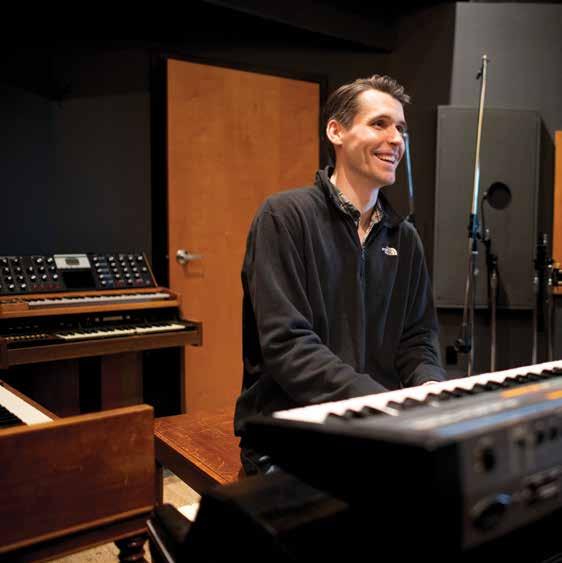
Smithsonian Channel and Terra Mater Studios) was recognized for “elevating the film's unique wildlife footage and capturing Miami's rich musical heritage.” Past recipients of this award include film composer Hans Zimmer (Lion King, Inception, Interstellar) in 2021.
“Awards don't validate my creative
goals and pursuits...but the respect of my colleagues certainly does,” Ian says. “Winning at Jackson was a career defining moment. There were so many people in that room whose work I admired and grew up watching (BBC Earth, National Geographic, Discovery Channel)...so to win in front of them was extra special.”
Ian's start in music began at age 7 playing piano. Years later, he grew restless with the rigid structure of classical music. “I liked moving the notes around,” he recalls. When he wanted to quit piano, his father suggested that Ian try jazz, where improvisation is encouraged. Ian took to it immediately and quickly expanded to “hip hop, soul, R&B…my passion took off,” he says.
Once he reached high school, Ian pursued his passion for jazz by playing piano for the SSSAS Jazz Ensemble. He also formed a small jazz troupe with fellow Ensemble classmate Wilson Miller (The McLeod Miller Jazz Combo) that gigged around town. In his free time, Ian would make jazz inspired hip hop beats

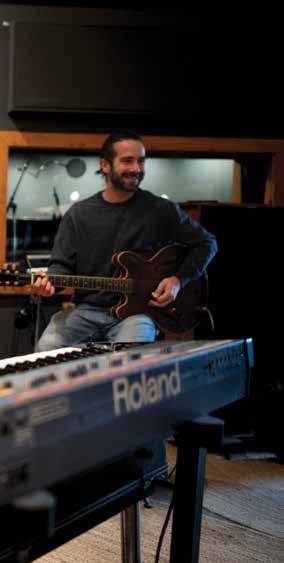
Ian's prowess on the piano is evident as he transitions easily from classic rock tunes from the Beatles to Gershwin to classical music. Then he sits and snaps his fingers and “bops” to a favorite jazz tunes “Bopilicity,” by Cleo Henry and Gil Evans, or hums a bit of the romantic “Dream a Little Dream of Me.”
and sell them to local artists in the area. He balanced his love for music with a matching dedication for athletics. He played several sports during his time at SSSAS with basketball being his favorite. Ian remembers finishing a game and rushing to change out of his uniform as he ran to the CPAC for a Winter Ensemble concert. He made it on time. As graduation approached, Ian planned on another creative path for college and career. He majored in advertising and communications at James Madison University. “I wanted to be the next Don Draper, like Mad Men,”
Their creative process starts with a team call led by the director...to learn about the film, characters, emotional arch and musical needs. They essentially build a mood board for the score, combing through potential sounds, genres, vibes and instrumentation. Then they watch the rough cut of the film and start to build out ideas. Much of their inspiration comes from the visuals
he says. Music remained important in his life, and Ian earned a minor in Music Industry and continued to perform small gigs around JMU's campus. He also DJ'd a weekly jazz and hip hop show for the school's radio station, WXJM.

After graduation, Ian accepted a job with an Old Town-based ad agency servicing the federal government. However, it did not turn out to be the creative outlet he had hoped for. He considered a job opportunity with an agency in New York City, but had second thoughts when his parents advised that living and working in New York might mean less time to focus on his music. “I wasn't willing to give up that part of my life yet.”
While pursuing his dreams of being Don Draper at his ad agency job, Ian noticed that music was a constant presence on the commercials they were producing. “At the same time content was really starting to explode with Netflix, Hulu, other
streaming networks, and a variety of branded content. A light bulb went off when I realized that I could make music for all of these platforms.”
Ian started Cleod9 in 2014 and faced a challenging start. Just when his friends were settling into careers and moving forward, he moved back in with his parents and struggled to get business. “I thought I'd made a serious mistake,” he remembers, until encouragement from his father led to the “what the heck” push at National Geographic.
Landing that small Nat Geo assignment led to other connections inside the company. It also beefed up his portfolio and jump-started his business development pursuits. Projects began to come in, including work with Red Bull, The North Face, and Disney—“big brands I've known all my life!”
Eight years later, the Cleod9 team features five composers and a sound engineer. Despite his success, Ian continues to hustle and build his client base. “I'm always looking 5-10 years
“Powerful imagery is such a source of inspiration for us. When we don't have the luxury of scoring to picture, we lean on the director's descriptions as our framework.”
Left front: BUDDY SPEIR, excellent musician, engineer and owner of the incredible 38 North Studio, is a new collaborator and will help Cleod9 score bigger productions in his studio. Left back: GARRETT CLAUSEN plays drums and bass, but is mainly their photographer, capturing behind the scenes footage of their scoring and studio soundtracks. Front right: EVAN HULEHAN, guitarist, engineer, and a Cleod9 composer, Ian and Evan have been collaborating for the past five years. Evan has worked on major film productions with Ian, including “American Horses” (PBS Nature), “Cowboys: A Documentary Portrait” (Amazon Prime) and “The Push” (Hulu). He's also been a steady hand on the commercial side, scoring for Patagonia, Strayer University, and Cavenders. Back right: IAN MCLEOD
out…working to build and maintain relationships with directors and agencies,” he says. “There are plenty of competitors out there, so I work hard to stay in the mix. A closed mouth don't get fed!”
Ian is now working to expand into episodic television. “The drawback in scoring commercials or a one-time feature film is when it's done, it's over. Episodic series allow us to explore and develop musical themes over the course of many seasons.
Ian credits his music teachers at SSSAS for influencing his career and love of music. Jerry Mirliani, James Criswell, and David Tauler were more than just

teachers, they were mentors. “They made music fun; teaching us to improvise, to trust each other and be comfortable on the big stage.”
Ian also fondly remembers English teachers Roberta Klein and Joe Wenger (now the associate director of Institutional Equity and Diversity) for promoting discussion and encouraging the students to engage with each other. “Those classes really helped me find my voice, especially now that I'm running Cleod9. I learned communication skills that help to this day, whether I'm pitching news clients, jumping on podcasts or asked to speak at film festivals ”
Ian and his wife, Tori, welcomed their new daughter, Evin Ila McLeod, earlier this fall. Along with enjoying family time, Ian returns often to James Madison to speak to music industry students and share his own experiences. He still plays basketball in a weekly men's league and is an assistant varsity basketball coach at Thomas Jefferson High School. He continues to perform around D.C. whenever he can, usually solo piano “to keep my jazz chops sharp.”
What advice would he have for today's Saints: “Be kind and build community, treat the gatekeepers well, and if you have a passion let it be your compass in life.”
On January 19, at the Paris Norde Villepoint Exhibition Park just northwest of the City of Lights, tens of thousands of people gathered to celebrate their art at the Maison & Objet trade show. Weavers, printers, and textile designers mingled with buyers from some of the most successful interior design companies on the planet. And tucked in among the artists showcasing their wares was Olivia Massie '13
The trade fair served as the official launch for Olivia's brand of home textiles, Maison Venu. Her first collection includes intricately-detailed, colorful printed napkins, table linens, throw pillows, and bedding. The rich, botanically-inspired designs call up images of faraway lands, tropical vacations, and a respite from the grind of everyday life.

It turns out, that's the point. At the core of Maison Venu is Olivia's carefully curated mission: “We believe fabric and design has the power to transcend memory, be a conversation starter, and offer sanctuary in the home.”
It's this idea of transcending memory that perhaps has influenced Olivia's journey as an artist and maker the most. In 2020, Olivia's grandmother passed away, and her home was slated to be torn down. Olivia and family members went there to pack up her grandmother's belongings. Olivia's sharp eye for design

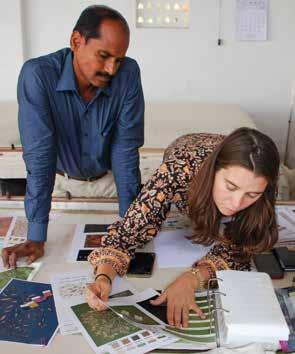
and passion for beautiful things may have been genetic.
“We sorted through all of her artwork —original pieces she painted and various others she collected over the years among other curated collections of items like tiny spoons from her travels, cook books and hand painted plates,” Olivia says. But Olivia was drawn to one part of her grandmother's collection—various wallpapers and fabrics that had adorned her grandmother's walls.
“They were the backdrops of my earliest childhood memories,” she says. Olivia ended up taking several pieces of the wall coverings,“in remembrance of my grandmother. But also preserve my memories of growing up in this home with the most important people in my life.”
Olivia says when she remembers her grandmother, those patterns and fabrics are deeply intertwined in her memories.
And that's a feeling she hopes to incite in her customers.
“I hope to create designs and pieces for the home that hold this kind of sentimental value,” she says. “Designs that create the environment where your memories are created with friends, family and anyone that steps foot into your home.”
“My grandmother's love for art and fabric, as she loved to knit, sew and crochet, was something we shared,” Olivia explains. “The relevance and importance of the designs found throughout her home serve as a tiny nod to my career in textiles and fibers.”
Olivia's grandmother is but one piece of the vast puzzle that has led Olivia to where she is now. It took the dedication of a teacher at St. Stephen's and St. Agnes, a life-changing trip to India, and, yes, a global pandemic to truly shape the arc of Olivia's career as a burgeoning designer.
Terry deBardelaben is an accomplished ceramicist whose extensive CV details dozens of exhibitions and awards. Her sculptures are often made with both clay and other materials, and her intent as an artist is to “create objects that intersect: converge, merge, bridge, relate,” according to her website.
Beyond her career as an awardwinning artist, deBardelaben is also an educator—one that had a significant impact on Olivia and her art. In 2004, deBardelaben joined the faculty at SSSAS as a ceramics teacher. “She was my mentor for all four years,” Olivia explains. During her junior year, Olivia was able to take a one-on-one class with deBardelaben, which sparked Olivia's creativity even more.
“It gave me time to explore mediums that we didn't have at SSSAS at the time,” she says.
Each year, Olivia took ceramics throughout the entire SSSAS school year. This medium became her emphasis, but she would soon branch out to other art forms. During her junior year independent study with deBardelaben, she was able to sit in on an AP three-
dimensional art class and complete the projects that the class was assigned. One of them involved cutting shapes out of paper and fabric and installing them near the lights of the school's atrium, so that shapes would be projected onto the floor. Despite it being, as Olivia laughs, “low budget,” the project marked a turning point for Olivia. She'd never taken a sewing class. She'd had no previous exposure to fabric or printmaking. But the project gave her the idea that fabric might be the medium for her. “This was the first thing I created that played with how art can affect an environment,” she explains, “and it made me think that design, or interiors, could be the right fit for me. Ms. deBardelaben let me work through my creative process, instead of being regimented and having the same assignments as everyone else. She saw that I would benefit from a different structure and environment as a student.”
And benefit, Olivia did. It was deBardelaben's guidance, and also the experiences that Olivia had in the art history department, that shaped her perspectives on what would be her life's work. In her senior year, Olivia took an art history class with Jean Hunt.
“I fell in love,” Olivia remembers. “The way she taught the class, and presented the information, it spoke to the adventurous part of me.” In that class, she was again exposed to the world of fabric-making. “I was specifically fascinated with the ancient techniques and mediums that different cultures were known for, such as European tapestries and Indonesian batik's,” Olivia says. “These moments of exposure to the world of textiles were interesting to me early on and reaffirmed my plan to study interior design and art history.”
It was also during her time with Hunt that Olivia made a big decision—not to attend college right away after graduating.
“That idea of taking a gap semester was something I started talking about from the beginning of senior year,” Olivia says. It wasn't until Olivia was admitted off the waitlist to her first choice school for the Spring semester that she started to seriously consider this option. “It was not my original plan, but it turned out to be exactly what I needed. It was the perfect opportunity to explore the world and feed the curiosity I had
developed through art history and my interest in different perspectives [and] different cultures.”
This “brought all of that together for me, and is what pushed me to not follow the typical path to start college in the fall, and be confident in that decision,” Olivia says. “I knew I was going to learn something different by exposing myself to experiences I'd never have otherwise, and that's sort of how I've approached my entire career.”
Olivia may have been confident in her decision to delay the traditional first semester of college, but that didn't mean the decision was easy. After graduation in 2013, her friends and classmates went off on their own adventures. “The first two weeks of September were really tough,” Olivia remembers. “My friends had left to start college, and I was home with my two sisters who were both attending SSSAS. I remember asking myself, am I going to regret this decision?”
As it happened, regret was the farthest thing from Olivia's mind when she landed in Jaipur, India through a gap semester program.
“The moment I arrived and saw the new, warm, and joyful faces of the people I would be spending my time with, I had this feeling that despite all the uncertainty I was in the right place. Sometimes you realize that however unplanned, you end up with the people you need to meet. I couldn't have had a more formative 'fall semester,'” she says.
Some of those people, it turned out, were the weavers who served as Olivia's host family. Jaipur is known as one of the textile capitals of the world, so it's fitting that Olivia says it's where she “completely fell in love with fabric.”
It was that love affair—plus previous years spent honing her artistic style and appreciation for art history— that pushed her to major in textiles at the University of Georgia. She started classes in January of 2014, and graduated in the spring of 2017.
It was then she felt pulled back to India. “I left India the first time with the intention to find my way back,” she says. She moved back to Jaipur and spent a little over a year working with Anoothi, part of the non-profit Vatsalya. Anoothi's vision is to “create a better socio-economic world for poor and marginalized women,” and the company does that by training women in skills like embroidery, woodblock printing, natural dying, and stitching. They also provide shelter and schooling for over 50 kids in the foster care system, who live on the property, about 30 minutes outside of Jaipur. Olivia was in charge of training around 35 women in printing, color mixing, and stitching. Besides teaching the participants the art of printing and color theory, Olivia worked behind the scenes to wrangle a fast-growing customer base by sourcing materials and designing products to sell. She also served as a sort of curator, lending her perspective as a designer. “They were making products for the Indian and Western markets. They needed someone to come in and help make adjustments to sell their products across all markets. I reviewed everything from materials to stitching and embroidery styles, color, design, and finished products, ” Olivia says. “I tried to look at it from their perspective as well—learning about their Indian buyers and trying to figure out what we were missing?' And then would
help fill the gaps.”
Olivia says in the last six months of her time in India, Anoothi “sort of let me run wild. They encouraged me to design whatever I was drawn to, which allowed me to explore and helped me consider how we could differentiate ourselves from other brands and products already in the marketplace.”
Jaipur's reputation for churning out incredible textiles only deepened Olivia's exploration. “When you walk around the town, it's sort of like a museum of the home decor industry,” she says. “You can spot Anthropologie's warehouse in the middle of a bustling alleyway in the Old City, you see Pottery Barn's team in the markets and what they're buying. Everyone's product is just out for display.” That meant Olivia could have her finger on the pulse of what others in the industry were doing, what trends were emerging. “This is a huge part of my story for starting Maison Venu,” she says. “I was able to study and see what other people were doing, and then find a way to do it differently.”
While in Jaipur, Olivia accepted a job offer to stay on with a different design house based in India. But issues with her visa landed her back in New York, where she took a job at Swavelle as a textile designer. At their mill just outside
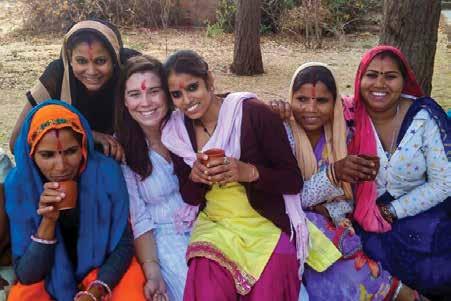

the city in New Jersey, Swavelle creates fabrics for a wide swath of clients, from Restoration Hardware to Williams Sonoma to Fabricut. And some of those fabrics are custom-designed by Olivia.
“I create the artwork and then consider the different kinds of yarns and weaves to use to bring that design to life,” she says.
While Olivia thrived at the mill, she began to get the itch, as many budding entrepreneurs do, to work for herself. When she left Anoothi in 2018 and came back to the states, she'd brought with her several products she'd designed and made there. Friends and family clamored to buy them—and you can probably tell what happened next. “Over the years, people still had that product,” Olivia says. “And every time they would use it, someone would say, where can I buy it?” Without having designed a curated collection of her own, Olivia already had clients willing to buy her products.
Then, of course—the pandemic hit. Olivia moved back home to Alexandria, where she worked remotely until she began a six-week furlough. By the time she resumed work part-time at the mill after her furlough, she had another parttime gig—helping a local Alexandria designer create custom patterns for clients.
The work continued to boost her confidence. “That furlough time helped
me realize that I could take on clients of my own,” she says. “I just needed the time to network and find the right partnerships. And that window of working part-time for a couple of months was my opportunity.”
By the fall of 2020, Olivia was back in New York and back at the mill full time, but still working with the Alexandria designer on the side. She says people in the industry started passing her name around, and she began working on her own with clients, creating prints and designing products for events. “I did a custom tablecloth, napkin, and runner
collection for a friend's wedding,” she says. She did the same for another friend's wedding—also an SSSAS alum—in January of this year.
While she was working independently by late 2020, it wasn't until early 2022 that she began “taking baby steps” to build her own business—working on her own designs, networking with people she'd met in India, finding manufacturers, and honing her story as a designer.
In January, Maison Venu officially launched at the Maison & Objet trade show, held during Paris Design Week.
Olivia's journey as a business
owner is just beginning. But in some ways, she's been on this path for a long time—from a childhood spent reveling in her grandmother's unique design collections, to coming of age in classrooms helmed by Terry deBardelaben and Jean Hunt. What took her across the world to India while most of her peers were settling into dorm rooms—her intuition—has undoubtedly served her in her work as a designer.
“If you follow your gut,” Olivia says, “it puts you in the room you need to be in.” And that room is, without a doubt, exquisitely decorated.

Picture this: a major company is going through a transition. Maybe it's expanding, and needs help sharpening a new vision. Maybe it's welcoming new people onto a team. Maybe it's wondering how to respond to external factors like, say a global pandemic. In any case, executives at this company have a problem they can't solve on their own.
Enter Greg Roland. His official job title may be “senior lab producer” at Deloitte, but his daily work is much more than that. “We're innovation consultants,” he explains. “We're camp counselors. We're corporate therapists. We're producers. We're event planners…It's a combination of a lot of different hats.”
The throughline to all of those hats—and what becomes immediately obvious as soon as we start our interview? Greg's a people person, through and through.
“I'm a big extrovert,” he confirms. “I love being around people.”
These days, the people that Greg is most often around are c-suite executives from major companies like his employer, Deloitte, and other large firms. Executives enter Deloitte's Greenhouse with a problem—or problems—to solve. And if Greg has his way, they leave with concrete solutions and the know-how to reach them.
That's thanks to a carefully curated experience, designed by Greg and his colleagues at the Greenhouse. Over a short time span—usually eight hours—Greg designs activities and environments for team members that foster collaboration, creativity, and innovation. “We're designing an experience for them that helps them achieve their goals in a very concentrated time,” Greg explains. “We're not solving the problem for them, but we're providing an atmosphere where they can do the solutioning in an environment that promotes psychological safety and innovative business thinking.”
BY JESSICA YARMOSKYI admit to Greg that in my mind, I'm picturing a bunch of high-level executives attempting to untangle themselves from a human knot. He laughs—but it turns out, I'm not far off. Attendees do dabble in team-building activities—hence Greg's quip that he's part camp counselor—and also get deep in frank conversations about goals and purpose. Teams use the Greenhouse for big reasons—like aligning folks after a company merger—and small, like welcoming employees into new roles.
Greg's work looks different every day. He's often designing multiple Greenhouse experiences at the same time, touching base with clients and stakeholders to make sure the labs are ready to go off without a hitch. But Greg's pre-work mornings all look decidedly similar—he does something to spark creativity. “Sometimes, I'll read a good book, or I'll start with some journaling or some devotions,” he says. “Or honestly, sometimes, I'll start with watching a cartoon.” His favorites?
“Batman: The Animated Series,” “Avatar: The Last Airbender,” and 2003's “Teen Titans.” “I love just being creatively inspired,” he says.
It doesn't take long into our conversation to establish what Greg brings to the table at work. His road to this job—which seems like it was made just for him—was winding, and included stops in accounting, an abrupt change of major, and real estate.
Greg joined the Saints community as a seventh grader, in 2006. One fond memory from that time? Math classes. “The teachers that I had really made me excited about the possibility of being an engineer or an accountant,” he says.
“So, going through high school, that's what I wanted to be, a forensic accountant.”
Forensic accountants investigate white-collar financial crime like fraud or embezzlement. They also analyze financial documents and information to be used in criminal
proceedings, and often serve as witnesses in high-stakes fraud trials. It's an intense profession, but Greg kept his focus trained on it throughout his time at SSSAS, taking accelerated math and physics classes. Then came time to pick a college. “Through the grace and help and guidance of the amazing college counselors we have, I found my way to William & Mary,” Greg says. He stayed in the accounting track throughout his first two years at the Mason School of Business in Williamsburg, Virginia.
But his forensic accounting visions grew cloudy after a while. “After taking some advanced accounting courses, I realized, Oh, this actually is not for me,” Greg says.
For someone with a razor-sharp focus on one future for the past six-plus years, the realization was alarming. “It was kind of stressful, because I was in my junior year, my second semester, realizing I wanted to change my major,” Greg explains. While his classmates were honing in small seminars and labs concurrent to their long-ago-
declared majors, Greg says the pressure was mounting for him. He had to ask himself a question that every befuddled innovator, like the ones who show up at Delottie's Greenhouse, has to ask: “How do you pivot?”
Temporarily rudderless, Greg turned to his community. “I talked to my parents, I talked to my friends that I had in college,” he explains. “My roommates, people who knew me, and knew what I was good at, who were also in the business school. And I asked them: Hey, you know who I am. What do you think I would be good at?”
Greg says multiple people in his community kept emphasizing the same thing: his creativity. “The closest throughline for that in the business context,” he explains, “was marketing. I had several people just say, 'Hey, you should think about marketing.'”
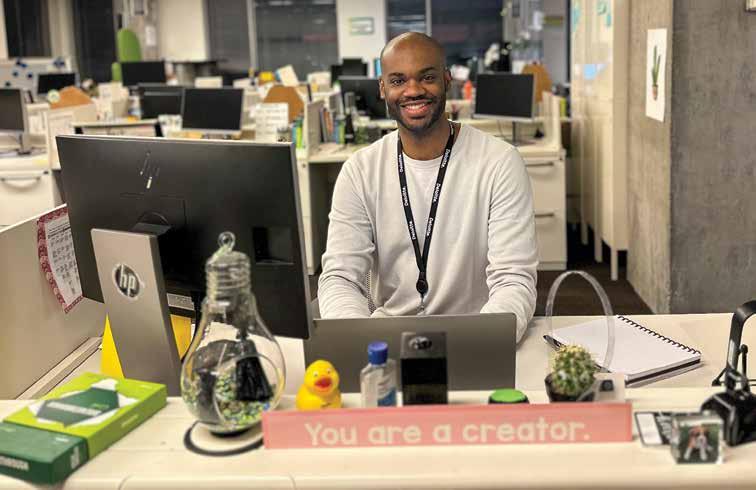
That's all it took: Greg switched his major to marketing. What followed was an almost mythical rush of opportunities coming knocking.
First, he met Dr. Dawn Edmiston,
Clinical Professor of Marketing, in one of the first marketing classes he took. Edmiston, Greg emphasizes, “absolutely changed my life.” That's high praise for any educator, but Greg says what he got from Edmiston's class changed his entire perspective on marketing, and what it was.
“I fell in love with marketing. I fell in love with how people-centric it is, how important it is to understand what people feel, what people think, what people desire,” he says. “And [understanding] that marketing is really about having relationships with people. And once I kind of got that, and started to experience that, I knew that I was in the right space.”
It was Edmiston who had the idea that Greg might find success after graduation in the world of real estate. He says Edmiston noted how much of a “people person” he was. “I've got great EQ,” Greg explains. (Author's note: can confirm.) “I'm really good at reading people, and responding.” Greg saw real estate as a way to take all of
his business and marketing education into an entrepreneurial context, and to put people at the center of his business pursuit. “That's kind of how I approached it, the opportunity to be the kind of business that emphasizes, we really, really care about our customers,” he says. “We really really care about how they are and what their needs are, and meeting them at their level.
Greg joined his local Keller Williams real estate office, starting his own business as a licensed real estate agent, and worked there for the next five years. He says he found success there, but soon grew antsy and realized it was time to take on a new challenge. That new challenge was grad school, which found him back in the Mason School of Business at William & Mary, again working with Dr. Edmiston. Pursuing a master's degree in marketing let Greg, he says, nurture his creative side in a different way than working in real estate afforded. “It's like I got to give myself permission again to be as creative as I wanted to,” he says. “And to really flex that growth mindset and that design thinking mindset and that innovation and creativity mindset.”
Conversations with friends and
colleagues led Greg to recruiters at Deloitte, and then to the Greenhouse. He began his job there in June, and has been flexing those mindsets at work ever since.
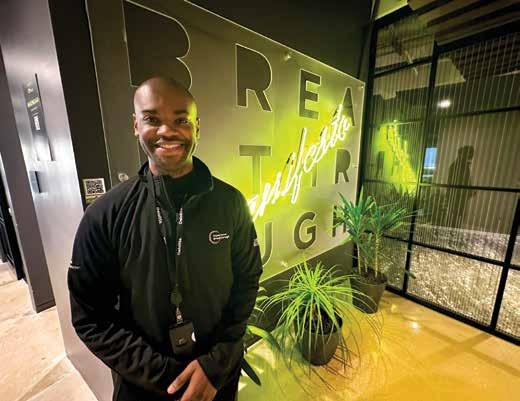
albeit somewhat reluctantly.
“I wanted to join the drama [department,]” Greg admits. But as they often do, Greg's mother knew best: Greg could sing, and sing well. “My mom forced me to join the choir. It's so funny to look back at that, because man, what I would've missed out on.”
Greg may spend the hours between 9 to 5 getting deep on how to help people solve problems. But as any seasoned veteran will likely tell you—work is just one part of life, not the whole thing. It's what Greg curates outside of the Greenhouse that has had perhaps the biggest impact on is life: music.
Greg says he was surrounded by music from a young age. “I have distinct memories of listening to Motown and the Temptations with my dad,” he says. By age four, Greg was plucking out songs on the piano, and writing his own. Every Sunday, he'd “stare for minutes on end” at his church's piano player. “I was just absolutely fascinated with the pianist,” he says. He sang in the choir in elementary school and at church, and in seventh grade, joined the SSSAS choir—
In February of 2010, Greg's sophomore year, Alexandria was blanketed in several feet of snow—one day saw almost nine inches of new snowfall. Greg remembers being out of school for around two and a half weeks. While other teenagers may have taken it as a sign to sleep or lounge around in front of the TV—and we wouldn't blame them—Greg got to work.
“It was the beginning of my songwriting journey, in earnest,” he says. “During that time, I wrote upwards of 15 songs.”
He'd written little melodies before, he said, but by the time school resumed, Greg had an album's worth of full songs: “piano, intro, chorus, melody, verses, lyrics, all of it.”
For his senior project, Greg perfected those songs—and kept making more music.
Twelve years later, Greg says he's
“I want to create things that people can't live without”
“I've learned that JOY isn't something I can simply wait for to come to me. I had to intentionally find, and even create, opportunities to experience JOY and that happened for me by leaning deeper into creativity and community.”
composed around thirty original songs. He does it all: writes lyrics and instrumentation, sings, does background vocals, mixes, and masters each song. His music is catchy, layered and complex, and—like Greg's career journey—relies on pivots. One song can span R & B to synth-heavy electronica before turning into a disco-flavored ballad. “Gravity,” which he released earlier this year, is a song originally performed by Deitrick Haddon, one of Greg's favorite gospel artists. The lyrics are both hopeful and profoundly sad:

Stuck on the moon
How beautiful Earth is form this point of view
So much evil back on the ground Gravity keeps on bringing me down
Greg says he challenged himself to both stay as true to the original song as possible, while also adding his own spin on it through production. He shared a snippet of his version of the song on his Instagram, and Haddon saw it and commented on it. “Needless to say, I was ecstatic,” Greg says.
Beyond his own album, Greg has composed music for podcasts, small businesses, his church, and even his company, Deloitte. He's just hungry to make music, no matter the context: “whether it's kind of like R & B, or a pop style, or a quartet style where I'm kind of layering voices, or something acapellaish, or if I'm kind of scoring something for a film.” That frontier—sound design for films and television—is the next thing Greg wants to conquer.
“I'm all about pushing my own creativity and [asking], how can I improve? How can I get better?” he says. He has a mantra that he's developed for himself and his work: “I want to create things that people have neither seen nor heard before, and cannot live without.” Greg says that mantra, which he honed over many months, helps push him when he's feeling creatively stuck.
During his tenure at SSSAS, Greg says—and this should surprise no one—that his ability to mesh into a lot of different social circles became something of his calling card. “A lot of people knew who I was,” he says, “and I took that as an opportunity to really develop these relationships I had, and to be there for my friends, and to kind of be somebody that upholds the values and cultures of what it means to be a Saint.”
Greg says he took that role seriously, trying to “be as good a representative of the community as I could be.”
“And I love coming back [to the school],” he says, noting that he's formed tight relationships with both people he graduated with and also alums from other grades. “That's kind of what made my time at St. Stephen's and St. Agnes special, being pulled forward [to] people who are older than you, and then reaching back and pulling [up] people who are younger than you into that community, and giving them a safe space to be who they are.”
He says when he returns to his
alma mater, it's not uncommon for students and staff to greet him as “Conrad Birdie,” his role in the school musical his junior year. “I still have the jacket in my closet,” he laughs. Another fond, stereotype-thrashing memory? Being on the football team. “I wasn't a star or anything, but I was fast, and I had a lot of respect from my coaches and from my peers.”
These days, Greg seems to exist at the perfect convergence of his past experiences. The thrum of his own music, sharpened at the school, is the basis for the ideas he comes up with on how to help people solve problems at his job— ideas basted in a creativity that he's been honing as a student, athlete, musician, business major, marketing professional, and cartoonlover.
Perhaps the best word to sum up Greg's life? Joy. That word was at the center of a piece he wrote for LinkedIn in September of 2021. “Sometimes, creativity and joy require that you intentionally create opportunities to obtain it,” he writes. “Creativity and joy aren't just perpetual states of being, they're tied to action and proactivity.”
And it would seem that no one is more proactive in the pursuit of joy than Greg Roland.
Every year the American Kidney Foundation (AKF) holds The Hope Affair gala to honor the inspirational individuals who fight kidney disease every day and to celebrate the courage, commitment, and passion shown by patients, caregivers, health professionals, advocates, and innovators who work to improve health outcomes. This year at the 14th annual gala on October 19, Ellie Hanley '22 was honored as a Hero of Hope for running a marathon and raising more than $27,000 to give back to kidney disease research.
When Ellie was in the sixth grade, she came down with a bad case of pneumonia and woke up one morning with very swollen eyes. Her parents, Amy and John, took her to the hospital where
they discovered her kidneys were not working well. She was referred to a nephrologist, who performed a biopsy just before Christmas, She was diagnosed with focal segmental glomerulosclerosis (FSGS) in January 2016. This rare kidney disease causes scar tissue to develop on the parts of the kidneys that filter blood and can lead to kidney failure. The diagnosis was a shock to Ellie and her family, and they still don't know what caused it.
Despite being on a daily regimen of 15 pills and having occasional infusions to stay on top of her condition, Ellie never let FSGS affect her studies or her performance on the field. She is quietly confident and approaches life with a positive attitude. She was salutatorian of the Class of 2022 and received the Helene Haskin Krause Award, an award presented to a senior athlete who has demonstrated excellence both in their academic work and athletics. “While my diagnosis was a pretty dramatic event that I have to face every day, taking the medication and never really knowing exactly what it means for the current state of my kidneys, I feel really fortunate that it doesn't prohibit me further,” Ellie said. “Over the years I've learned more about my kidney disease and discovered how many people my age with the same condition are not only unable to participate in any sports, but also are living on dialysis in the hospital. It makes me feel fortunate and grateful and that's why I wanted to give back in some way.”

Ellie comes from a family of athletes, and she played competitive field hockey and lacrosse from a young age. Her older sister, Bridget '20, plays lacrosse for Colorado College and her younger sister, Claire '25, plays on the varsity tennis team and also started an SSSAS Girls on the Run program. Running was part of Ellie's athletic training and something that she's always enjoyed. Inspired by her mom, who had completed five marathons, Ellie had thoughts of following in her footsteps. “I knew that I wanted to run a marathon at some point, and then the idea of combining a marathon with fundraising for AKF started to develop,” Ellie said. “Towards the end of my sophomore year I signed up for the San Francisco Marathon, because it was one of the few marathons run in August. It lined up perfectly between the end of my summer lacrosse season and the beginning of field hockey, but COVID intervened and the marathon was postponed until September 2021.”
Determined to follow through despite the change in timing, Ellie registered again in January of 2021. In April, about a month before she started her 16 weeks of training, she reached out to AKF. “I wanted to see if there was anything they could do to help me with the fundraising aspect,” Ellie recalled. “They were amazing and helped me set up my own donation page on their website, which included a place to tell my story and blog about my journey.” Her fundraising goal was $26,200—$1,000 for every mile. The day she started her training, Ellie emailed her friends and family, the Saints community, and acquaintances from
all the sports teams she had been on to launch her page. “Lots of people reached out and told me they were sharing it, and from there it just kind of spread,” Ellie said. Ultimately, more than 100 sponsors helped her exceed her goal, raising $27,604.
The only organized race Ellie had ever run before was her neighborhood five-mile Turkey Trot on Thanksgiving. Undaunted, she created a disciplined training plan, getting up before 5 a.m. to run with her mom, who Ellie says “needed a little convincing to join her.” Ellie finished her first week with a tough eight-mile run. In preparation for the grueling hills in San Francisco, they made sure to run through hilly terrain on their progressively longer runs. Ellie sat down regularly to blog about her training
on her AKF web page.
When the big day came, Ellie was ready. “It starts off with six miles that are pretty flat,” Ellie said. “Then you climb up the Golden Gate Bridge and cross to Sausalito where you run one mile downhill. That's where you realize how hard the hills are going to be!” Ellie's playlist for the run was “a very long, crafted playlist,” but her AirPods died and she ran without music for the last few miles. “It was so much fun,” Ellie said with a grin. “I got separated from my mom around the 13-mile mark, but it was a really cool feeling to be running alone absorbing the energy of the city. I remember getting really tired, but I had my name on my race bib and could hear people calling out, 'Go Ellie.'” And she did, all the way to the finish line.
During the summer the AKF sent a film crew to Alexandria to shoot a video of Ellie to be shown at The Hope Affair gala. They shared many other stories of different kidney patients, and Ellie recalled seeing her story for the first time. “The gala was an unforgettable experience. I hadn't seen the video and I was backstage while they were showing it, but they had a little screen for me to watch it on right before going onstage. It was really incredible to be honored and part of the event.” At the conclusion of the video, her father expresses hope for Ellie's future. “Obviously, we never wanted her to go on this journey, but for her to turn a negative into a positive—I think is a really encouraging sign that she's going to be okay.”
assistance. When they sent out word that the program was available, more than 30 girls signed up.
Claire Hanley '25, caught the running bug from her mom and big sister, Ellie. She was so inspired, she went out for winter track last year and signed up for two local half marathons. As her love for running grew, so did her desire to share it in some way at school.
“I thought starting a Girls on the Run program at SSSAS would enable me to share my passion with other people,” Claire says with great enthusiasm. “I babysit and love being with little kids.”
Girls on the Run was started in Charlotte, N.C., in 1996, to help

strengthen the confidence of young girls and underscore the important connection between physical and emotional health. In addition, the program places an emphasis on developing character, caring, and competence through lessons that include running and other physical exercises.
The program requires an adult supervisor, so Claire sought help in the Saints community. Three Lower School teachers stepped up to help her create and run the program, Franny Alston (third grade), Michelle Bruch (science), and Megan Grant (fourth grade). Saints parents Natalie Stemp and Jennifer Strickland also offered coaching
Leading the program is not a small commitment. The ultimate goal was preparing for a Girls on the Run 5k on November 20, but there is more to it than running. “We have practices twice a week after school, during which we not only do running activities but also activities that teach them how to have a balanced lifestyle,” Claire explains. “Each practice has a different theme. It could be an activity focused on meditation, bonding, friendship, stretching, or a fun game, but it always ties back to the central theme. The program includes a service component, so the girls made baskets for children in the hospital and toys for animals in the shelter.”
Claire feels it's been an amazing leadership opportunity. “It teaches these girls valuable life skills, and I've had some very meaningful conversations with some of them. They have good ideas for their age. I enjoy gaining insight into what they have to say, advising them, and collaborating with them. We work together to decide what's best for our team and ensure everyone is having a good experience.”
So, will Claire do it again? Yes, definitely!
Middle School History Teacher Katherine Bryant received a Holden Summer Grant to spend the summer of 2022 in Lebanon, Cyprus, and Turkey. In addition to her historical research and travels, she worked at a summer camp for Syrian and Lebanese students. Katherine's hope was to travel to some of the places considered to be the “crossroads of the world,” in order to explore and better understand the ancient and contemporary overlap of Europe and Asia and the rich and unique cultural features that these areas boast. In exploring these geographical and historical intersections, her primary goal as a learner was to be better equipped to facilitate dialogue and curate learning experiences for building global competency in her classroom and community. She shared her summer adventures through the following chapel talk.
“The righteous flourish like the palm tree and grow like a cedar in Lebanon. They are planted in the house of the Lord; they flourish in the courts of our God. They still bear fruit in old age; they are ever full of sap and green, to declare that the Lord is up right; he is my rock, and there is no unrighteousness in him.” Jeremiah 29: 1, 4-7; Psalm 92:12-15
This is a story about trees. It could just as easily be a story recounting my own hero's journey. Not because I am suggesting in any way that I am a hero but rather that I've experienced the sweetness that is recognizing one's smallness on the other side of a significant journey. This journey took me beyond my threshold into what was nothing short of an unknown world and, to paraphrase T.S. Eliot, brought me back to a place that I could know as if for the first time.
Great hero stories include great trees. From Gilgamesh's perilous journey through the cedar-laden Realm of the Gods in ancient Mesopotamia, to Tolkien's Forests of Mirkwood and Valinor in Middle Earth, even to Harry Potter's encounters with the Whomping Willow.

Great trees also populate the redemptive arc that begins in the Old Testament: two trees in the Garden of Eden–The Tree of Life and the Tree of Knowledge of Good and Evil, the oak at Shechem where, in a significant moment of turning, Jacob buries his foreign idols, and, even the trees of the field clapping their hands, the prophet Isaiah's foreshadowing of the alleluias of a fully restored creation.
The tree motif echoes throughout human history reminding us of life and inviting us into a greater story.
My own story begins with a vision of sorts and a heart that was set on tending to the olive trees that are prolific on the island nation of Cyprus. But, stilled by the meditative rows of olives, not quite ripe for harvest, I was met by the merciful reality that God could come as a whisper, and the Spirit nudged me forward with a promise in prayer, “I have something to show you.”
I went searching for olive trees and landed among the Cedars.
And so, I ventured from Cyprus to Lebanon. For centuries, Lebanon's snow-capped mountains and forests have been a safe haven for religious minorities. An anomaly in the region, Lebanon is marked by multiculturalism and the coexistence of many faith traditions. A French author visiting the capital city of Beirut described that “Lebanon condensed and summarized in itself all the problems of the modern world, and that if only one of these problems could be resolved in Lebanon, it could then serve as a model solution for the rest of the planet.” Put simply, Lebanon is a complex place.
Living in Beirut for the summer, I was witness to a small glimpse of the daily complexities facing the people of this country. Lebanon's modern history includes a civil war, a failed state characterized by government corruption,
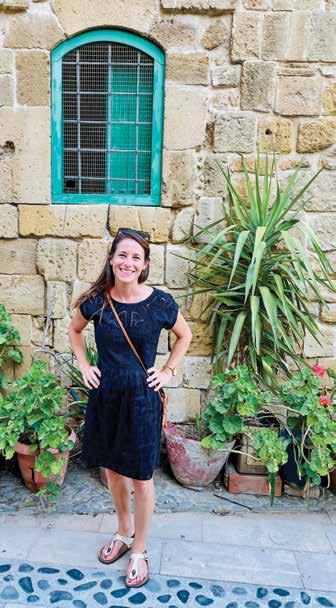
and a failure to provide basic services such as continuous electricity and potable water. In March 2019, citizens marched under the rallying cry 'the country is burning,' as its triple-digit inflation rivaled that of Venezuela. By 2020, the onslaught of a global pandemic and finally, the Port Blast on August 4, 2020, left the city a shell of its former glory. It is not shocking that I was met with a touch of skepticism when sharing my interest in pitching my tent in Beirut for the summer.
“Maybe you came here because the Cedars of Lebanon are mentioned 103 times in the Bible?!” This was the routine question of the many interviews conducted from the driver seat of taxi cabs as I traversed the country. I came to understand that the cedar meant far more to the Lebanese people than what I could glean from the emblem on their beloved flag. This tree is a galvanizing symbol for strength and resilience in all circumstances. Lebanese artist Alice Mogabgab said that the cedar tree is 'the only shelter in which the Lebanese can find peace.'
Trees are some of the oldest living organisms and, in the Ancient World, trees were the source of life. In the cradle of civilization, all of life took place on and in the land. For a region characterized by “wilderness,” essentially desert, it is no wonder that where trees flourished, water flowed, and that these were the most sacred of spaces.
The abundance of cedar trees connected Lebanon to the vast trade networks of the ancient Silk Roads and furthered empires of the ancient world. The durable and fragrant timber was crafted into merchant vessels by the Phoenicians. The ancient Egyptians, with highly sophisticated rituals to honor the dead, carved elaborate sarcophagi from the wood and used the resin for mummification. 19th c. French historian Alphonse de Lamartine claimed, “The Cedars know the history of the earth, better than history itself.”
Far from the olive trees of Cyprus, I found myself standing in the Kadish Valley of Northern Lebanon, confronted with the aptly named Cedars of the Gods. An otherworldly enclave surrounded by ancient giants ever green, one can hold all the complexities of life with both hands. Soil and sky. Light and dark. Broken and whole. Insecure, fully known. Grieving and hopeful. Here and not yet. I closed my eyes. As if on cue, a stanza from a long-ago memorized Wendall Berry poem sings over me:
Slowly, slowly, they return
To the small woodland let alone:
Great trees, outspreading and upright Apostles of the living light. Patient as stars, they build in air. Tier after tier a timbered choir, Stout beams upholding weightless grace Of song, a blessing on this place.
I stood in awe of these trees towering above me and allowed their outstretched boughs to direct my gaze to their infinitely larger Creator. I was made small in their presence, but they, too, are
but a speck in the expanse of Creation. I marveled at their existence, and I wondered about the throughlines of their story. What wisdom would these ancient trees offer to God's people who we see exiled in the unfamiliar territory of the Babylonian Empire in this morning's reading? What wisdom would these ancient trees offer to us? Here's what I've gathered:
First, Cedars are rooted, flourishing exactly where they are planted. Cedrus libani is one of four species of its genus. Common name, Cedars of Lebanon, these coniferous trees grow in the arid climate of the Eastern Mediterranean. They are the southernmost Cedar population found in Lebanon, Syria, and Turkey at elevations between 4,000-6500 ft above sea level. They soar to heights ranging from 65-90 feet. The deep-running root system of the Cedar is perfectly suited to the rocky soil conditions. The trees are healthiest when their sweeping branches have room to spread. The Psalmist tells us these trees flourish because they are planted “in the house of the Lord.” “In His courts,” God's people find boundary lines that fall in pleasant places even in exile. We, too, can acknowledge that all earthly terrain is at least vaguely foreign when eternity is written on our hearts.
Second, Cedars are only satisfied by the provisions of their Maker.
Cedar trees grow on high, rocky outcrops spectacularly thriving amidst harsh weather conditions and rugged terrain. As such, they are dependent on humans for neither cultivation nor caretaking. No, it is the God of creation that tends to them! They are fully known and cared for. “Full of sap”—more simply stated in the original Hebrew text as “ever full”—cedars are satiated; they have just what they need.
The people in exile are told to build houses, live in them, plant gardens, eat from them. Essentially, keep doing life. Pray to the Lord and trust that your immediate welfare is tied up in His overarching plans for you and all
of creation. As we begin to embrace our own dependence on our Maker, we can sink into a deeper rest and are freed from anxious toil. We can be joyful and committed where we are—even in exile. We are not overcome by our circumstances but, rather, we are held by a God who promises more than the present reality.
Lastly, Cedars are upright and generative, thinking beyond the present and bearing fruits that outlast themselves.
These hardy trees are known for their longevity, typically a 300 year lifespan, although some are thought to be nearly 1,000 years old. There is a humility in their unique growth pattern. Cedars mature slowly, growing just 20 inches in their first 20 years. Pyramidal in youth, cedars grow vertically for many years before spreading into their more recognizable broad, densely needled canopy. It's reminiscent of the vertical reconciliation required between God and man before man can have horizontal peace with his neighbors. In uprightness, the cedars declare that God is their Rock. In their humility, they can contribute to the flourishing of an ecosystem of which they are only one small but integral part. God's people in exile are told to add to the faithful generations thinking beyond their individual lives and circumstances,
instead adding to the collective story. I'm reminded of the brilliant Baroque composer Bach. He wrote at the end of every single piece of music, “to God be the Glory.” He had a sense of his smallness and yet he contributed to something much larger than himself. Maintaining a right perspective, he stewarded his gifts to offer the generations beyond him a canorous glimpse of a restored creation.
The Cedars remind us that we are part of a much greater story. The trees garner wisdom over centuries and outlast the cultural influences of both the Babylonian Empire and the empires of our present age. And, while our current culture would beg you to believe it's all about you, It is not. The Cedars tell a different story: we are small and still God invites us to be a part of His great story.
Amidst the brokenness I encountered both in myself and my surroundings, I was overcome by the glimmers of hope I witnessed in the ways that people celebrated each other, welcomed me a stranger—in, planted, reaped, remained rooted as Cedars by a promise that was fulfilled on another great tree.
I pray that on your own journey you will find the rest and the freedom that comes from the blissful awareness that you are very small and that God is boundless in mercy and provision. In our greatest trials and our greatest accomplishments, may we joyfully proclaim “to God be the Glory.”
Knowing that our “smallness”is a part of something greater—”a timbered choir,” an exiled people who are still called to live on the land toiling together, planting gardens, while we wait for a day when, like the snow finally melting in Narnia, we will gather 'round an eternally abundant feast where all of creation—yes, even the Cedars—are clapping their hands in a collective 'Hallelujah.'
To God be the Glory.
The Cedars remind us that we are part of a much greater story. The trees garner wisdom over centuries and outlast the cultural influences of both the Babylonian Empire and the empires of our present age.
What could be better at the Upper School, than a solar charging station for cell phones? Senior engineers Abhay Mathur, Joshua Moore-Davis, and Anish Kohli were excited to take on the task of researching charging stations for the school to purchase. They filled out an RFP (Request for Proposal) for Christina Graham, buildings and grounds program manager, and ultimately concluded that buying one ready-made was not the way to go.
During their research, they came across some DIY solar powered charger projects, both large and small. They realized companies were charging very high prices for the housing, because the components could be
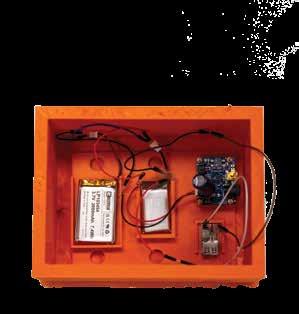

bought for a fraction of the cost. They determined that it wasn't worth spending lots of money for the housing on a product without guaranteed warranties.
Abhay, Joshua, and Anish asked if they could build a prototype and present their findings. They gave Ms. Graham a list of core parts they would need and she procured them. Most of the parts were sourced from Amazon and others were designed and 3D printed in the Steam Lab. The resulting prototype is able to charge an iPhone.
In December they presented their findings and their prototype to a committee that unanimously approved the project to build a solar charging station!

The
Inspired by how valued her teachers made her feel, Dania Lee decided in second grade that she was going to be a teacher. She loved creating math tests for her friends, and in her senior year of high school she volunteered every day in a classroom at a local elementary school. She began her career as a kindergarten teacher but after a break to raise her family, she joined the SSSAS Middle School as a math teacher. Dania and husband David—who got engaged after only seeing each other eight times—have four Saints, Rainier '18, Ashlyn '20, Calysta '23, and Carmyn '25! Dania was born in sunny Southern California, the youngest of three siblings and 21 cousins. She grew up in a family that wasn't allowed to fight, so she wrote her complaints in her diary. In Middle School her family moved to Bellevue, Washington, where they lived next door to Bellevue Square, aka “the mall,” which she says explains why she feels so comfortable at Nordstrom—her second home. Dania is energetic, kind, patient, and hard-working. She has participated on four committees; helped run the Student Council Association, the Math Club, and Penmanship Club; directed two academic summer camps; and she provides math support to the Academic Center and the Study Club. She is inspired by her students, who have taught her about grit. She admires how they just pick up, dust off, and keep on trying when they encounter something really challenging. When she needs to find peace, Dania turns to her Bible and her faith. She's a planner. Every Sunday she bakes and cooks a ton of food that provides meals until Thursday. She's not a quitter. She likes sitting on the sofa to binge watch shows on Netflix, and sometimes stays up until early morning to finish a season. As a teen her parents encouraged her to watch Korean dramas to learn about the culture and she still loves them. Her top three favorites are “Crash Landing on You,” “Mr. Sunshine,” and “Twenty-five Twenty-one.” And last, but not least, she is cheerful and charming. Otherwise, she would never have been allowed to join her husband's sister and groom on their honeymoon cruise through Italy, Greece, and Turkey!

If you could wake up tomorrow having gained any one quality or ability, what would it be and why or what would you do with it?
Extreme multitasking. I would do everything. At the same time.
What are you obsessed with?
Skincare. I wear sunscreen every day even though my classroom has no windows.
For what in your life do you feel most grateful?
My husband. I never dreamed I would get to be married to a man who I respect and admire more than anyone and who loves me as much as he does. I'm crazy about him!
If you had a million dollars in the bank, what would you be doing?
I'd stop worrying about how to pay for putting four kids through college and then pay for their weddings.
What is something one of your parents said that you will never forget?
We were rolling kimbap (Korean rice rolls) and mine turned out too loose. My mom said, “They taste better when they are loose like that.” I rolled the next one so tight it was about to burst, and my mom said, “They look so pretty when they are rolled tight like that!” I could do no wrong in her eyes.
What was one of your funniest moments at SSSAS?
My first year of teaching, I had a class of seventh grade boys who were a rowdy bunch, but also hilarious. A couple of times, I knew I was supposed to scold them, but I couldn't stop laughing. I tried so hard to hide that I was laughing, I put my hand on the board but my shoulders were shaking. One of them said, “Look what you did. You made her cry!”
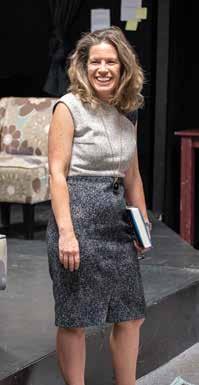
In October, Amy Argetsinger '86 visited the Upper School to talk about her career in journalism, her new book, and her experiences as a student at St. Agnes. In addition to addressing the community, Amy spoke to a smaller group of student-writers and the student Women's Affinity Group. Amy was introduced by her St. Agnes English teacher, Dr. Roberta Klein, who shared that Amy was one of two students who signed up for the very first Creative Writing class that she taught at St. Agnes. “It's challenging to teach a course with only two students,” Dr. Klein said. “Each day I would have the two students exchange papers so that they could critique each
other's work. Amy always got the same critique from the other course member: 'Gee, Amy, this is so good!'”
Amy was a good writer. She was an Echols Scholar at the University of Viriginia, where she majored in political and social thought and also edited one of the college's weekly newspapers.
After graduating from UVA, Amy started her journalism career in Illinois. In 1995 she joined The Washington Post, covering the Marilyn suburbs, higher education, and the West Coast. In 2005 she was appointed with Roxanne Roberts to write the Style section column, “The Reliable Source.” Today, Amy is the editor of the Style section.
One year ago Amy published her first book, “There She Was,” a history of the Miss America Pageant.
SSSAS was thrilled to host our annual Middle School Diversity Conference on November 11. Twenty-six student facilitators engaged with more than 120 students from all over the Mid-Atlantic region, as they explored what it means to go from well-meaning to well-doing.
Three Upper School students, Danielle Pascale '23, Gigi Smigel '23,

and Kalli Dinos '24, presented their work creating and launching Danielle's program, Reach for the Stars.
Inspired by a book she read in fifth grade, “Runaway,” Danielle has long been concerned about children in the community facing financial and housing instability. After learning about the social entrepreneurship process with the LearnServe program and getting hands-on volunteer experience with the Mother of Light Center, Danielle decided to start her own program to lessen the mental and physical impacts of child poverty and homelessness. With the support of Mother of Light, $230 of startup costs, and a cohort of 15 students, Danielle launched Reach for the Stars on July 12, 2021.
Parents reported the program helped their children relax, have fun, and gain useful skills for the upcoming school year. The program also allowed the parents, who can't afford childcare, to work and run errands. After the successful debut, Danielle reached out to Lower School Librarian Julie Esanu, to enhance the program's quality of reading instruction for this year.
In its 31st year, the Normandy French Exchange resumed with a visit for the French students in November, after a two-year Covid hiatus. The students joined some classes, toured D.C. landmarks, learned the basics of football, watched the fall play, and bonded with their Saints counterparts. Our Saints will head to France during spring break, spending two nights in Paris and a week in Bayeux, Normandy.

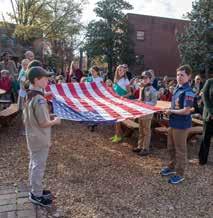
On November 10, our Lower School welcomed nearly 40 service members— current Saints parents, grandparents, alumni, colleagues, and relatives of colleagues—for a special chapel honoring Veterans. The service included a magical homily delivered by Lower School parent retired Col. Christie Walton, participation from SSSAS Girl and Boy Scouts, and music. After the chapel, all members of the Lower School and their guests proceeded outside for a flag raising ceremony and recitation of a Veterans Day poem.
Vice Admiral John Mustin '85 was also in attendance and spoke to the fifth grade about leadership before leaving to address the Upper School, speaking about his service and the importance of the holiday. He also met with three seniors who plan to attend the US Naval
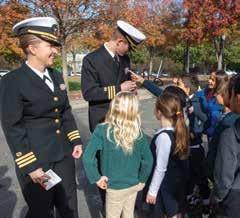
Academy next year and had lunch with the Saints for Veterans Club.
John's parents Hank Mustin '50 and Lucy Holcomb Mustin '55 were both Saints, as well as his three siblings: Kay Mustin Miller '79, Tom '78, and Lloyd '77. After graduating from St. Stephen's, John attended the U.S. Naval Academy, where he earned a bachelor of science in weapons and systems engineering and was commissioned in 1990. He also holds a master of science in operations research from the Naval Postgraduate School and a master of business administration in finance and management from Babson College.

Affiliating with the Naval Reserve (NR) in 2001, John has served in multiple staff and command positions, including as the NR Chief of Naval Operations for Operations, Plans, and

Strategy and as the inaugural Littoral Combat Ship (LCS) Navy Reserve Enterprise Director responsible for the reserve manning, training, and equipping of the 1000-billet LCS surface reserve force, and vice commander of the U.S. Fleet Forces Command.
John currently serves as the 15th Chief of Navy Reserve, leading approximately 59,000 Reserve Component personnel who support the Navy, Marine Corps, and joint forces.
His awards include the Defense Superior Service Medal, Legion of Merit, Meritorious Service Medal, Navy Commendation Medal, Navy Achievement Medal, Navy Battle Efficiency 'E', Military Outstanding Volunteer Service Medal and various service, expeditionary, unit and campaign awards.

What is your most treasured memory?
I saw Stephen Sondheim sing and play my favorite song of his at a benefit concert in New York a few years ago. Seeing this mythic genius who had influenced so much of my life was a very human, transformative moment.
What are you obsessed with?
Double Chocolate Almond Flour Cookies from Trader Joes.
What is the best piece of advice you've ever gotten? Always show other people grace and remember their humanity.
What is something that you pretend to understand when you really don't? Football.
Never in his wildest dreams did D.C. native Sean Finan imagine himself teaching fifth grade, but it was lurking in his DNA. Both of his parents taught and modeled curiosity and a lifelong love of learning. Sean's early dreams stemmed from family trips to see all the Broadway plays. At the age of six, seeing “The Phantom of the Opera” awakened an obsession with the allure of live theater. Sean's desire to be onstage was replaced by a passion for directing at Guilford College, where he discovered the magic of breathing life into a piece with a team of collaborators. Armed with a bachelor's in theater studies, Sean did something he sees as crazy in hindsight. He moved to New York City to study at NYU, but without a clear understanding of all that would entail or a strong plan for after graduation. As it is for many people who move there, he found life in NYC to be a bit overwhelming, but he persisted and stuck it out. Two years later, he returned to the quieter, more palatable vibe of D.C. with a master's in educational theater and started teaching. Like theater, Sean finds teaching to be both challenging and deeply rewarding. He claims there's nothing like the instant feedback he gets from his students— just like an audience—to keep things exciting! Sean readily shares that he was an incredibly anxious and unfocused student, who would do anything to avoid tackling a long chapter in a book…until musical theater and Shakespeare opened his eyes to literacy and the wonder of reading. Today he has a master's of education in literacy studies and is the lead literacy coordinator for third through fifth grades. Sean now dreams of bridging the gap between his two passions by creating a curriculum for musical theater that would open students' minds about language, music, dance, and historical context. Sean's favorite thing in the world? The musicals of Stephen Sondheim, which he claims taught him how to use language to create a picture and give a character depth. During the summer, Sean directs musicals at the Adventure Theatre Musical Theatre Center. In his free time, you might find Sean reading, going to the theater, taking long walks with friends, or listening to music that tells a story, like Adam Melchor, Brandi Carlisle, and Ben Howard. When they watch TV, Sean and his two cats, Jem and Scout (yes, from “To Kill a Mockingbird”), gravitate to watching historical documentaries—as long as they weave a good tale.

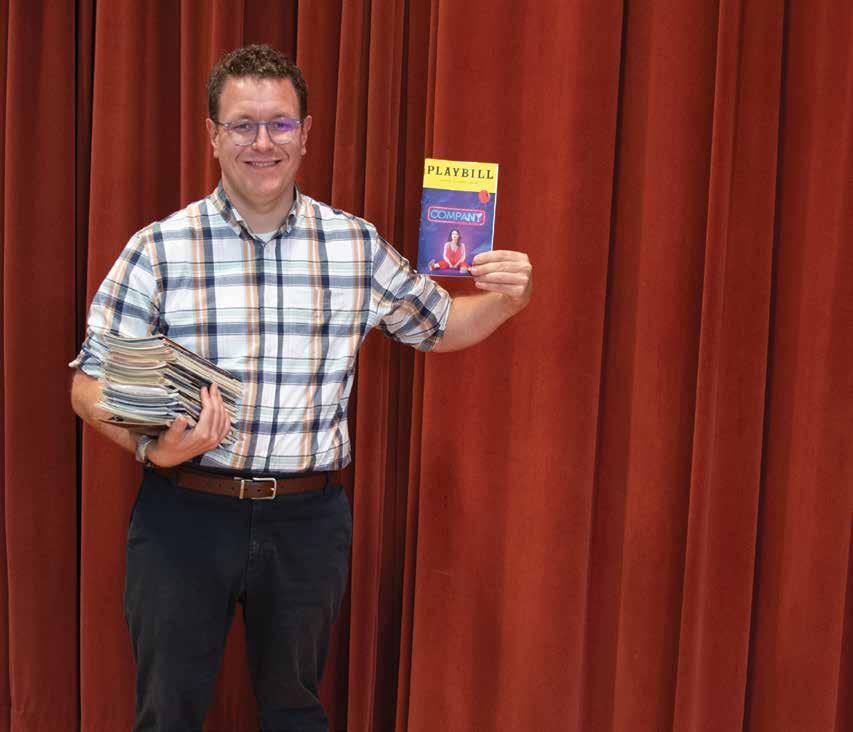
What is the one place in the world you would like to escape to?
London! I love it.
What is the best compliment someone can give you?
“Thank you for listening to me. I really felt heard.”
What in life makes you smile?
My 5th Grade Team. Caitlin Engelberg, Jon Lamkay, formerly Mollie Tolman, and now Erin Lee. They are so hardworking, collaborative, smart, and funny!
Reflecting on her 37 years as an Upper School English teacher, Dr. Roberta Klein is proud of teaching her students to think critically and write well. She is also famous for making them read “Beowulf,” Chaucer, and Shakespeare and inspiring her students to love them! Why are they relevant? Because “'Beowulf' encapsulates the Old English worldview that 'nothing gold can stay;' Chaucer encourages us to look beneath the surface and think critically; and Shakespeare shows what happens if we lose our moral compass: all in the most exquisite language!” A self-described loyal and empathetic old soul, with a wry Seinfeldian wit, Roberta confides that most people think she is from New York City, but she was born in Texas and completed high school in Florida. After experiencing a few hurricanes, she headed north for college knowing exactly what she wanted to do. She was born to teach. She studied English literature, receiving a bachelor's from Smith College and a master's and a Ph.D. from U Penn, where she wrote her dissertation on Agatha Christie. A devout Anglophile, she estimates that her trips to study in England add up to two years of residence! Her fondest memories include visiting the houses of her favorite English writers, seeing Queen Elizabeth go by in a motorcade, dining with a duchess, and interviewing Agatha Christie's husband, Max Mallowan. To relax, Roberta swims, pampers her cat, and works out with a trainer. She takes classes in acting, singing, creative writing, and ballroom dance. Her TV is usually tuned into a British show, while her playlist includes Gilbert and Sullivan operettas, classic '60s rock, and Broadway musicals. Fun fact? Roberta has an ear for languages and can imitate any accent, which she says may come from watching “Rocky and Bullwinkle” as a child. What five authors would Roberta invite to dinner? With a sparkle in her eye she says, “I would love to chat with Chaucer and Shakespeare, and hear Chaucer read from the General Prologue of 'Canterbury Tales!' Having grown up reading 'Gulliver's Travels,' I've always considered myself to be a Jonathan Swift groupie, though he would take sadistic pleasure in antagonizing the other writers. I feel a deep rapport with Agatha Christie; she's very shy, though, so I'd have to entertain her alone. Would I dare to invite the melancholy Edgar Allan Poe and ask him about his misogynistic portrayals of women?”
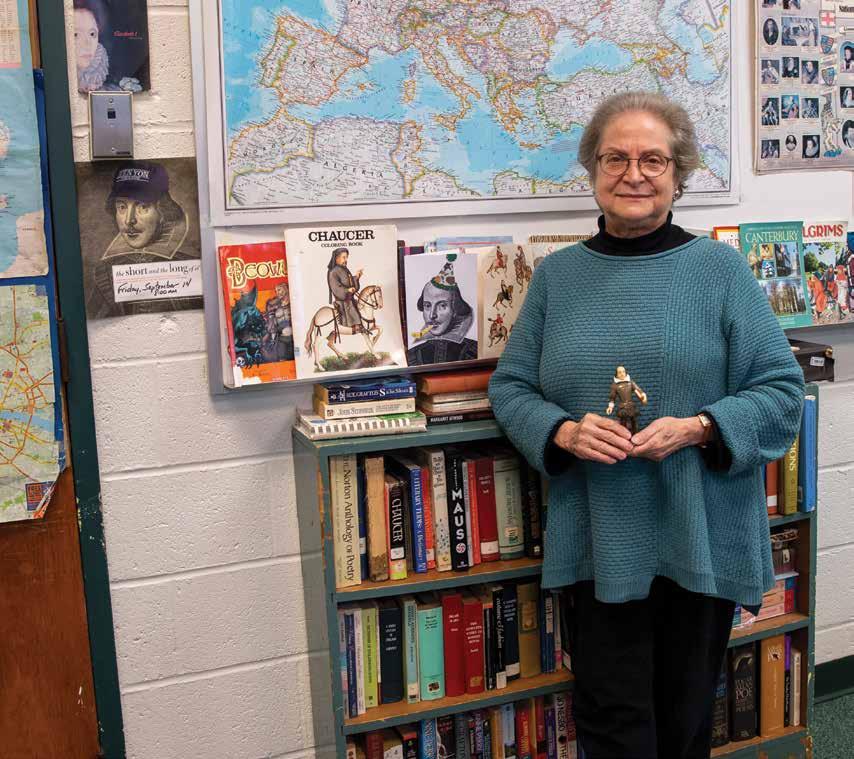
What is something you could happily fail at?
Singing solo. I'll never have the volume or breath control to sing well solo, but I would happily fail at this task on the off chance that someone in the audience might enjoy or even be moved by my singing.
If you could wake up tomorrow having gained any one quality or ability, what would it be and why or what would you do with it?
I would love to be fluent in every language, ancient and modern, both for reading and for travel. Imagine sitting down and reading The Odyssey, the Bible, Don Quixote—all in their original languages, or being able to chat comfortably with anyone on earth. Pipe dream!
What is the best piece of advice you've ever gotten?
I've always loved this observation from Thoreau: “If a man does not keep pace with his companions, perhaps it is because he hears a different drummer. Let him step to the music which he hears, however measured or far away.”
What one piece of advice would you offer anyone who asks?
Figure out what you do well and love doing best, then do it!
When did you first really feel like an adult?
When I got my job at St. Agnes, I had to leave my casual grad student life at UPenn, move to Alexandria, buy a house and a car. My parents helped me out financially, but with the responsibilities of a “real” job, a house, and a car, I suddenly felt like an adult.
What is something one of your parents said that you will never forget?
My father often quoted this advice from William Penn, which I have taken to heart: “I expect to pass through life but once. If, therefore, there be any kindness I can show, or any good thing I can do to any fellow being, let me do it now, and not defer or neglect it, as I shall not pass this way again.”
In October, 47 Upper School Performing Arts students and five faculty members headed to New York City for an amazing weekend of Broadway plays, concerts, Q&As, and workshops with a variety of professionals.
Everyone saw “Into the Woods” and “Beetlejuice.” Theatre students had an additional opportunity to chose between “Funny Girl,” “The Kite Runner,” or “MJ the Musical,” while instrumentalists saw a concert and vocal students saw “A Strange Loop.”
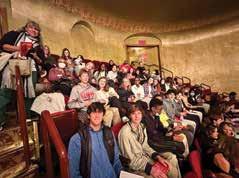
The trip also included a panel discussion with four performing arts professionals, an oboist, an actor from “Beetlejuice,” a stage manager, and the vocal coach for Broadway's “Harry Potter and the cursed Child.” The panel discussion was followed by a hands-on workshop with the vocal coach in vocal work and accent training. The students also attended a demo and Q&A given by a professional teleprompter operator and independent filmmaker, who spoke about working on programs like “Last Week Tonight” and “The Daily Show,” as well as the process of writing her own films, getting them produced, and touring the film festival circuit.
This trip is a highlight each year for the performing arts students and a beloved Saints tradition!
Honors Chemistry students worked to identify an unknown metal through measuring various trials of mass and volume to calculate the density and observe its physical and chemical properties. After the lab, they spent time doing research to identify what the metal was and write a lab report to justify their choice.

On October 6 SSSAS held a Blessing of the Animals in remembrance of St. Francis of Assisi at the Lower School amphitheater for our entire school community. Dogs, cats, rabbits, lizards, and more were in attendance. The pups enjoyed some lip-smacking treats!
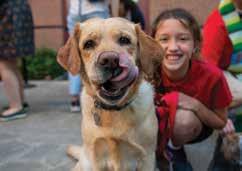

In October third grade Saints represented SSSAS at the MidAtlantic Episcopal School Association's (MAESA) annual Celebration Service at Washington National Cathedral. More than 500 students, faculty, and staff from 11 area Episcopal schools participated in the service. Students processed with school banners, offered readings and choral performances, and joined in prayer for our fellow MAESA schools. Our Saints were thrilled to celebrate the commitment and culture of Episcopal schools at this event!
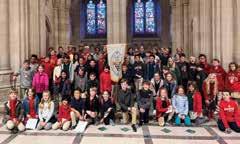
Seventh graders worked in teams to create “Mason Jar Ecosystems.” The teams had to consider which biotic and abiotic factors would best replicate the local ecosystem in their mini models. Students then monitored the changes in their selfcontained ecosystems as part of the ongoing ecology lessons.
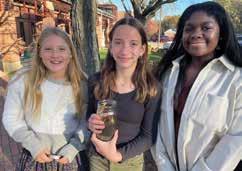
This fall Upper School Stage One, in collaboration with the smART team, presented Caryl Churchill's “Love and Information” under the direction of Upper School English Teacher and Theater Director Valerie Carlson. This play—with a cast of 25 playing 100 parts and a crew of nearly 20 running the lights, sound, sets, props, and costumes backstage—is a wildly inventive exploration of the complexities of contemporary life; how we navigate our relationships with each other and try to make sense of what we feel and know. “Love and Information” was first presented by The English Stage Company at The Royal Court Theatre in the Jerwood Theatre Downstairs, London, England on September 6, 2012. The US premier was presented at New York Theatre Workshop, New York on February 19, 2014.
The Director's Notes: Why this play? Why now?
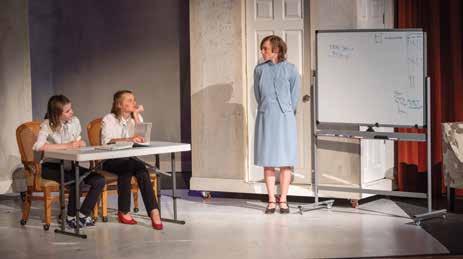
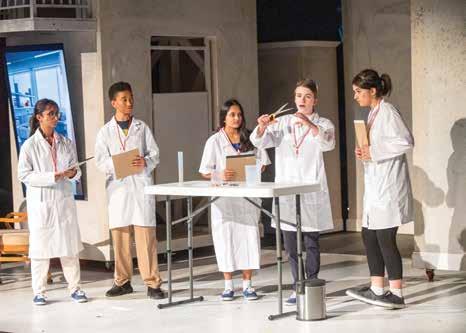
In the fall, Upper School guest speaker and journalist Amy Argetsinger '86 stated, “We crave information. We have to know what's happening.”
Not long before that, Rev. Sean Cavanaugh spoke in chapel about the beauty and mystery of the universe…and of ourselves. He reminded us that we need to have love and compassion for ourselves as imperfect creatures in society that pressures us to be “perfect.”
In her chapel talk, Senior Ali Barrow shared an experience from this summer during which she realized that we all want desperately to be able to make sense of the unknown and control it…but that sometimes we can't, and we have to let go and ride with it.
These concerns with knowledge, emotion, and the sometimes crossed wires that happen between the two are interwoven throughout “Love and Information,” just as they are in our lives. This is a very human play, a play about all of us.
As two characters say to each other at one point in the play, dialoging about what's important in a relationship,
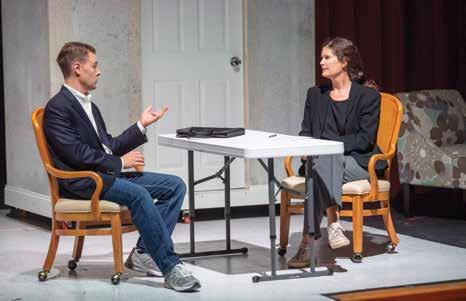
“Information and also love.”
“If you're lucky.”
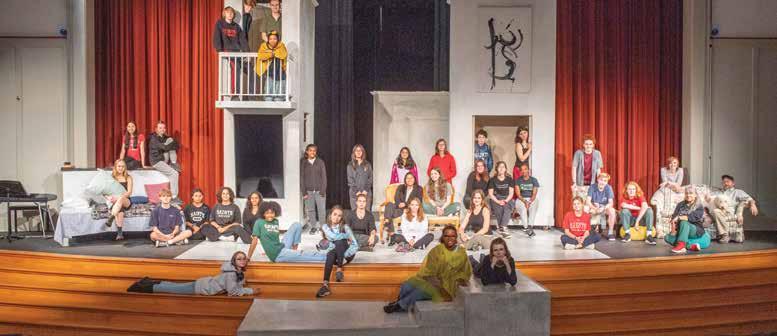
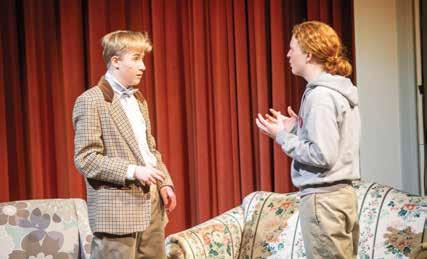


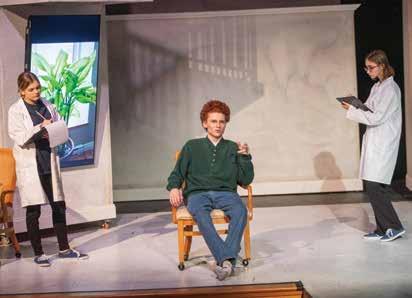
The Lower School always enjoys their annual Halloween Parade. We challenge you to find ten differences in the photos!




First grade scientists used the AR Makr and Keynote apps to design augmented reality habitats. AR Makr is a creative toolbox for augmented reality that allows the user to sketch, scan, and transform their creations from 2D to 3D virtual objects. In November they showcased what they learned through drawing habitat elements and transforming them.
Upper School students in the Intro to Engineering class learned about gear ratios and how to make gear trains that leverage torque over speed. They incorporated these designs into tug-of-war robots for a friendly class competition. They had other constraints that they also had to meet in their LEGO robot design, such as a maximum weight, a maximum number of motors, etc. During the initial competition, students were brainstorming so many ideas on how to make their robots better, they were given a class period to make any significant improvements and a second-round of competition commenced!

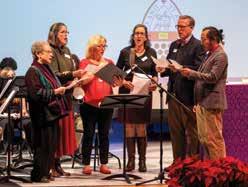
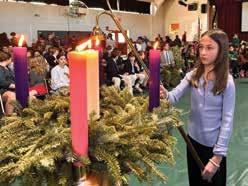

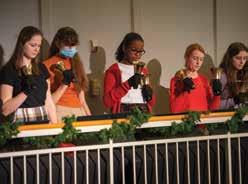
The Lower, Middle, and Upper Schools celebrated Christmas with Lessons & Carols services including readings, musical performances, and of course, Christmas carols. The Lower School service includes a special concert orchestrated by Lower School Music Teachers Rebecca and Matt Gehlhoff. Each grade performs a song between the lessons.

Fifth grade and kindergarten scientists had fun learning about acids and bases writing and sending secret cranberry messages! How does the invisible ink work? The cranberry juice is an acid, and also contains a special substance called anthocyanin. The invisible ink, the base, is a mixture of baking soda and hot water. Students wrote their secret messages with the base mixture, let that dry, and then wrote over it with the cranberry juice to make the invisible message appear.

IAC Championship Meet Finish: 5th
VISAA State Championship Meet Finish: 16th
Max Dague '23 and Dillon Dreibelbis '26 were named All-City for their top 20 performances in the Alexandria City Championship Meet.
ISL Championship Meet Finish: 4th
VISAA State Championship Meet Results: 4th
Alexandria City Championship: Hannah Floyd '25 won the Championship. Whitney Bruch '26, Karina Constandy '25, Hannah Floyd '25, and Emmie Vajda '23 were all named All-City for their top 20 performances.
Milestat Invitational: Hannah Floyd '25 broke the school record with a time of 19:14.
Alexandria Sportsman's Club Athlete of the Month: Hannah Floyd '25
ALL-ISL: Whitney Bruch '26, Karina Constandy '25, Hannah Floyd '25
VISAA Division I All-State: Whitney Bruch '26, Karina Constandy '25, Hannah Floyd '25
Final Record: 3-15-1
Final ISL Standing: 10th
#10 Saints upset #7 Holton-Arms in the first round of the ISL tournament with a score of 1-0.
ALL-ISL: Devon Fogg '23
ALL-ISL Honorable Mention: Abby Musser '24
Final Record: 4-4
Final IAC Standing: 3rd
Final VISAA Standing: 6th
Game winning 43-yard field goal by Carter Stimson '25 with .03 seconds left on the clock to beat Landon on Senior Day.
Alexandria Sportsman's Club Athlete of the Month: Carter Stimson '25
ALL-IAC First Team: Colin Cross '24, Danny Garvin '23, Luke Pascal '24, Justin Stewart '23
ALL-IAC 2nd Team: Xavier Southall '24, Carter Stimson '25, Harrison Thaptao '23
VISAA Division I All-State 2nd Team: Carter Stimson '25, Danny Garvin '23, Harrison Thaptao '23, Luke Pascal '24, Justin Stewart '23
VISAA Division I All-State Honorable
Mention: Colin Cross '24, Justin Hill '23, Willie Jacobs '23, Xavier Southall '24
Final Record: 4-13-1
Final IAC Standing: 5th
Final VISAA State Ranking: 10th
Two 1-0 wins over league and state opponent Episcopal, as well as a hard fought game against Georgetown Prep in the IAC Tournament that the team lost in PK's.
Alexandria Sportsman's Club Athlete of the Month: Rafiki Mwethuku '23
ALL-IAC: Matthew Bezuneh '23, Xavier Johnston '23, Jack Murphy '23
VISAA All-State First Team: Jack Murphy '23
Final Record: 7-6-2
Final ISL AA Standing: 5th
Selected as the #3 seed in the NoVA Girls Soccer Invitational Tournament for the second year in a row.
ALL-ISL AA: Ali Barrow '23, Julia Duvall '23, Campbell Wolff '23
ISL A Division Regular Season and Tournament Champions—undefeated in the A Division!
Final Record: 11-5
Final ISL A Standing: 1st
Final VISAA State Ranking: 5th
Alexandria Sportsman's Club Athlete of the Month: Margaux DeVaul '26
ALL-ISL A: Mikki Taye '23, Margaux DeVaul '26

VISAA Division I Player of the Year: Margaux DeVaul '26
VISAA Division I All-State First Team: Mikki Taye '23
Final Record: 3-13
Final ISL A Standing: 6th
Huge 3-1 victory over league opponent Sidwell Friends on senior night!


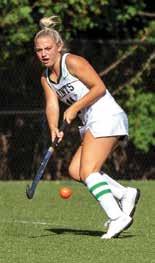

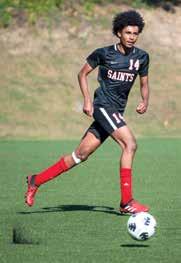
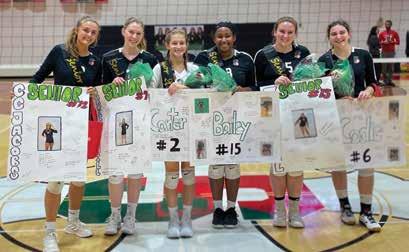
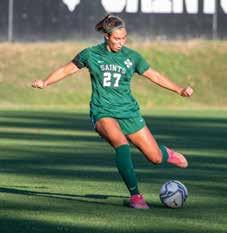

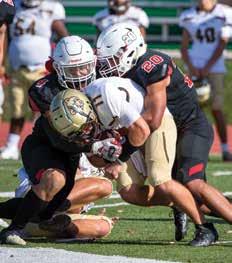
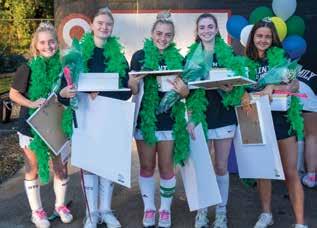


In October 2022, KiKi Davis (Director of Institutional Equity and Diversity), Joe Wenger (Associate Director of Institutional Equity and Diversity), and David Yee (Director of Service Learning and Community Engagement) had the unique privilege of joining the Alexandria Remembrance Project Pilgrimage to Montgomery, Ala. Here they offer their reflections on this powerful experience.
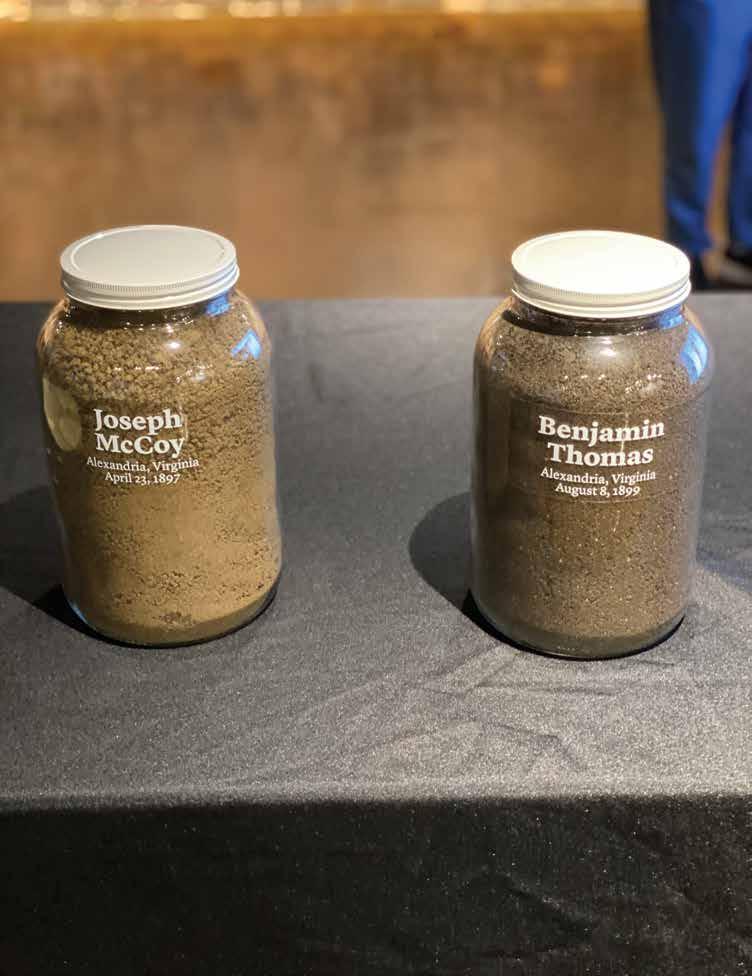
To quote the Alexandria website: “The Alexandria Community Remembrance Project (ACRP) is a city-wide initiative dedicated to helping Alexandria understand its history of racial terror hate crimes and to work toward creating a welcoming community bound by equity and inclusion.”
The pilgrimage was a culmination of years of preparation resulting in the Soil Collection Project, in which soil was collected from Alexandria to commemorate the lives of Joseph McCoy and Benjamin Thomas, two young Black men who were lynched in the city in the late 1800s. On Saturday, September 24, the ACRP held a Soil Collection Ceremony in Market Square, mere yards from where both Joseph and Benjamin were murdered by White mobs. The soil was placed in jars bearing the victims' names. The jars were then delivered to the Equal Justice Initiative (EJI) in Montgomery, where they were added to the hundreds of other jars collected from all over the country for similar reasons. While the centerpiece of the pilgrimage was the delivery of the soil to EJI and time at EJI's marquee institutions–the National Memorial of Peace and Justice and the Legacy Museum–we spent two more days in Montgomery and Selma, Alabama, visiting sites important to the story of the fight for racial justice and civil rights. What follows are the personal reflections of the three Saints that joined the pilgrimage.
I have been a diversity practitioner for almost 20 years; I have been Black all my life. I have worked in and with many schools from coast to coast. I've worked alongside heads of school, board chairs, school psychologists, Ph.Ds, leaders, and teachers from almost every discipline. I have also
experienced small town USA where I was called the N-Word at nine years old, followed in department stores on more than one occasion, told to go back where I came from, and admonished that I should be grateful for being allowed to be in my own country. In my many decades of life I have been treated with bias and indifference both professionally and personally. Trauma is not new to me. Dissecting and compartmentalizing my experiences has also become a skill that I have mastered over the years in order to be the best of who I need to be at work and at home.
So I knew that this trip, whose purpose was only a part of why I chose to participate, would impact me both professionally and personally. Yet, I admit that what I experienced for four days in Alabama, I could not have predicted or prepared for, from the National Memorial for Peace & Justice to the Legacy Museum to a day in Selma. My metamorphosis— from acknowledging myself first as an equity educator, then as a program participant, and finally to a descendant of the racially terrorized whose legacy still impacts so many— evolved meticulously until they were no longer independent identities, but an amalgamation found derelict of proper preparation.
My reflection of this trip far exceeds the time and space allotted in this article. So I will focus on one day, knowing that it was the aggregation of all of the experiences that made this trip transformative.
We arrived in Montgomery before the majority of participants, which I was told would be 160 strong. So my first glimpse of the contingent was the next morning as we gathered for breakfast before our first excursion to the memorial.
My heart immediately felt full as I looked upon the faces of so many of
my community elders. In that moment, I imagined that what was a dive into history for me and my contemporaries was for them a revisiting of their past, and all the emotions that could and would resurface. I wanted to hold their hand, steady their gait, reassure them that they would not be alone. I had no way of knowing on that first day, that in the midst of such a large group, I would for the most part, feel more alone than I had ever felt before.
The Memorial was powerful, and as I walked the aisles quietly and alone, the realization of what I was viewing hit me like a ton of bricks. The bronze columns that initially stood in front of me then, systematically made their way above me, bearing the names of every county in the United States where a lynching or more of a Black person had taken place. I walked methodically through the rows, reading each name on every column, climbing over barriers and walls so as not to miss a name, not because I knew any of them, but because I wanted them to know, even in their absence, they were seen and that they mattered. Whether
“I knew that this trip, whose purpose was only a part of why I chose to participate, would impact me both professionally and personally. Yet, I admit that what I experienced for four days in Alabama, I could not have predicted or prepared for ” KiKi Davis
the inscriptions were full names, first names, nicknames, or “unknown”, I needed them to know that their life was worth my time. That who they were not able to become was not lost on me. I wanted them to somehow know that in death they were seen, valued, and validated even if, because this memorial existed, they were not in life.
I walked alone for almost an hour, tears uncontrollably streaming down my face. At some point, I stopped trying to wipe them away. At some point, I was determined to let myself feel the pain. I left the memorial with a different purpose for the trip than I had initially planned. Yes, I would make connections and design a similar trip for our school community someday, but in that moment, as the columns faded away in my rear vision, I was determined to let all the parts of me, the professional and the personal, absorb this experience. And that is how the remainder of the trip felt: heavy, like I had absorbed a lifetime of stories needing to be told, a lifetime of pain needing to be understood, a lifetime of resilience and triumph needing to be celebrated.
Back now, amongst my family and friends, I often close my eyes to see those names and remember there is still so much to do.
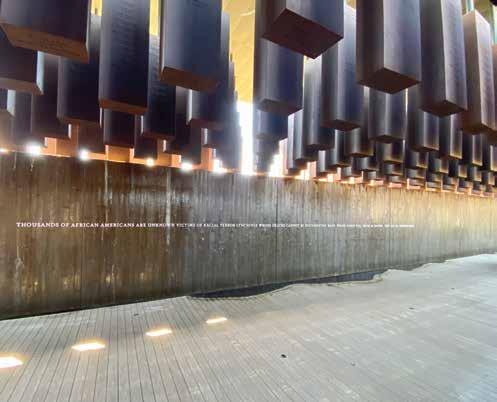
In 2002, the city council of Montgomery, Ala., voted to change the seal of the city. The newly approved seal added a new phrase, “Birthplace of the Civil Rights Movement,” to the former seal which bore the inscription, “Cradle of the Confederacy.” While those two phrases might seem contradictory, they capture well the complex history of that city.
At first, I was overwhelmed by the sheer density of important historical moments that took place in the city. Take, for example, Dexter Avenue, one of the main thoroughfares in Montgomery. The Alabama State Capitol sits at the top of Dexter Avenue. There is a six-pointed star placed on the capitol steps marking the spot where Jefferson Davis was sworn
in as the President of the Confederate States of America. If you walk a few blocks down the hill, you will pass Dexter Avenue Memorial Baptist Church where Dr. King presided from 1954 to 1960. A few blocks further down the hill, Dexter Avenue ends at Court Square Fountain. Prior to the Civil War, Court Square was the main marketplace for the selling of enslaved people, and directly across the street sits the building where they issued the telegram to fire on Fort Sumter and begin the Civil War. And that very same corner is also where Rosa Parks boarded the bus in December of 1955 and sparked the Montgomery Bus Boycott. Today the Artesian Fountain in Court Square is ringed by a Black Lives Matter mural that was painted by Michelle Browder, a contemporary artist whose mother, Aurelia Browder, was one of the named plaintiffs in Browder v. Gayle, which was the case in which the Alabama bus segregation laws were declared unconstitutional. That is the history embedded in just a few blocks on one street.
There is something unique about visiting places imbued with history. For
“I walked methodically through the rows, reading each name on every column, climbing over barriers and walls so as not to miss a name, not because I knew any of them, but because I wanted them to know, even in their absence, they were seen and that they mattered.” KiKi Davis
example, I will never forget visiting the site of a Nazi concentration camp in Austria. Similarly, when I walked into the Legacy Museum Annex on the first morning in Montgomery, I immediately saw the following words printed in large white letters on an exposed brick wall: “You are standing on a site where enslaved people were warehoused.”
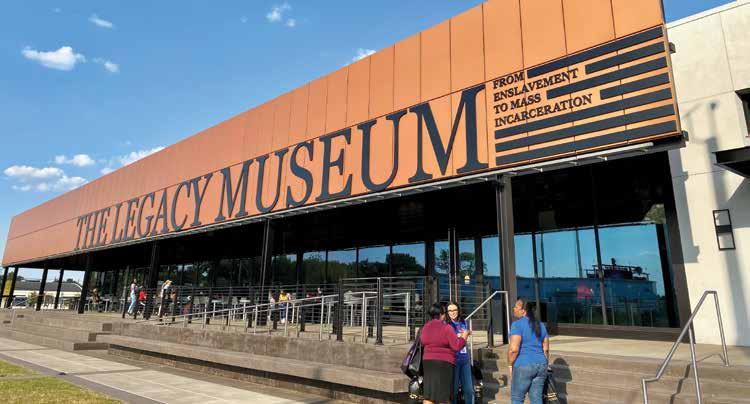
It was a sobering reminder of the dehumanization and objectification of fellow human beings that once had taken place on the very spot where I was standing. I had similar feelings while standing on the front porch of the home where Dr. King and his wife lived during their time in Montgomery. There is still an indentation in the
cement of the front porch where a bomb exploded in late January of 1956, roughly one month into the bus boycott. And visiting Selma produced the same emotional response. Having seen the footage of “Bloody Sunday” many times before, I struggled to comprehend fully what those peaceful marchers went through on that day in

“Having seen the footage of “Bloody Sunday” many times before, I struggled to comprehend fully what those peaceful marchers went through on that day in 1965 as I myself crossed the Edmund Pettus Bridge.” Joe Wenger
1965 as I myself crossed the Edmund Pettus Bridge.
While I am still processing what I saw and what I learned on this trip, the element that continues to resonate with me more than any is the people we met. To know that Michelle Browder continues the work that her mother started half a century ago is both inspiring and disheartening—inspiring because she is continuing her mother's fight for justice and disheartening because that justice has still yet to be achieved. But the person whose story I will carry with me forever is Lynda Blackmon Lowery. Mrs. Lowery is 72 years old now, but she was only 14 years old in March of 1965, which made her the youngest participant in the march from Selma to Montgomery. To sit down with her and listen to her stories of what she endured six decades ago–losing her mother when she was only 7-years old because the “colored blood” took too long to arrive from another part of the state, arrested and jailed nearly a dozen times by the age of 12 because of her involvement in protests, beaten by state troopers on “Bloody Sunday,” suffering injuries that required 35 stitches in her head–was a powerful reminder that the “arc of the moral universe” that Dr. King spoke of continues to “bend toward justice,” and that all of us have a part to play in making that justice a reality.
As Chip Reed, Chief-of-Staff to the Mayor of Montgomery, put it, there may not be another street in the United States that contains the highs and lows of our country's history that Dexter Avenue does, so it's undeniable: Montgomery and Selma carry enormous historical significance. However, the power they hold is not just in their history. They express power in the present through the people that keep the light these places can shine, and their actions spur me
to remember that action is part of remembrance.
Part of this call-to-action comes from how we found ourselves going to Montgomery and Selma in the first place. Montgomery called to us as an Alexandria Community by reminding us that we have work to do. The Equal Justice Initiative's National Memorial for Peace and Justice seeks to remind us that senseless and unjust racial violence has occurred in much of our country, but its Community Remembrance Project reminds us that the work to address this injustice must occur in the present. This pilgrimage was the start of Alexandria's work in remembering and reckoning with past and present racial trauma, and our presence in this delegation of 160 people was a reminder that SSSAS is a part of this community in its triumphs and failures. Together, what should we do to make sure that nothing like this can happen again? How will we fulfill this pledge to the delegation of Alexandria City High School students who accompanied us to document and hold us accountable for those actions?
But then the other part of this call-to-action emanates from my personal story and journey. I grew up in Chester County, Pennsylvania, and for much of my childhood, I knew and processed race. It was pretty early on in my life when I realized that being Asian-American played a pretty big role in the way that people perceived me. At the same time, this part of me
was never something that was valued as much more than a deficit not worth acknowledging in my predominantlywhite community. It wasn't a problem in Pennsylvania, people would say. It's not the South; that conversation isn't worth having, people would say. This would, of course, contradict many of my own experiences, but over time, I grew to understand that if no one else valued these experiences, I had to find ways to make it less valuable to me in order to survive so I could focus on the things that other people did value: good grades, general charisma and easiness, the stereotypical markers of life and academic success and general “leadership.” Perhaps it's because of this that, while I was surprised to find a marker for Chester County at the Memorial for Peace and Justice, I wasn't surprised I hadn't heard the story of Zachariah Walker who was lynched one town over from where I grew up. It wasn't of value to the people who surrounded me, and so I didn't ascribe value to looking for it. Seeing Chester County's memorial pillar was like seeing an opaque mirror reminder of the county's past, and within that image's recesses, was my own past. By choosing to forget the significance of my own Asian-American experience, how might I have been complicit in the mutual forgetting of another?
These past habits are those I have spent a lot of my life since high school unlearning as murmurs from my own experience, past and present, begged to be considered and valued. I had to unlearn the ways I devalued myself in order to learn that people and their stories contain inherent power, my own included. If I can see the power of my own story, then I am a person capable of seeing the multitudinous power within those I meet and the stories they contain.
This pilgrimage was a reminder of my journey because of how many people I met who contain such multitudinous power. People like Michelle Browder, whose vision has value beyond the cost of copper for sculptures and paint for murals. She
“It was pretty early on in my life when I realized that being Asian-American played a pretty big role in the way that people perceived me.” David Yee
seeks to share her story, bringing young people into the mission of keeping it safe, in order to make sure that we value the contributions of those who had their bodies and freedoms taken from them so that we can have what we call gynecology today. People like sisters Lynda Blackmon Lowery and Joanne Bland who have value beyond what is recorded in books recounting the past, who remind those that travel to Montgomery and Selma that they walk on sacred ground, that even an unmarked playground lot can be the site of consequential history, that we each have a burden to carry back home not just to tell a story, but to tell their story, to act in remembrance of them. They, and almost every single person I met in Montgomery and Selma, changed the way I will see Montgomery and Selma forever. Though the stories they contain hold some amount of pain, and sometimes that pain is immense and unimaginable, I must remember that they are not just places
of past pain, but present potential light to unveil the ways in which the world is known and shaped.
And so, in returning to Alexandria, I must remember that as I process and progress. However, I am only capable of remembering if I know that I am capable of monstrous forgetting. I must remember that remembering takes action, and forgetting is the absence of action, a pillar from and of my childhood's Chester County. As the events of the pilgrimage recede increasingly into the past, I, alongside all of those who live in our community, must know the lessons and stories from the pilgrimage will only stay in the past if we don't value them enough to take action, to keep them in the present. What can we as a community do to ensure that the stories and lessons and values of all those in Montgomery and Selma remain in the present where they belong? What can I do to keep their lights burning brightly?
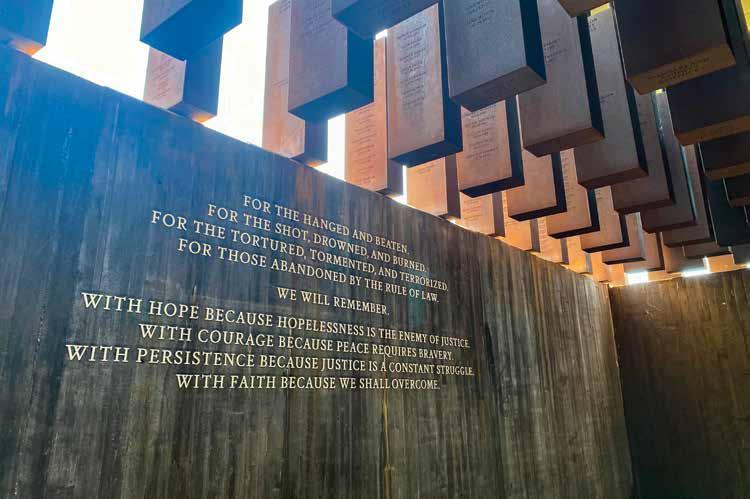
“As the events of the pilgrimage recede increasingly into the past, I, alongside all of those who live in our community, must know the lessons and stories from the pilgrimage will only stay in the past if we don’t value them enough to take action, to keep them in the present. ” David Yee
As the constraints of the past two years ease and we enter back into the world with more confidence, our students have started moving their efforts back out into the community. The number of student clubs dedicated to keeping our neighborhoods clean, going to student conferences like Model UN, or raising awareness of environmental and social causes has grown with the possibility that students can meet and work with people beyond the walls of our school. As a result, the relationship between our school and the community around it is strong and vibrant.
The commitment that our students have to making the world a better place did not cease during the pandemic. They were on the ground level, packing meals for people who did not have access to food, providing social interaction over Zoom or in-person to those who needed it, and more. One of those enterprises (highlighted in the fall 2021 issue of The Saints Life), senior Danielle Pascale's “Reach for the Stars” after school program, is even looking to expand and establish chapters at other area schools. She and her co-leaders, Gigi Smigel '23 and Kalli Dinos '24, presented to our Middle School Diversity Conference, an event that draws middle school students from across Virginia and the DMV. They told their stories and challenged those in attendance to work with each other to create opportunities to make a positive change in their communities. Though these students faced the enormous challenges posed by the pandemic, they never shrank from the challenge.
They were not alone amongst our students. This piece highlights six seniors who took time over the last four years to use their passions and talents to make the world around them a better place.
peers, but he was convinced that more people at our school needed to see the bay's watersheds to understand what needs to happen for the bay to thrive.
Over the past two years, amidst the pandemic, Matthew has worked to share his story and message with his fellow students. He has led dozens of cleanups of local Chesapeake Bay Watershed sites, including Dyke Marsh Preserve and Holmes Run Stream, providing his peers the opportunity to see the issues firsthand—and the ability to do something about them.

In his own words...
What drew you to work with the Chesapeake Bay?
Growing up in and around the bay, I've noticed the steady decline in health and wellness in the bay. When I got to Upper School, I joined this club and eventually became co-leader and as of last year, the leader.
Matthew has always been enamored of the Chesapeake Bay. As a kid, he and his family enjoyed the outdoor opportunities that the bay provided to fish and be on the water, and generally, to appreciate the wildlife that it hosts. Naturally, he gravitated towards the opportunities the
school provided to learn more about the bay. He credits his Lower and Middle School teachers for continuing that conversation, and he relished in the opportunity to travel with other Middle School students on the Chesapeake Bay mini-course led by science teachers Robert Davis and Kelley Gorman.
Still, over time, he started to notice the threats to the bay's health. He noticed the amount of trash on its shores, and he began to fear for the long-term safety of the ecosystem. In our conversation, he told me that he was thankful to have had the opportunity to travel on the Chesapeake Bay mini-course with his
What is your most memorable moment?
Leading my first stream cleanup last year, just as we were coming out of quarantine. It was a great time! There were a lot of people because it was the first one and people wanted to know what it was all about and log some service hours. It was an overall good experience to lead something like that— and be the head of it.
What is your main takeaway?
That the watershed of the Potomac and Chesapeake Bay is struggling. We hear that every day, but to go to see it
and experience it and try to help it, is a whole different level. Some of my friends have said, “I didn't realize how bad the state of the river was until we went to clean it,” and so it's really impactful to go and do the work to actually fix the problem.
What piece of advice you have for others?
Sure, you can get the information online that the Bay's water quality has gone down by whatever percent, but actually seeing it is a whole other thing. I believe it further encourages people to go out and serve the community. I did that, and then other friends asked, “Hey, do you want to help out at the food pantry?” or other things. I learned helping could pique my interest into helping more. Going out and doing the work helps ten times more than just reading about it on your phone.


When the U.S. withdrew from Afghanistan, people in our area knew that we would have a unique role in assisting people escaping for political
or social reasons to find refuge in a new life. While the U.S. government worked with local nonprofits to provide support to Afghan refugees facing shortages of material resources and housing, those same organizations found it hard to provide the comfort of a community to those who needed it desperately. As US News and World Report documented in its August issue, caseworkers from even the most reputable social organizations were unable to provide a human connection as they were stretched too thin to check in on basic needs.
However, in our school community, several students rose to the occasion to fill in the gap. Charlotte was one of the first students to raise her hand and say that she wanted to lend support in any way that she could. She founded the club “Saints Supporting Refugees” and sought ways to support those resettled in our community. She teamed up with our Book Buddies Club, an organization dedicated to promoting a love of reading at an early age, and Historic Christ Church's Refugee Ministry to create a Saturday “Learn and Play” hosted at our Lower School. This program provides the young kids of resettled families the opportunity to be kids by playing on the playground, reading in our library, working on arts and crafts, and more, while giving the parents an opportunity to socialize with each other and engage with Christ Church's case
workers. Together, they provide a caring community for the children and their families in the program.
What drew you to this experience?
Initially, it was the U.S. withdrawal from Afghanistan. I wanted to do something to help and offer support for the new members of our community. That is what inspired us to begin the Saturday Sessions. The friendships I have built with these children and genuine fun we have together are what continues to draw me to this experience. I love seeing the smiles on their faces, hearing about their weeks, and running around the playground with them; they are always the highlight of my week.
What is your most memorable moment? When the children open up to me. I will never forget the time when one of the young boys began to tell me his story while we were on the swings. Unprompted, he shared his experience with me of coming to the U.S. It was hard not to cry hearing everything that he endured and knowing that he is only 10 years old. I am honored that they trust me enough to confide in me and feel comfortable being vulnerable.
What is your main takeaway?
This experience has shown me the
importance of making connections. While playing with and reading to kids for two hours a week seems so small, it has built friendships that will always be remembered. Just being there to listen to or play with them creates a space where children can feel supported, valued, and welcomed in their new community.
What piece of advice you have for others?
When you work on completing your service hours, try to find an experience that is meaningful to you. As a result, the experience will not only help a cause, but it will also profoundly impact you.
Manav is connected to India and its people through his family. Not only does his family travel there once a year, but his mother, through her Sikh beliefs, instilled in him a conviction that one must do good deeds in the world to
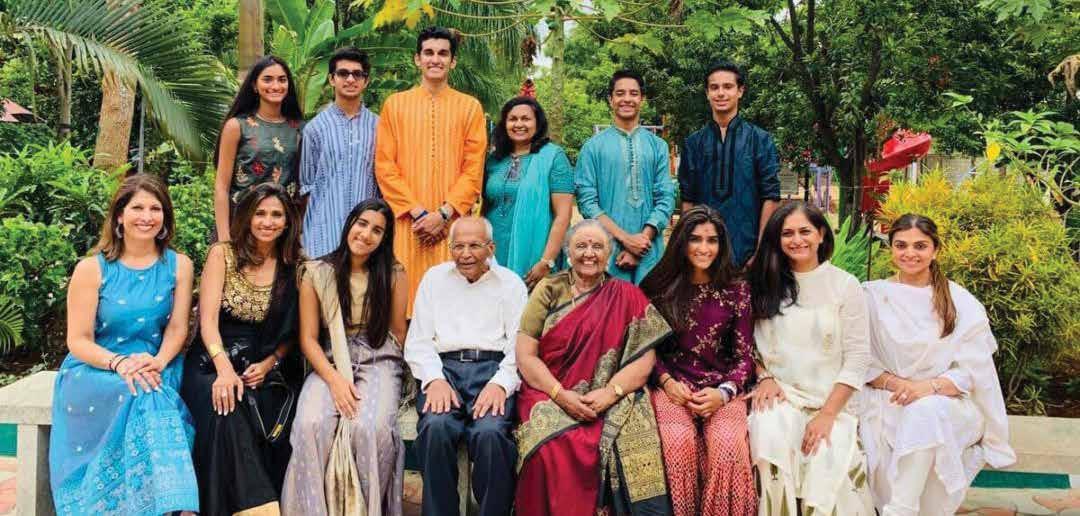
make it a better place. This led him to see his family’s annual trip as more than just a family vacation. He saw it as an opportunity to engage in good deeds himself.
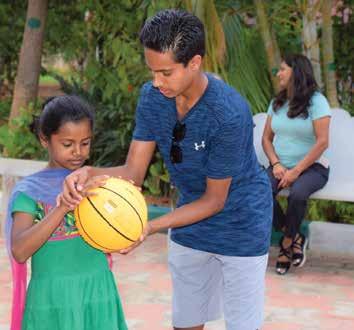
As they traveled to the State of Karnataka and the City of Bangalore, he met the president of Sahasra Deepika, an organization whose name translates to “a thousand lights” and seeks to empower young girls and women to live lives with the social, political, and economic rights to which they are entitled. They do this through a series of schools that admit students whose families work in labor and garment
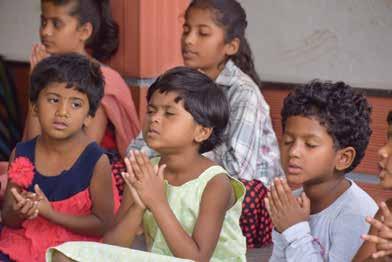
industries, often in single-parent households. Manav spent time working with and mentoring these young girls, and found himself floored by the vision and dreams these girls have and by how much they valued Sahasra Deepika in realizing those dreams. To this day, he still has keepsakes that remind him of their stories displayed in his room.
With the onset of the pandemic, his opportunities to engage with Sahasra Deepika in-person stopped but he did not let this deter his progress. Instead, he used the belief he’d fostered in the power of education to found an online tutoring service that cultivated skills, knowledge, and confidence in STEM. Using the knowledge he gained in Bangalore, he met with experts including professors at George Mason to develop a curriculum for second through eighth grades, and he recruited fifteen college and high school students to serve as tutors. The profits from this program (and also from teaching tennis lessons) went to support Sahasra Deepika’s efforts.
He did not stop there. He went on to serve as a fundraiser for the organization, raising $1500 from a local physician’s group and founding a 501(c)3 to support his fundraising efforts. He launched a GoFundMe that raised over $20,000 through a careful email campaign. For all of his efforts, in October 2021, he represented Sahasra Deepika on “The Today Show” to recognize International Day of the Girl.
In his own words...
What drew you to this experience?
On my family’s yearly vacation to India in 2019, I was introduced to Sarva Rajendra, the current president of Sahasra Deepika (“1000 lights”), a nonprofit that houses and educates 80100 orphan girls in Bangalore, India.
What is your most memorable moment?
During my visit, I interviewed a few of the girls and asked them what their greatest wish was, and one girl’s response remains engraved in my memory today. I honestly expected them to talk about financial stability
or family, but without a moment’s hesitation she said, “Sahasra Deepika to be a part of my life, in every life!”
Initially baffled by her response, I eventually saw the impact education and a tight-knit community had on her, and I knew I had to honor that. I launched my own 501(c)(3) with the goals of education for all, medical care for all, and community creation and empowerment.
What is your main takeaway?
Throughout my work with this nonprofit and my interactions with the girls at Sahasra Deepika, I have learned that adversity was not a disadvantage to these girls. They had aspirations just like anyone else to become doctors, teachers, engineers, and even the prime minister of India.
What piece of advice do you have for others?
They’ve taught me to never be set back by my own adversities, and I hope to share that with the rest of the world.
To learn more about Sahasra Deepika, visit: sdie.org
To hear Codie explain why she decided to work with the Appalachian Service Project (ASP), an organization dedicated to providing safer housing to Americans living in Appalachia, one would think it inevitable that she'd end up helping–not out of desire, but out of inertia. As the youngest member of her family, she has seen her brothers, parents, even aunts and uncles take part in the tradition of serving this organization and its needs. However, the mission of the ASP extends beyond the provision of basic needs. As the organization states on its website, it seeks to help people establish
“meaningful, long-lasting relationships with homeowners, fellow volunteers, and staff.” Their goal is to create a sense of community around the people involved, not just to provide labor for repairs, and Codie did just that. What started as a familial tradition to serve turned into a close relationship between her and the matriarch of the family she served, Sherlene. The highlights of Codie's time centered around Sherlene, the stories she'd tell, and the generosity she exhibited.
Accomplishing this type of relationship is not a forgone conclusion. Codie recounted other members of her group who closed themselves off from this personal impact. In the end, for her, it took a perspective change to see this family tradition as more than doing work–she learned to see the power of seeing people beyond the service and she wants to do more.
What drew you to this experience? This is something that many people in my family have been doing for a long time and they wanted me to experience it. After all of the pictures I had seen and stories I had heard, I knew it was something I wanted to try.
What is your most memorable moment?
When I was painting the door frame to Sherlene's house. She was sitting next to me in a rocking chair telling me all about the people in her family and pointing out things from them on her walls, including very small woven bowls that were extremely intricate and beautiful. Within just a week, this woman felt like family and I could talk to her about anything. Because she was so welcoming to our group and felt comfortable sharing her life with us, it was a really fun and memorable week.
What is your main takeaway?
How grateful people can be for a bit of help and how they can show that gratitude in so many different ways.
What piece of advice you have for others?
You can change people's lives with just one simple act, but the relationships that you make in doing that can change your life. My ASP group spent a week working on a woman's house, and yes, we gained a lot of skills and did a good service, but the most important part was the relationship we created and the good times we shared.
Cooper and his family have lived in Northern Virginia for quite some time, but when prompted to say where home is, they will inevitably say New Orleans. From their fandoms of New Orleans sports teams to the Fleur De Lis displayed prominently on their
belongings and spaces, it's clear to anyone around them that their house may be in the DMV, but in many ways, their hearts are in the bayou.
This is why Cooper jumped at the opportunity to serve as a student leader when SSSAS students traveled to New Orleans this past summer. Not only did he want to share his love for New Orleans with his peers, but he also wanted to lend a hand in lifting a community that means so much to him. Through our school's partnership with Students Shoulder-to-Shoulder—an organization dedicated to providing opportunities for students to grow in ethical leadership by working sideby-side with exemplary community organizations and their leaders—Cooper was able to support those who live in New Orleans and see it in a completely new light.
As he learned, and the effects of Hurricane Katrina have exemplified, New Orleans and those who live there are especially vulnerable to the effects of climate change. Organizations like Common Ground Relief, founded in the


Lower Ninth Ward to provide services to vulnerable residents of underserved communities in the city, have shifted their mission to work on preventing future climate catastrophes. Cooper and his peers had the opportunity to learn about the complex political, social, and racial story that led to New Orleans's current vulnerability, and to lend a hand in making it better by reestablishing Louisiana's natural abilities to resist the effects of sea level rise. They planted marsh grass, tended to urban farms, rescued native iris bulbs that can be replanted to prevent soil erosion, and gained an appreciation for the Lower Ninth Ward.
What drew you to this experience?
Well, with half of my family being from Louisiana, I was super interested to dive deeper into a topic that I wasn't necessarily educated in: Louisiana's ecosystem. I didn't realize how threatened it was and I wanted to learn more.
What is your most memorable moment?
Being in the swamp of Lake Verrett in the water with an alligator, say, 20 feet away from me as I'm trying to plant bulbs. That was the biggest step outside of my comfort zone.

I also loved the ethical leadership opportunities and objectives we had. I loved spending time with my group visiting the city, seeing big landmarks–that we were doing something really good during the day followed by something really interesting in the evening.
I also hadn't been to the Lower Ninth Ward. It was fascinating being in a hostel there and seeing a house across the street that was beaten down by Hurricane Katrina and had never recovered. After always hearing about Katrina, going down to New Orleans and seeing the lasting effects first-hand when we were working in the urban gardens was a major reality check for me, and it was a great learning experience to see what other areas of the world are struggling with. Working in the urban gardens not only felt beneficial for the environment, but also for the people of the Lower Ninth Ward.
What is your main takeaway?
I learned a lot about climate change and how it affects the people. I don't think enough people are concerned about this issue and its effect on the community.

What piece of advice do you have for others?
Before doing service, people should take two steps back and think about what service means. It's not just going in and doing the work. I think learning is more than 50% of service. Yes, you're doing a lot of good by doing the work, but by learning as much as you can, you're able to apply your experience to other opportunities.
Will found multiple ways to serve his community during the pandemic. To speak to the food insecurity many in our
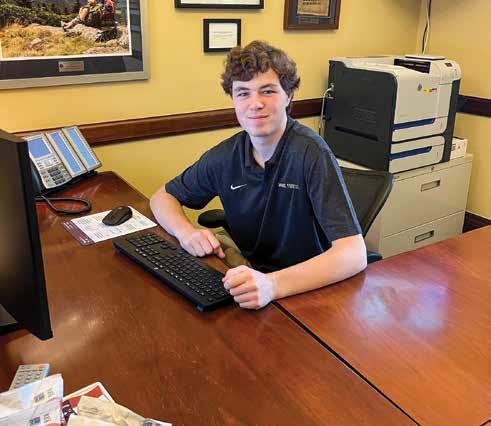
community felt, he packed bags of food for our partner, ALIVE!, one of Alexandria’s most trusted nonprofits. He also pitched in to help Matthew keep the bay clean. However, when the opportunity to serve our country’s government came his way, he could not pass it up. Though it’s easy to miss in the daily buzz of political news, our senators and representatives do more than make headlines on speeches and big policy items. Their mandate includes serving the day-to-day needs of their constituents as well, and as Will learned, the staff behind those who sit in the chambers of Congress is tasked with servicing those needs.
As an intern for Senator Richard Burr of North Carolina, Will saw what a complex task this is, and he learned to love those moments in an office when he could be genuinely assisting people beyond the largescale political ramifications of doing
so. He learned the power of personal moments in a system that seems, at times, wholly impersonal.
In his own words...
What drew you to this experience?
I have always had an interest in politics, and this experience was a very good introduction to that world. This was an amazing internship that gave me an opportunity to serve as well as gain great experience to prepare for the professional world. I was particularly drawn to this service opportunity because it was an interesting chance to serve in an unusual way. I have spent a lot of time in North Carolina, so serving there gave me a chance to connect with people outside of our community.
What is your most memorable moment?
There were multiple memorable moments. A big one being all of the connections and friendships I made, from co-workers and people on the Hill to constituents in N.C. who called daily. I really enjoyed helping people with their issues and providing them with positive solutions. For example, it was nice to have someone tell me they weren’t getting their Veterans Affairs benefits and by the end of the day by working with them and VA the problem was resolved. Really making a positive change in someone’s life felt good and I could see the work that I was doing. These people were very grateful for even the littlest things I helped them with.
What is your main takeaway?
This experience provided me with a much better understanding of all walks of life and introduced me to many different people. By working for a Senator, I was serving an entire state and able to deal with many different issues. It really helped me understand how fortunate I am.

selected SSSAS multiple times,” Jason said. “The role the school plays in character development becomes increasingly important and differentiated as our boys get older.” Jason believes the school's greatest strengths lie in the thoughtful leadership at all levels and the focus on building a community, first and foremost among the students.
“The St. Stephen's and St. Agnes mission statement speaks of a 'complex and changing world.' In particular, I think technology has greatly changed how we perceive ourselves, our immediate community, and our broader world. I believe that a Saints education places an emphasis on understanding and reconciling multiple points of view while still deciding what one believes and advocating for one's position. These skills will be essential for students to navigate and lead in the years ahead.”
Jason Booma is excited to serve on the Board of Governors, as a means of giving back to the school community. “Our two boys, Ben '26 and Luke '29, have gained much by being part of SSSAS,” Jason said. “I want to ensure that future students have the same opportunity.” When Jason and his wife, Suzy, initially enrolled their children, they were looking for an environment that fostered academic learning as well as character development. “As we have matriculated through each campus, we have essentially
Jason has been at Columbia Capital for 14 years. As a Partner, he focuses on investments in the enterprise technology and digital infrastructure sectors. He serves on the Boards of Xtype, Billing Platform, Lemongrass, Mesh-AI, NearForm, Nisos, and 2nd Watch. Previously, he served as a director of Cloud Sherpas (acquired by Accenture), Contino (acquired by Cognizant), and SummitIG (acquired by SDC Capital Partners).

Prior to working at Columbia, Jason was a principal investor with Centennial Ventures. There he was involved with their services and technology investments in Zayo Group (NYSE: ZAYO), Compellent Technologies (NYSE: CML), New Global Telecom (acquired by Comcast), Market Force Information, and TensorComm. Before moving to Centennial in 2004, Jason was a product manager for Level 3 Communications. He started his career at QualNet (acquired by Verio), a start-up provider of Internet infrastructure for mid-sized enterprises.
Jason received a bachelor's in computer engineering from Northwestern University and an M.B.A. from the Kellogg School of Management.
When he's not working, Jason enjoys playing
competitive golf, doing a poor impression of 1970s and 80s rock music on guitar, and exploring the outdoors with his family.
can thrive academically and socially, while developing spiritually. Sabrina believes Saints have a love of learning, a strong commitment to faith, and treat others with respect and kindness. “Actively engaging in education, demonstrating passion and perseverance towards your goals, and leading by example are all attributes that result in collegiate success,” Sabrina said.
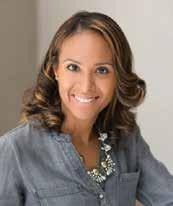
“St. Stephen's and St. Agnes School's greatest strength is our community. The connectedness of the Saints community is truly unique and special. This is foundational to cultivating confident and resilient students.”
Dr. Sabrina Crawford joins the Board of Governors after co-chairing the APT DEIB Committee last year. “Serving on the Board enables me to contribute to the broader school community and leverage my personal and professional experiences to advance our mission, vision, and values,” Sabrina said. “It is gratifying to work with board members who are dedicated and enthusiastic about SSSAS and advancing the strategic plan.” Sabrina and husband Michael chose SSSAS for their sons, Sebastian '33 and Maddox '35, because they feel the school provides an environment where students
Sabrina is energized by the Strategic Plan and looks forward to the continued implementation of educational programming focused on innovation, entrepreneurship, service, and wellness. “It is incredibly exciting for our students to have programming that will help nurture their ideas into tangible products or programs to improve our communities,” she elaborated.
Sabrina provides individual, couples, and family therapy through her private practice in Washington, D.C. “I am passionate about mental health so I look forward to the continued growth of the SSSAS wellness initiative,” Sabrina said. “SSSAS promotes a culture of wellbeing including health and balance in mind, body, and spirit. Building upon these important tenets with robust wellness initiatives will enable our students to thrive in the face of adversity.”
In addition to her therapy work, Sabrina conducts immigration and forensic evaluations. She has worked extensively with domestic and international agencies, including the World Bank Group, International Development Bank, and Pan American Health Organization to provide counseling support
and programs through strength based and resiliency approaches. Areas of specialization in her clinical work include trauma and resilience, anxiety, and depression; issues of culture and race; and acculturation challenges. Sabrina received a bachelor's in psychology from Rider University and her doctorate in clinical psychology. from George Washington University.
At home, Sabrina cherishes spending time with her family and friends, being outdoors, engaging in physical activity, or just playing games. She loves reading fiction that makes her laugh and cry, traveling, and exploring new restaurants.
fortunate to find St. Stephen's and St. Agnes. “We love the school's approach to characterbuilding, its commitment to strong academics, and the nurturing environment that helps each child to grow intellectually and emotionally,” David said. “We attribute this to the amazing administrators, teachers, and staff.”
The Advisory Board Company grew into a leading technology and services provider.
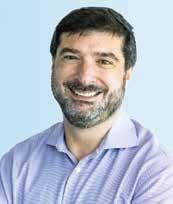
“I believe in the mission and am so appreciative of what the administration and teachers have meant to our children and family. I am particularly impressed by the school's focus on goodness, the whole child, and mental wellness.”
David Felsenthal is returning to the Board of Governors this year, having already served from 2014-2020. When he and his wife, JoAnna, were looking for a school for their three children, Ryan '20, Jake '22, and Abby '24, they felt
David serves as the chief executive officer of EAB Global, an education research, technology, and data-enabled service firm that helps schools support students from enrollment through graduation and beyond. Founded as part of The Advisory Board Company in 2007, EAB has grown to serve more than 2,500 schools, colleges, and universities across the country and around the world. David's areas of expertise include enrollment, people management, strategy and planning, and student retention and success. During David's tenure at EAB, the company has been recognized with numerous awards for its impact on its partners, service to its communities, and commitment to its employees, including Human Rights Campaign Foundation's “Best Place to Work for LGBTQ Equality,” Washington Post's' “Top Workplaces,” The Richmond Times-Dispatch's “Top Workplaces,” and Washington Business Journal's “Corporate Philanthropy by Volunteer Hours.”
David previously served as president, chief operating officer, and chief financial officer of The Advisory Board Company, helping to take the company public in 2001. The company subsequently grew from $70M in revenue and 400 employees to more than $750M in revenue with 3,700 employees across 10 offices and three continents. In addition, from its origins as a subscription research business,
Earlier in his career, David worked in product development and delivery as vice president of eHospital, a company focused on producing health care information and delivering it to patients and providers via the Internet. David also served as director of business development at Vivra Specialty Partners, a private health care services and technology. David holds an M.B.A. from Stanford University, and graduated magna cum laude with an A.B. degree from Princeton University.
When David is not working, he enjoys fly-fishing and taking trips with his family.
schools in our region, and Katherine has become wellacquainted with their heads of school, chaplains, teachers, and administrators. “I've gained a perspective on the very personal and complex work done by people working in Episcopal schools.” Katherine said. “One of the primary goals of my work is to help schools celebrate and express Episcopal identity throughout the school community, welcoming members of all faiths and those with no particular religious background.” In 2023 Katherine will transition to working with her husband Chris Murphy '91 at their family business, M. H. Murphy & Associates, LLC., a full-service tax, accounting, and consulting firm in Alexandria. After receiving a bachelor's in journalism and leadership studies from University of Richmond (Westhampton College), Katherine moved to Alexandria to join Arnold Worldwide and then worked as the regional marketing manager for McDonald's Corporation.
“I believe in the mission of our school, and I respect those I see leading it both as administrators and as fellow governors. I want to be a part of the conversation about the future of our school and believe I can contribute my experiences to that discussion.”
Katherine Murphy is concluding six years as the executive director of the Mid-Atlantic Episcopal School Association (MAESA). The position has provided her the opportunity to work with dozens of Episcopal
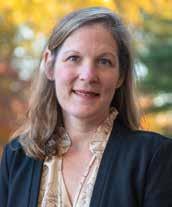
For the Murphy's, St. Stephen's and St. Agnes is part of the fabric of their family and the Alexandria community. As a board member and a parent, Katherine is particularly excited about the Upper School building project. Her sons, Jack '24 and William '25, will be on the tail end of utilizing the new enhanced science and art classrooms, dining hall, and the large community gathering spaces.
Katherine has been deeply invested in the school through the Association of Parents and Teachers, starting with co-chairing the 2014 spring gala. “That volunteer experience provided a doorway into the wonderful Saints parents that makes our school special,” Katherine said. “I continued my involvement with the APT as a room parent, as the Lower School vice president, as an
APT board member serving as the communications chair, and the member at large before being asked to serve as the APT President in 2020-2021.” Katherine has also served as a chalice bearer and on the vestry at St. Paul's Episcopal Church. She recently completed a threeyear term as a member of the St. Paul's Episcopal Preschool Board. Katherine doesn't have much free time and quipped, “When the boys go to college, I will cultivate some hobbies!”
“I am very pleased to serve on the Board of Governors of St. Stephen's and St. Agnes. I love the school, its leadership, and mission.”
Jim Taylor '84 joins the Board of Governors with the deep belief that the Saints community prepares its students by teaching the meaning of trust, integrity, and persistence. “The quiet premise that underlies the honor code at SSSAS is trust, and building trust leads to success,” Jim said. “As a student I learned academic and life lessons from amazingly talented and devoted teachers like Roger Barbee, Jim Osuna, Richard Babyak, Charlie Joyce, Linda Kincheloe, Bob Reed, Fred Atwood, David Checcino, and so many more,” Jim said. “These marvelous and incredibly talented individuals,
like so many of the faculty at SSSAS today, devoted their lives to the development of the whole student. English Teacher Roger Barbee taught me that true integrity means having the courage and guts to confront reality, and Coach Sleepy Thompson gave me the gift of persistence. I believe strongly that real genius lies in persistence, in refusing to give up and in accepting that failure is an important step forward in any journey worth making.” With more than 25 years of extensive commercial real estate experience, Jim serves as the chief executive officer and president at Brixmor Property Group. His passion and leadership are grounded in the belief that the retail community should be an integral part of local daily life. “I most enjoy creating shopping centers that become the 'center' of the community they serve,” Jim said. “Places where people gather, work, shop, eat, and play. When you get it right, you transform the community.” Jim is also a trustee and member of the Executive Board of ICSC (Innovating Commerce Serving Communities), serves on the Executive Board for Nareit (National Association of Real Estate Investment Trusts), and is a member of the Urban Land Institute.
Prior to joining Brixmor, Jim was the executive vice president, chief financial officer, and treasurer at Federal Realty Investment Trust for four years and the senior managing director and head of real estate investment banking at Eastdil Secured/Wells Fargo for 14 years. From 1994 to1998 he worked for Hunton & Williams, a corporate and securities law firm with a focus on equity REITs and from 1988 to 1991 as a senior accountant for Price Waterhouse. Jim received a B.S. and J.D. from the University of Virginia.


Jim lives in Alexandria with his wife Alice and two daughters, Gracie and Mary Lyle. In his free time, Jim enjoys reading and collecting classic cars.
outside of one's comfort zone, to expand individual horizons, to celebrate creativity and original thought, and to not be afraid to take chances.”
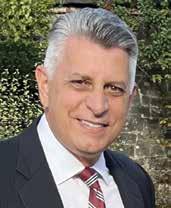
“The school's greatest strengths are its deep and welcoming community, its Episcopalian foundation that celebrates the importance of service, and its inclusivity which endorses a wide range of student interests and creates opportunities for students to not only explore their roles as Saints, but to begin to think about what their roles will be in the world.”
Patrick Dyson '88 feels deeply connected to the school. “I have tremendous affinity for SSSAS and for what it has meant to me and to my family,” Pat said. “The relationships I made as a student at SSSAS continue to be an integral part of my life. I am excited about the direction of the school and welcome the opportunity to give back to the SSSAS community.” In fact, Pat married his St. Agnes sweetheart, Ashley Kincheloe Dyson '89, has three brothers who graduated from St. Stephen's, and four nephews and three nieces who graduated from St. Stephen's and St. Agnes. He believes the school ingrains “the willingness and desire to push
Pat, Ashley, and their two children, Sadie and Julia, live in New York City, where Pat is a partner at GoldenTree Asset Management and a member of GoldenTree's Distressed Committee. Before joining GoldenTree, Pat was a managing director and portfolio manager at UBS O'Connor, handling their credit focused hedge fund and focusing on identifying, researching, and managing investments in all credit products. Pat spent six years at Credit Suisse, where he was ranked No. 1 by Institutional Investor in his sector during his last five years. He received a bachelor's in political science from Middlebury College and a J.D. from the William and Mary School of Law, where he served as a member of the Law Review. Pat was formerly vice-chairman of the Board of Trustees of the Hewitt School in New York City, and he currently serves on the William and Mary School of Law Foundation Board.
Outside of work, Pat enjoys time with his family and friends, playing sports, and traveling.
“SSSAS instills our Saints with strong servant leadership qualities—aspiring to lead and
make a difference in whatever they do and doing so with a passion and a commitment to excellence and diversity. Recognizing that everyone has different backgrounds, abilities, and aspirations.”
Rick Fisher and his wife, Patti, chose SSSAS for their son, Nicholas '25, because they wanted a strong academic environment that encourages students to be independent.
“SSSAS engenders a servant leadership mentality,” Rick said. “Since starting in junior kindergarten, we have watched Nicholas develop in many ways that incorporate important life skills that will assist him well beyond his years at SSSAS. We attribute much of his growth to the great teachers, administrators and staff, who live the mission of SSSAS and convey this passion for excellence to our children.” As a member of the Foundation Board, Rick is most passionate about supporting further enhancements of the school's facilities and academic platforms. “The lessons and experiences learned as a Saint are great stepping stones to the more challenging endeavors in life,” Rick said. “Once a Saint, always a Saint.”
Rick is the current chief executive officer and managing partner of PSP Holdings overseeing its Business Development and Capital Investments Group. Rick and Patti founded the real estate development and restaurant operations company in Alexandria, Va., in 2004. During its 18 years in operation, Rick has overseen PSP Holdings's growth to in excess of $75M in revenues and 700 employees with operations and investments throughout Virginia, North and South Carolina, and Georgia. PSP Holdings
has been recognized twice during the past five years as a top 100 most admired employer by the Charlotte Business Journal.
Rick holds a bachelor's in computer sciences and business administration and accounting from Bloomsburg University of Pennsylvania and his expertise includes real estate development, franchising, and technology investment. He currently participates on the boards of two firms and is an active advisor to several others. He also is a frequent guest lecturer at George Washington University in support of their International Studies MBA Program.
Prior to assuming the role of CEO in 2016, Rick was a sales and marketing executive in a career that spanned more than 25 years for two prominent Fortune 50 technology firms. For nearly 20 years, Rick has also been an active private equity investor, participating in several early stage start-ups in the technology, commercial real estate, and franchising areas.
Rick believes strongly in giving back. He has served on the board of Washington Performing Arts Society and National Capital Area Leukemia and Lymphoma Society and is an active volunteer with activities related to First Book of Charlotte and Communities in Schools of Charlotte, N.C., assisting underprivileged children and their families.
Rick enjoys boating, watching Nicholas play baseball and going to Washington Nationals games. He also occasionally picks up his guitar to relive his childhood dream of becoming a rock star!
“With a deep and long-standing commitment to honoring 'the unique value of each of our members as a child of God in a caring community,' SSSAS is dedicated to building and supporting a culture of diversity and inclusion. As we look to the future, diversity and equity will permeate our curriculum, programs, policies, and hiring practices. We will embrace our role as a leader in fostering a place for all, and a culture of dialogue and action around our world's most complex issues and challenges.”
Natalie Gunn understands the importance of pursuing and maintaining a strong and solid financial foundation, and is very pleased to lend her skills and talents to that endeavor on the Foundation Board. In 2020, the Washington Business Journal named her to their “Women Who Mean Business” list honoring the region's most influential businesswomen. As the chief financial officer for Momentus Capital, Natalie is responsible for formulating and executing their financial road map, capital base expansion, and investor relations. She also manages the overall direction for accounting, tax, audit, treasury, and financial planning and analysis. She has served as Capital Impact's CFO since 2016 and joined
CDC Small Business Finance in the same capacity in 2021. Before stepping into the role of CFO, Natalie served as Capital Impact's controller.
Prior to joining Capital Impact, Natalie held senior positions at the Government National Mortgage Association (Ginnie Mae), National Cooperative Bank, N.A., Capital Automotive REIT, Host Hotels and Resorts, and PricewaterhouseCoopers. She is a certified public accountant and graduated magna cum laude from Hampton University with a bachelor's in accounting.
Since joining the Saints community, Natalie has volunteered through multiple roles in the Association of Parents and Teachers, including recording secretary, Upper School vice president, teacher appreciation chair, and has also volunteered as a room parent. Outside of school, she serves on the board of Pathways to Housing D.C. and the Alfred Street Baptist Church. “Being a Saint means being bold, confident, caring, and supportive of one another–putting your best foot forward each and every day and pulling others up who need a hand to do the same,” Natalie said. “My husband, Rodney, and I chose SSSAS for our sons, Zachary '21 and Bryce '24, because we were drawn to the school's mission to honor the unique value of all Saints as children of God in a caring community—the focus on the whole child and emphasis on being a good person of good character was very important to us.” Natalie's nephews, Jordan '16 and Jonathan Randle '20 also attended SSSAS.
When she is not working or volunteering, Natalie enjoys doing anything with family and friends. She loves the beach, playing board and card games, doing crossword puzzles, cooking, and gardening.

Alumni in the Washington, D.C. area kicked off Homecoming weekend with a gathering at Above ALX in Old Town, Alexandria on September 30.
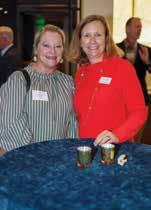

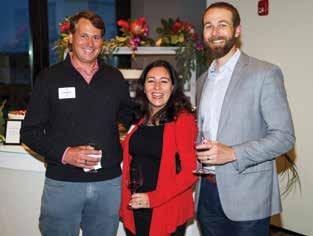
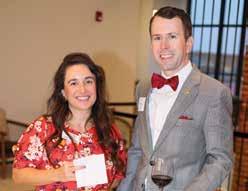






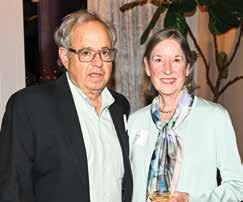
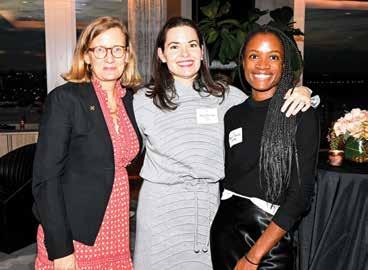
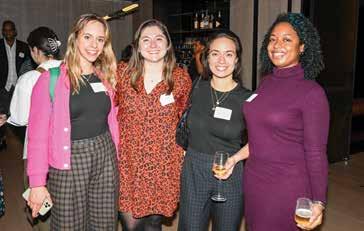

New York Saints gathered at the Electric Lemon at the Equinox Hotel for drinks and hors d'oeuvres on October 6.


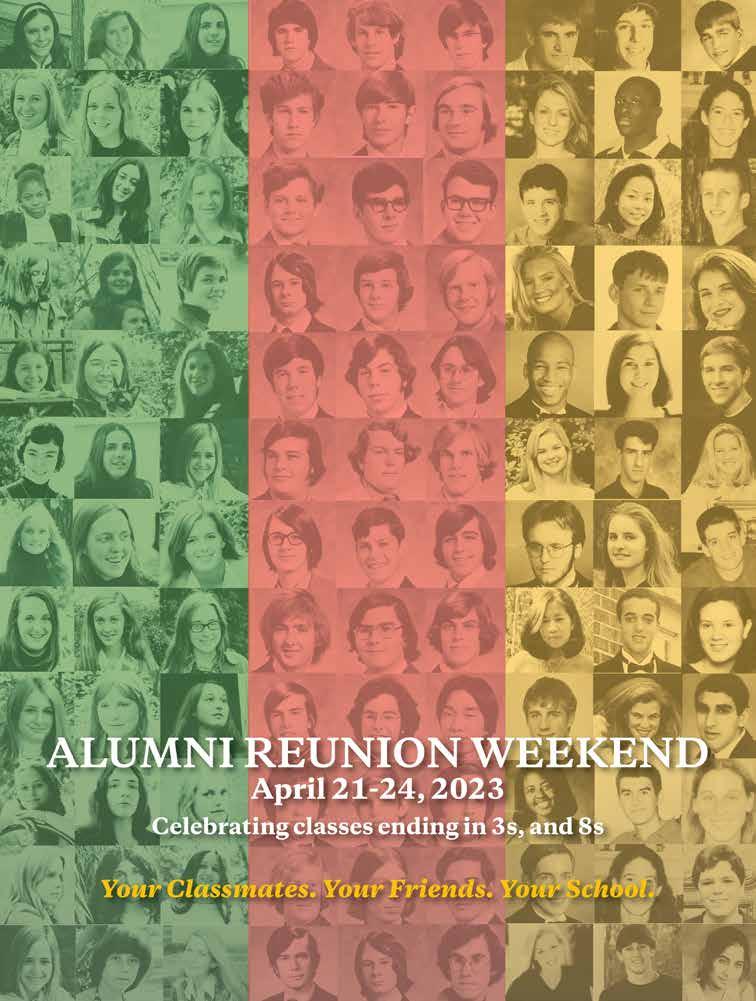
(Listings received prior to October 28, 2022)
Matt Shiroma '01 and Christen Constantino
November 5, 2021
Lydia Denkler '03 and Michael Perrin
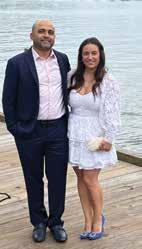
October 9, 2021
Carson Daniel Fifer '03 and London Thor
July 23, 2022
Caitlin Blair '04 and Andrew Fessler
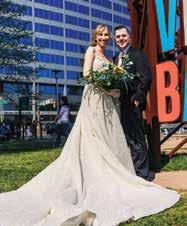
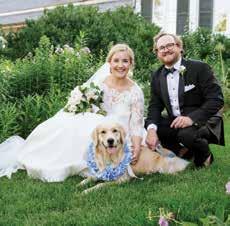
April 10, 2022
Nick Lellenberg '05 and Kaitlynn Glover

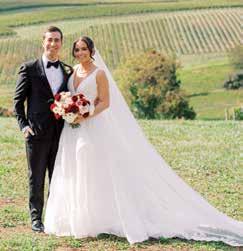
July 1, 2022
Meredith Fifer '06 and Alex Prieu

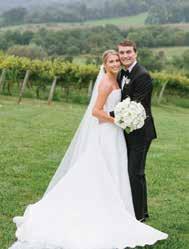

March 19, 2022
Meghan Ames '06 and Kevin Fritz
June 4, 2022
Olivia Knotts '08 and Kurt Ondash
February 29, 2021
Kerrigan O'Malley '10 and Briggs Cocke
June 18, 2022
Claire Niemann '11 and Jeff Starchok
April 16, 2022
Myrna Sidarous '13 and Michael Hanna
June 5, 2022
Alexis Maloney '13 and Hunter Parr
June 18, 2022
Wyatt Whitley '13 and Brendan Nizolek
June 25, 2022
Besser Dyson '13 and Scott Hooper
September 10, 2022
Amanda Tinkleman '15 and Bijan Peters
October 7, 2022
Rachel Jarvis (Chief Advancement Officer) and Kunal Shah
July 7, 2022
Allison James (Senior Associate Director of Constituent Relations) and David Pearl-Schwartz
July 30, 2022
(Listings received prior to October 28, 2022)
Carrie Grassi '94, Luca Sears, July 26, 2022
Nithya Mani '95 and Alex Reponen '95, Sahana Ramani, August 9, 2022
Matt Warshauer '96 and Leah, Audrey Neve, June 3, 2022
Tucker Foote '98 and Gina, George Messenger, July 27, 2022
Ben Roberts '01 and Jenny, Hunter and Tristan, March 22, 2022
Anastasia Morozova '02 and Greg Featherman, Augustus Michael, March 28, 2022




Caroline Edsall Littleton '02 and Judd, Henry John Lawrence, August 29, 2022


Charles Baldwin '03 and Jamie, Jack Gray, April 3, 2022
Meaghan Donohoe Regan '04 and Patrick, Ruth Donohoe, December 29, 2021
Susan Dow Orndoff '05 and Patrick, Cody Isaiah, August 17, 2022
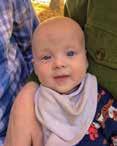

Michael Lewan '05 and Rachel, Brayden Edward, September 23, 2022

Addie Price Martin '05 and Brad, Steele Bradley, September 26, 2022


Micaela O'Toole Thomas '07 and Jared, Tucker, June 20, 2022
Kendall Davis Pessala '07 and Alex, Gibson Frances, August 2022
Liz Palmer Van Wazer '09 and Will Van Wazer '08, Victoria Lillian, October 11, 2022
Rachel Cason Anthony '10 and Jovan, Leo James, July 2, 2022





Grace Pratt (Lower School Chaplain) and David, Emma Cross, April 11, 2022
Anthony Finch (Physical Education Teacher) and Raquel Lockett-Finch, Golden Ali Denise, April 20, 2022
Mandi Sapp (Director of Digital Media and Marketing) and Adam, Barrett Oliver, June 19, 2022
Dionna Jordan (Associate Athletic Director) and Erin Hartman (Assistant Lower School Librarian and Assistant to the Director of Teaching and Learning), Kaia James, July 17, 2022
Former SSSAS teacher and beloved coach Jake Jacobsen died on October 26. Jake, father of Doc '11 and Ally, joined St. Stephen's School in 1989, first serving as a math lab instructor and football coach, and later as a Lower and Upper School P.E. teacher. He coached football, wrestling, and track and field for both the Middle and Upper Schools, and founded the Breakfast Club, an early morning weightlifting and conditioning program at the Upper School. Coach Jake's true passion was demonstrating the life lessons that would help students become better human beings, which many alumni hold in their memory and use daily—a true tribute to his legacy.

When Jake was awarded the Excellence in Education Award by the Alexandria Chamber of Commerce in 1995, his colleagues and students were not surprised by the recognition. “He deeply believes in the subject he teaches and in helping each student work to his or her potential,” shared his colleague, Marsha Way, when he received the award. “He has a neverending love of learning; the patience to work with his students to help them be the best they can be; the wonderful ability to laugh at himself and a situation; and a totally unselfish, caring attitude toward his students and colleagues.”
Jeanne Bullock, former SSSAS Lower School Nurse, died on October 15. Jeanne, husband to Robert and mother of Stacy, Adam '01, and Abby '03, joined St. Stephen's and St. Agnes in 1991 and served our community for 25 years before retiring.

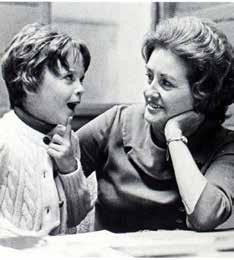
Jeanne was an incredible, nurturing presence at the Lower School for generations of Saints. She cared deeply about this community and she touched the lives of countless students and colleagues. Jeanne was an incredibly warm, calm, and steady presence, which is exactly what you dream of for a school nurse. In times of injuries or illnesses, Jeanne was unflappable, which brought comfort to the students and parents alike. So many Saints parents appreciated Nurse Bullock's warmth and support when she called home to share information about an illness or injury. Jeanne was incredibly conscientious. If something came her way that she was not totally sure about- an unusual rash or illness- she would research it and consult with health professionals so that she could provide the best possible advice and care. Most of the visitors to her office, though, needed simple remedies like an ice pack, a bandaid, or a throat lozenge, but Jeanne knew what they were really
seeking, what they really needed. For with each of these items came comfort and warmth, conveying kindness and calming nerves.
Lee Barber, the former Head of the Lower and Middle Schools for St. Agnes, passed away October 1 at the age of 95. Lee, mother to Amy (SAS'70) and Biff (SSS'81), and grandmother to David '07, Eric '09, and Ashley Jones '17, joined the St. Agnes faculty in 1967, first as a second grade teacher and later as Head of the Lower and Middle Schools. She deeply loved her students and her time at St. Agnes, helping to found Grandparents' Day, as well as the school's first Girl Scout Brownie Troop. Upon her retirement from St. Agnes in 1981, her colleague Bobbi Wright shared the following for the alumni magazine.
“More than any other part of her job, Lee has loved being with the children, and that is the reason for her success with them. Children intuitively know this and respond in kind. Not only has she loved those under her care at St. Agnes, but she has nurtured each one as though they belong to her, and in a certain sense, each has.”
(Listings received prior to October 28, 2022)
Elizabeth “Betsy” Royal Burch '40 October 3, 2021
Julia “Julie” Halloran Rush '45 June 7, 2022
Kathleen “Sally” Spaulding '48 August 11, 2022
Jerre Sass Sultan '50 December 5, 2021
Julian Everly, Sr. '51 January 12, 2021
Louisa “Lisa” Morton Chute '53 May 19, 2022
Susan Haydock Lang '55 May 19, 2022
Sally “Sue” Crommelin-Dell '56 June 30, 2021
Tom Mustin '58
brother of Doug St. Denis '55 , Henry Mustin '50 (deceased), brother-in-law to Lucy Holcomb Mustin '55 , uncle to Lloyd Mustin '77 , Tom Mustin '78, Kay Mustin Miller '79 , and John Mustin '85
July 5, 2022
Eleanor Backus Engh '58 sister of Joshan Backus Wise '61 , mother of Andy Engh '77 , grandmother of Charlie Engh '12 and Catherine Engh '07
August 15, 2022
Terry Kidner '59
July 3, 2021
Lynn Hardy Yeakel '59
January 13, 2022
Loren Needles '60 March 2022
Carson “Lee” Fifer, Jr. '61 father of Meredith Fifer '06 and Daniel Fifer '03 , uncle of Sharon Dewey Cassidy '88 April 21, 2022
Suzanne Rowell Rouland '62
August 1, 2022
Cynthia Pickard McCredie '63 May 7, 2022
Cynthia “Cindy” Hyde Fawsett '66 August 23, 2022
Sarah “Brooks” Cooke Thorn '66 October 2, 2022
Blake Thompson '66 brother of Blair Thompson '68 and Clark Thompson '72 , step-father of Katie Obermiller '98 and Julia Obermiller Byrnes '01
October 5, 2022
Anne Barrett Cole '72 sister of Bill Barrett '69 and Louise Barrett '73 March 12, 2022
Jeffrey “Jeff” Jones '73 brother of Jennifer Jones Embry '71
March 9, 2022
Elizabeth Bancroft '76 sister of Mary-McLean Bancroft Jones '80
July 3, 2022
Kristen Alfriend '95 sister of Caron Alfriend '96 and Bliss
Alfriend Miga '70
June 21, 2022
Raemeka Gant '92 sister of Lela Gant '96
March 15, 2022
Chuck Langdon
husband of Joanie Ferrell '72
December 2021
Elizabeth “Beth” Smith
mother of Powell Smith '83 , Ted Smith '88 , Abby Smith Miller '90 , and Leslie Smith '80 (deceased)
January 26, 2022
Marjorie Abramson
mother of Paul Abramson '69 and Jon Abramson '77 , grandmother of Elizabeth Abramson Nibley '06 , Andrew Abramson '06 , and Jessica Abramson '04
February 4, 2022
Dan “Danny” Tate father of Dan Tate, Jr. '84
March 2, 2022
Maj. Gen. Hal Hallgren
father of Col. Wayne Hallgren '71 and Laura Hallgren Thayer '73
March 5, 2022
Patricia “Pat” Humphrey mother of Mary Jane Humprey Pessaud '86 and Sarah Humphrey
Douglas '83 , grandmother of Will Pessaud '18 and Jack Pessaud '21
March 15, 2022
Ben Bridges
father of Elizabeth “Puma” Bridges Cornick '80 and Ann Bridges '83 , grandfather of Elizabeth Cornick '13 and Keene Cornick '2 1
March 31, 2022
Marianna Taylor
grandmother of Alison Taylor
Henry '02 , Lars Taylor '05 , great grandmother of Drew Henry '34 , mother-in-law of Patty Herter
Taylor '72
April 1, 2022
Douglas Edwards father of Amanda Edwards '89
April 6, 2022
Sylvia Weeks Jones mother of Lydia Jones Nunn '72 and Laureen Jones Mullins '74 , grandmother of Phillip Mullins '07
April 8, 2022
Doris Lindsey mother of Robert “Rob” Lindsey '86
April 9, 2022
Sara “Sally” Bartley mother of Ann Hepburn Webb '80
April 18, 2022
Joan Danzansky mother of Mike Danzansky '87
April 24, 2022
Mary Frances Augst mother of Bobby Augst '95 and Susan Augst Roll '81
April 28, 2022
Dr. Gerhard Lukowsky
father of Andrea Lukowsky '81 , Maria Lukowsky '83 , Tania Lukowsky Bruno '86
May 8, 2022
Nancy Smith mother of Cathy Smith Tyler '80 , Leith Smith '78 , Billy Smith, Jr. '75, grandmother of Rice Tyler '15 , Harrison Tyler '13 , and Chris Tyler '21 , aunt of Buzz Smith '74 and Bette Smith '64
May 13, 2022
The Rev. Dr. Howard Hanchey father of Stephanie Hanchey '86 and Ashley Hanchey Bigelow '89 , husband of Anne Hanchey (former faculty)
May 17, 2022
Dennis “Denny” Meyer
father of Matthew D. Meyer '81, Michael J. Meyer '83, Catie Meyer '86, Peter V. Meyer '88, Denise Meyer Prince '94, and Abigail Meyer '04, grandfather of Luke Peterson '15 and Rita Peterson '21
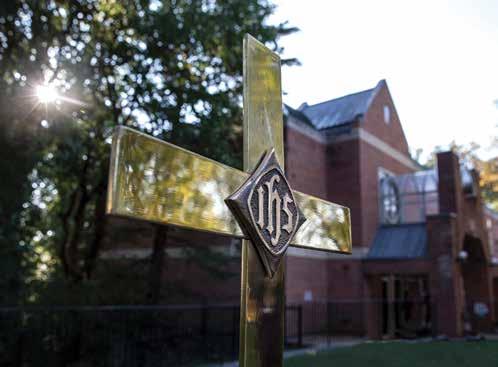
June 7, 2022
Alfred Pavot father of Paul Pavot '85 and Pierre Pavot '88
June 9, 2022
Juraj Ludevit Jan Slavik father of Michael Slavik '82 and Nick Slavik '84
June 10, 2022
Louis Brand “Randy” Rodenerg, Jr. father of Brand Rodenberg '00
June 26, 2022
Mrs. Henry Clay “Odie” Curtis mother of Amy Curtis '80 , grandmother of Clay Kane '13
July 7, 2022
Paul “Skip” Goree father of Chase Goree '16 and Gillian Goree '15
July 8, 2022
Joseph “Joe” Graves father of Lindsay Graves Hernandez '05
July 30, 2022
Rick Reed father of Mackey '06 , Gardner '08 , and Carly '13
August 17, 2022
Katherine “KK” McCart mother of Anna '26 , Caroline '30 , and Harris '30
September 3, 2022
Dr. Samir Azer
father of Adrian Azer '96 and Vivien Azer '95, grandfather of Teddy Azer '28 and CeCe Azer '34, uncle of Tricia Chupkovich Karppi '84
October 8, 2022
Howard Rooks
father of Lisa Rooks Morris '86
October 20, 2022
Suzanne Kleeblatt
mother of Ally ‘26 and Colten ‘28
October 25, 2022
400 Fontaine Street
Alexandria, Virginia 22302
If the addressee no longer lives at this address, please contact the school: 703-212-2720 or atoman@sssas.org
Last year, nearly 500 Saints joined together from across the globe to support St. Stephen's and St. Agnes School with gifts totaling $325,000, in just one day!
Our faculty and staff nurture and support our students throughout their journey at SSSAS with resources made possible by your generosity. Your gift provides the unique opportunities that make a Saints experience extraordinary.
Make your Saints Giving Day gift early at saintsgiving.sssas.org.